

Class A Motorhome vs. Travel Trailer: Which Should You Get?
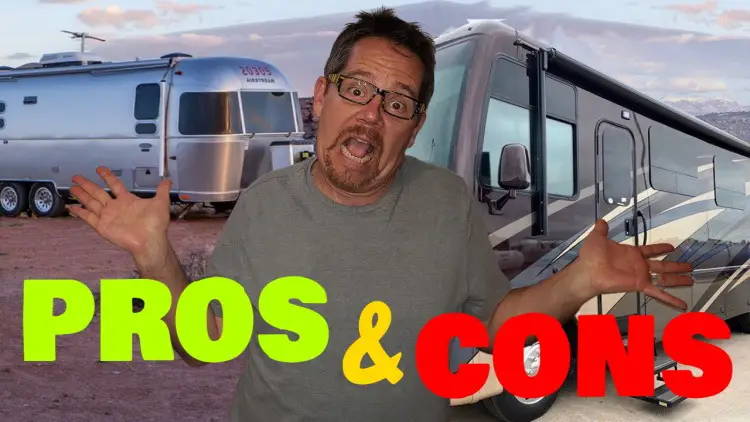
Buying an RV is not a small purchase and something that, in most cases, is a significant financial investment. So, choosing whether to go for a motorhome or a travel trailer can start to get complicated. So let’s compare a Class A motorhome vs. travel trailer.
Here’s what I learned in making that choice:
A Class A motorhome is the best option for large families who travel frequently, while a travel trailer is a good budget option for smaller families that primarily do weekend getaways.
In this article, our goal is to help you understand the difference between the two and, ultimately, help you decide easier.
We will start off by looking at which is better, and then we will go into detail about everything you need to know regarding a motorhome and a travel trailer.
So, keep reading.
Motorhome vs. Travel Trailer– which is right for you? Read Jordan + Brittany’s tips for finding the perfect RV! https://t.co/XdHl74TE0p pic.twitter.com/y2a7EIFnEr — Winnebago (@WinnebagoRVs) May 21, 2017
Are travel trailers better than motorhomes?
In terms of the purchase price, gas mileage, and maintenance costs, a travel trailer is better than a motorhome. However, most travel trailers will be too small for a family larger than 3 or 4 people and they also require a vehicle to tow them.
There is a lot that we can say about this.
There are many different types of motorhomes. Each of them is built differently and offers different experiences. There are many variables and factors that you need to consider when thinking about which is better.
That is why we are going to make 2 different sections.
In these sections, we will discuss whether or not the class A motorhome is better than a travel trailer. Then we will discuss travel trailers vs. class B and C motorhomes in more detail.
https://t.co/Rbg3nT97Ps ranked the best states for RV living based on the weather and access to federal parks. They also list the best RV insurance options to make sure you and your RV are fully protected. Check out the list here! https://t.co/2fkMCQs0Yo #RVLife #Travel pic.twitter.com/DnesdKB87z — Soup2Nuts (@Soup2Nuts0) March 16, 2021
Are travel trailers better than class A motorhomes?
Purchase price aside, a class A motorhome is better than a travel trailer. It provides more bedding and living space options, has a full-sized kitchen and refrigerator, significantly more storage, and often has outdoor kitchen and entertainment options.
Class A motorhomes offer more space than almost any other RV.
That extra space can be increased with slideouts. Also, the class A motorhome has more features than a travel trailer. One of the biggest benefits of a class A motorhome is that your passengers can ride in the home section of the vehicle while you’re driving.
Everything is connected! This just adds a wealth of convenience that can’t be beaten by anything else.
Bring home with you on your next road trip – 5 Best RV Rental Companies https://t.co/sqWEc52Ff6 via @LilFamAdventure pic.twitter.com/RrFS22IWIH — Margarita Ibbott ~ @DownshiftingPRO (@DownshiftingPRO) March 18, 2021
Are travel trailers better than class B or C motorhomes?
A Class B motorhome is better than a travel trailer in terms of safety and the ease of driving it. A Class B motorhome will be better than a travel trailer for families of 4 or more people. The travel trailer’s biggest benefit is the low purchase price.
A travel trailer offers more space than a class B motorhome . It also offers a lot more features. A class B motorhome is relatively small. The RV will be entirely built into a van. This means that it is usually the smallest type of RV.
When it comes to travel trailers vs. class C motorhomes, things get slightly different.
The similarities between a class C motorhome and a travel trailer are quite stark.
The one major difference is that the travel trailer can have its trailer detached if you want to. On a class C motorhome, the trailer is attached to the body of the vehicle permanently.
In terms of space and features, they are similar.
Do you prefer class A, B or C ? 👀 #naturecoastrv 🌲• #motorhome #fifthwheel #toyhauler #traveltrailer #travel #camping #glamping #classb #vanlife #lifeontheroad #fulltimerv #tinyhome #rv #rving #rvlife #dealership #flordia #homeonwheels #instatravel pic.twitter.com/jmjbjJBWbv — Nature Coast RV – Crystal River, FL (@Nature_RV) July 16, 2020
How long will a Class A motorhome last?
A Class A motorhome can drive up to 200,000 miles or last up to 20 years before needing major repairs or engine replacement if it has been consistently well-maintained and serviced.
But when it comes to almost any vehicle, you don’t generally use age as a factor when discussing how long it will last. Instead, you need to use the number of miles that it will drive.
Eventually, the vehicle’s mechanical components will start to give in.
And if you don’t conduct scheduled maintenance, damaged parts will often lead to more damage. It would be best to have a booklet that tells you when your scheduled maintenance is. It will state when you should do your maintenance for every few thousand miles that you drive.
But even then, driving it too infrequently can be just as bad as putting a lot of miles on it. RVs are meant to be driven, and just like people, a lack of movement can cause big problems down the line.
In terms of the living section of your motorhome, that will last for as long as you maintain it.
In the living section, you will start finding that your plumbing or the electricity and just about anything might start giving in. You will have to replace almost everything at some stage. However, if you replace broken components with quality ones, your living quarters should last longer than the vehicle.
You also need to consider that any wood will start to chip and give in, and as long as you just keep an eye on that and sort any problems out as soon as they start, the interior will last long.
The good thing about the inside of your class A motorhome is most of the time, this stuff is just DIY.
Yeah 4×4 is defeated by ice so helping where I can. Rv travel trailer helps the mind set of preparedness. Hopefully you can help this rv float some day. pic.twitter.com/6fAHMV690N — John Galt (@CitizensColumn) February 18, 2021
How long will a travel trailer last?
A Travel Trailer can go for 20 years or 200,000 miles or more since most of the mechanics of driving a travel trailer are handled by the truck towing it. The tires, axels, and electronics will need occasional replacing or servicing, but a travel trailer can last indefinitely if well maintained and properly stored.
But again, for this section, we are going to use miles more than years.
It is very easy to say that your travel trailer “will last x amount of years”, but that is a disingenuous answer. It is disingenuous because it depends on how much you drive and how well you take care of the vehicle.
You need to know what the recommended service intervals are for your vehicle. You can find this in the booklet that comes with the vehicle.
Another thing to consider is the way you drive and the terrain that you regularly drive on. This can increase or decrease the mileage that you can expect to get out of the vehicle.
In terms of the trailer itself, this can last for as long as you maintain it. You will have to replace a few parts, and you might have to get your plumbing, and your electricity fixed every now and then.
Also, you will have to replace some of the items inside of it, like the beds, the microwave, fridge, and stove .
The interesting thing about travel trailers is that it is easier to replace only the vehicle and simply hitch the trailer onto the new vehicle. This can increase, significantly, the lifespan of the travel trailer.
Wife and I just decided to buy an RV/Travel trailer and travel instead of settling down in one spot. So excited! pic.twitter.com/sgEgGlaLH9 — Nic (@nicsusername) October 5, 2020
Can passengers ride in a travel trailer while being towed?
It is illegal for people or animals to ride in any camper that is towed behind another vehicle. The primary reason is that, no matter how safe modern tow hitches are, there is a good chance of the trailer coming loose in the event of an accident.
When comparing motorhomes against travel trailers, this is one of the biggest cons of the travel trailer.
While the travel trailer still offers you the mobility of being able to travel across the country and, in some cases, across borders, you can’t do so in the same comfort.
Honestly, this is one of the reasons my wife and I decided against both travel trailers and fifth-wheels.
Our family of 5 and our 2 dogs would just be too crammed into a pickup, even if we got the largest pickup truck available. Remember, in many cases, campers drive 4-6 hours a day in between destinations on long camping trips.
That’s a lot of time spent in the close quarters of a truck.
This rv travel trailer and a fifth wheel #Camping #RV pic.twitter.com/bC2hZHsbzQ — Julian (@Julian24294407) October 25, 2020
Is it dangerous to ride in a travel trailer?
It is dangerous to ride in a travel trailer while it is being towed. Aside from not being legal, if the truck towing the trailer was in an accident, the tow hitch could fail and cause the trailer to flip. Unlike vehicles, travel trailers aren’t built with road safety features in place to protect occupants.
Most RV veterans will tell you that safety is a priority and that you need to consider it wherever you go. That is why in this section, I am going to give you a specific answer and a long answer.
You hear people say this all the time “well, I am a good driver” or “I am very aware while on the road”.
Maybe, as a driver, you could be one of the best out there; however, even though you can account for what you are going to do on the road, you can never predict what other people will do.
Let’s say that there is an accident that was out of your control and is caused by another driver. If this happens, the people in the trailer will not have the necessary safety features that a vehicle normally has.
You also have to consider that sometimes, something can happen that is not accident-related, and you will not know about it because you are not connected to the trailer. A passenger can be in trouble and might not be able to get to their phone to let you know that something is wrong in the back.
It is best that you avoid these types of situations.
2018 Newmar Essex 4531 | Luxury Class A Motorhome – RV Review: Camping World https://t.co/FZt2j8TNC0 pic.twitter.com/KuPcz5zI5y — Panamá Camping Park (@PanamaCampingPk) June 8, 2018
What is the price difference between a Class A RV and a travel trailer?
The price range for a new Class A motorhome is between $90,000 to $250,000 or more with the average price being $150,000. Travel trailers start at $10,000 with the average price being $35,000.
But this is a very broad question because you get your average mid-range motorhome, and you get your average mid-range travel trailer.
You also get the more premium versions of both but what we can say is that motorhomes are generally much more expensive than travel trailers.
So, you could say that the price difference is roughly $50,000 to $80,000. However, that is not taking into account premium and luxury class A motorhomes.
On the more premium side of things, a premium travel trailer will cost you around $70,000 to $80,000. A premium class A motorhome can cost a few hundred thousand dollars all the way out to a few million.
Therefore, it is difficult to know the exact price difference between the premium versions of both.
Picking up our first RV/Motorhome in a few days! pic.twitter.com/6moOA45MLZ — Steve Wozniak (@stevewoz) December 18, 2020
What are the pros and cons of owning an RV?
Because there are so many different types of RVs out there, it can be tricky to talk about the pros and cons because you would have to list almost every type of motorhome and every brand as well.
A quick example of this is to use the fact that you can unhitch a travel trailer and then have your normal vehicle to travel around with at your destination. This is a pro for travel trailers. For a class A and C motorhome , this is a con because you cannot do it.
In this section, we will talk about the pros and cons of owning an RV in general. Some of these might change for you depending on what RV you own.
Pros Of Owning An RV
Here is a shortlist of pros that come with owning an RV:
- Comfort: Almost nothing quite beats being able to go on vacation and be comfortable while out on the road.
- Flexibility: Owning an RV can eliminate the rush you might find yourself in when trying to meet deadlines for the airport and for booking into your hotel. If you want to stop over somewhere, you can. Are you running a bit late? No problem, owning an RV means you are flexible.
- Experience the country: While out on the road, you can experience America in a way that you could never have before. You can take any turn that you want to. At any time, you can turn off somewhere and experience what life is like there. You can find different attractions that you have never heard of before.
- Creates bonds and memories: RV trips are one of the best ways of spending time with your family and creating memories while doing so.
- Make money : Most places that rent RVs don’t own the RVs they rent. They are owned by people just like you and me. They simply give that business the right to rent out their RV when they aren’t using it. They do take a cut of the rental, but they also handle maintenance and provide year-round parking for it.
10 of the best destinations for the RV in the US. It’s time to start planning! @RVLife @VisitTheUSA #VisitTheUSA #RVLife https://t.co/sFzr9pzsmJ via @GoAwesomePlaces pic.twitter.com/Q4mVIKtp9x — Diane Capri (@DianeCapri) March 16, 2021
Cons of owning an RV
Here is a list of cons that come with owning an RV:
- Storing an RV can be complicated: When you are not using your RV, the ideal situation would be to keep it parked outside your home. However, this isn’t always possible, mostly due to homeowners associations not approving of this. So, you would have to find a storage facility where you can park your RV.
- Maintenance can be expensive: When talking about maintenance, we are mostly referring to the vehicle part of the RV. Unfortunately, servicing an RV is more expensive and servicing a vehicle. It actually costs a lot more and can become rather expensive.
- Gear and accessories: You can find yourself spending a lot of money on gear and accessories. For example, if you are going to RV in a very cold destination, you would need to buy gear to help keep you warm. That is just one example but trust me, after a while, the amount of money you spend on gear and accessories can be high.
- Mobility at your destination: You may think that RVs make you more mobile than anything else. That is partly true; however, when you reach your destination, you might find yourself having to rent out a car if you want to get to some places. This is because driving your RV around everywhere can become cumbersome.
Traveling with those you care about makes the journey worth it! #rv #travel #family #friends #vacation #motorhome #campervan pic.twitter.com/crdvF94SWg — RVnGO (@RVnGOcom) February 25, 2021
Is a class A RV safer to drive than towing a travel trailer?
A Class A motorhome is safer than a travel trailer. RV safety is determined both by whether a vehicle is being towed or towing another vehicle, but also by the wheelbase. Towing adds a layer of risk while driving, but the wheelbase ratio on many Class A RVs will be better than that of a trailer and truck combined.
To determine the wheelbase-to-length ratio of a motor home, just divide the wheelbase by the length of the vehicle.
According to RV Consumer Group , a wheelbase ratio below 51% is extremely dangerous. They go on to note that :
- 51% to 54% is not great for basic safety
- 55% to 56% is OK
- 57% and above is considered excellent
Generally speaking, the higher the wheelbase-to-length ratio the safer it gets.
With a travel trailer, it just gets more complicated since they just have 1 set of wheels. So you have measure the distance from the trailer’s wheels to the back truck wheels and then divide that by the total length of both vehicles.
While Class A RV’s aren’t usually great in terms of wheelbase safety compared to Class B or Class C RVs, they are often better than travel trailers and fifth-wheels.
The 45-foot luxury motorhome is the most expensive one at this year’s Calgary RV Show and Sale. It’s called the American Dream, made by American Coach. https://t.co/GWcBdQHpWV pic.twitter.com/NtVQ3ctFEd — Hemet Valley RV (@HemetValleyRVs) February 17, 2018
What is the safest RV to drive?
Class B motorhomes are the safest RV as they do not tow or require towing, and have a high wheelbase ratio, and overall smaller road footprint, making them much easier to handle, quicker to stop, and much safer to drive.
When you think of safety, you need to think of how the vehicle drives, and then you need to think of the features that the motorhome offers the passengers of the vehicle.
By looking at all of this, we can conclude which is the safest motorhome to drive.
- Stability: Unlike travel trailers, Class B motorhomes are not divided into two. In fact, the entire living section of the RV is built into the body of the vehicle, which is, in most cases, a van. This offers more stability on the road.
- Control: The biggest difference between a class A and a class B motorhome is their size, and due to the small size and the design of a class B motorhome, you have more control. A class B motorhome is easier to drive than a big class A RV which often resembles a big bus.
- Passenger safety: In a class B motorhome, it is easier to fit with safety features for passengers. This often means that all passengers will be buckled safely with their seat belt and will be seated facing forward.
Also think about the fact that if you’re serious about camping, there may be times when you’re off-roading or driving on uneven surfaces that a large RV couldn’t handle.
The classic Airstream Travel Trailer gets a deluxe interior upgrade for those customers looking for luxury on the road – Via #lonelyplanet pic.twitter.com/O5NI0WsLzy — SpiralXXI ☣ 😷 (@SpiralXXI) January 31, 2020
Which Class A motorhome is rated best?
The American Dream Class A RV by American Coach is one of the highest-rated Class A RVs on the market, rating 4-stars on RV Trader with an A+ rating from the Better Business Bureau with 0 complaints registered.
As you can see by the price tag below, the American Dream is a high-end motorhome.
You can choose from three different floor plans, and when purchasing your RV, you can have a lot of it customized to your preference. However, with all of that being said, when purchasing it standard, you know that you are still buying a high-end RV.
The 45-foot version offers a 600 horsepower engine , so no matter what conditions you are driving in, you should always have the power to get to where you need to go.
In order to provide the maximum amount of space when you are parked at your destination, the American Dream has 3 slide-outs.
Interestingly, the company, which was started in the early 90s, was out of business from 2004-2015. But they came roaring back to life in 2016, and haven’t looked back!
Features of the American Dream 42Q
- Base price: The American dream by American Coach starts at around $530,000.
- Length: When it comes to the length of the RV, you have the option of choosing either the 42 ft or 45 ft RVs.
- Engine: The size of the engine will almost always depend on whether or not to go for the 42 or 45 foot RV. However, the two engine sizes start at 450 to 600-hp.
- RoadWatch Safety System: Safety is a huge priority for American Coach, and with their safety system, you will have adaptive cruise control, collision mitigation, electronic stability control, and traction control.
- Keyless entry: Because why not? Keyless entry does add a lot of conveniences.
- Generator: The RV comes equipped with a 12.5 KW quiet diesel generator.
- Aqua-Hot heating system.
- Air conditioner: The RV comes equipped with three 15k BTU air conditioner units.
- Exterior entertainment: The RV has an exterior entertainment system that comes equipped with the latest 50 inch Samsung tv and a JBL soundbar.
Monday’s Motor Home: 2020 Newmar Bay Star Sport 3226! https://t.co/O55evsw8jw #mondaysmotorhome #buddygreggadventures pic.twitter.com/2eHHpzrpWa — Buddy Gregg RV’S & Motor Homes (@BuddyGreggRV) March 9, 2020
Which budget Class A motorhome is rated best?
The Bay Star Class A RV by Newmar is one of the highest-rated lower-priced Class A RVs on the market, rating 4.6-stars on RV Insider with an A+ rating from the Better Business Bureau with only 8 complaints in the prior 3 years.
It’s worth noting that I am biased here as I own a 2020 Newmar Bay Star; they’re great!
You can choose from 12 different floor plans, and when purchasing your RV, you can have a lot of it customized to your preference. However, with all of that being said, when purchasing it standard, you know that you are still buying a high-end RV.
Newmar is a luxury RV manufacturer. But the Bay Star is basically their budget line.
Slide-outs vary by model but vary between 2 and 4. All floorplans of the Bay Star are gas-powered, making maintenance less expensive. The company has been around for over 50 years. And like a few other RV manufacturers, features Amish craftsmanship in the interiors of its RVs.
Features of the Newmar Bay Star
- Base price: The Bay Star by Newmar starts at around $158,000.
- Length: When it comes to the length of the RV, you have the option of choosing 31′ up to 38′ with several steps in between.
- Engine: A 7.8-liter V8 engine with 350 horsepower
- Camera navigation: Comes with a rear camera and both left and right side cameras which activate automatically when in reverse or when the blinker is on.
- Televator: The large flatscreen in the living room can lower down into the cabinet below it when not needed at the touch of a button.
- Generator: 5.5 kW Cummins Onan® Generator with Remote Switch and Automatic Changeover
- LED lighting throughout
- Air conditioner: The RV comes equipped with Two 13.5 Penguin Heat Pump A/C units.
- Exterior entertainment: The RV has an optional exterior entertainment system that comes equipped with a 32″ flatscreen TV.
Step into the Airstream Classic Travel Trailer offering every comfort of home you want – plus plenty of amenities you didn’t even know you needed! https://t.co/JRHF1BcVWD #Airstream #Adventure #WalkthroughWednesday pic.twitter.com/m1KpQG6vN2 — Great American RV SuperStores (@GARV_SuperStore) July 8, 2020
Which travel trailer is rated best?
The Airstream Classic is one of the highest-rated travel trailers on the market, rating 4.6-stars on RV Insider with an A+ rating from the Better Business Bureau with only 2 complaints registered in the prior 12 months.
It’s also worth pointing out that I look at a lot of business pages on the Better Business Bureau website.
Finding a business that only has 2 complaints a year is VERY hard to find. Even companies I know to be reputable often have dozens. So don’t think that 2 in 12 months is bad.
Of course, everyone knows Airstream; they’re iconic.
And you probably know they are pricey for an RV compared to other brands. But let’s take a look at the features behind the brand name. That way you can really see why they charge what they charge and have the reputation they have.
Features of the Airstream Classic
- Base price: The Airstream Classic starts at around $161,900.
- Length: Depending on what floor plan you choose, you can either go for the 30 ft or 33 ft options.
- 4-floor plans to choose from: Speaking of floor plans, the Airstream allows you to choose between four of them. Each of these has its own pros and cons when compared to each other.
- Sleep up to 5: The airstream classic can sleep up to 5 people. However, the most comfortable option would be to sleep up to four people.
- Smart Control: This nifty little feature allows you to control just about anything in the trailer’s living space with your phone. You can control the lighting, the ambiance, temperature, and so on.
- Luxurious bathroom: The bathroom in the trailer is so luxurious that it even has heated floors in the shower and heated towel racks.
- Projector TV: When traveling in an RV, you spend a lot of nights inside the RV, especially in bad weather. Well, the 65-inch projector TV can keep you busy.
The airstream classic is one of the most luxurious travel trailers that you can get. With all of its features that we listed above, you can be sure that you will travel in comfort, style, and also with small to large conveniences that will make your trip an enjoyable one.
Beautiful weather, beautiful campground. Nothing better. #Winnebago #minnie #campingtime #Petoskey @Winnebago #towables pic.twitter.com/CUCzOULhKh — Caron Bergen 🇺🇸 (@CaronLBergen) July 10, 2018
Which budget travel trailer is rated best?
The Winnebago Minnie is one of the highest-rated lower-priced travel trailers on the market, rating 4.2-stars on RV Insider with an A+ rating from the Better Business Bureau with 22 complaints registered in the prior 12 months.
Now 22 complaints in 12 months aren’t low. It’s not super high either, as I’ve seen a lot worse. It’s also for the company as a whole and not specific to the Minnie. But it’s also worth pointing out that those complaints were from 2020 when the world was rocked by lockdowns. That hit all manufacturers hard with low supply and high demand and long delays on delivering new RVs.
Hence that equals complaints. And 22 was double their average annual number of complaints.
I love the Minnie, so let’s look at why.
Features of the Winnebago Minnie:
- Base price: The Minnie starts at around $32,232.
- Length: Depending on what floor plan you choose, you can get a camper that ranges from 25 ft up to 32 ft.
- 15-floor plans to choose from: Plans range from 1 queen bed to 1 queen bed plus bunk beds, and all feature 1 slideout.
- Sleep up to 8: The different floorplans allow sleeping accommodations from between 4 to 8 people.
- Outdoor entertainment – External patio speakers and TV hookup
- Massive outdoor storage – Features 44 cubic feet of exterior storage; more than any other travel trailers in this price range
So if a big-budget camper or motorhome just isn’t an option, the Minnie is the way to go. That’s even more true if you buy a late model one that’s 1 to 2 years old which you might find as low as $20,000.
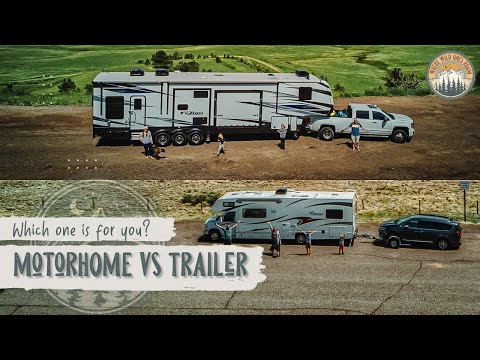
Ultimately the biggest factor in deciding between a Travel Trailer or a Class A RV is your budget , the size of your family, and how often you plan to use it.
A Class A is generally going to be the way to go in most cases. But that’s especially true if you have a family of more than 3 people and plan to take long trips during summer and occasionally throughout the year. Trailers are great, but better suited for weekend warriors and small families.
But lastly, there’s a huge difference in price between them. A trailer could easily be $60,000 cheaper than a Class A RV (or more). That low barrier of entry makes the RV life totally possible for people who just can’t manage a 6-figure Class A.
But no matter which way you choose, life in an RV is grand! So start making memories and taking on new adventures.
Jeff Campbell
Jeff Campbell travels on and off with his 3 daughters in a Newmar Baystar Class A Motorhome. He writes extensively on both RVs, campgrounds, parenting on the road tips, remote learning & schooling, and much more! Click Here to learn more about me. Click Here to learn more about my site. Editorial Policies.
Leave a Reply Cancel reply
Your email address will not be published. Required fields are marked *
Save my name and email in this browser for the next time I comment.
Top Related Posts
25 Crucial Pros and Cons of Living in an RV Full-Time
I have lived in my RV with my kids for 4 weeks at a time. But someday, I may decide to live in ours all the time, and so I wondered about the pros and cons of living in an RV full-time. The pros...
How Long Can You Boondock in a Class A RV?
Boondocking traditionally involves camping off-grid and without hookups outside of a designated campground. Class A RVs are often luxury vehicles, so it's natural if that means they can go longer....

Class A Motorhome vs. Travel Trailer: Which One’s Right For You?
- April 27, 2020
- Buying Guides
Today, we explore the key differences between class a motorhomes and travel trailers, and help you decide which one is right for you.
When deciding on what kind of RV lifestyle to pursue, it is important to understand the different classes and styles of recreational vehicle to purchase. One of the main choices to decide on is whether you want a travel trailer or a motorhome. There are advantages to both kinds of RV styles, but you should look into the advantages and disadvantages of both to see what unit will work best with you and your family.
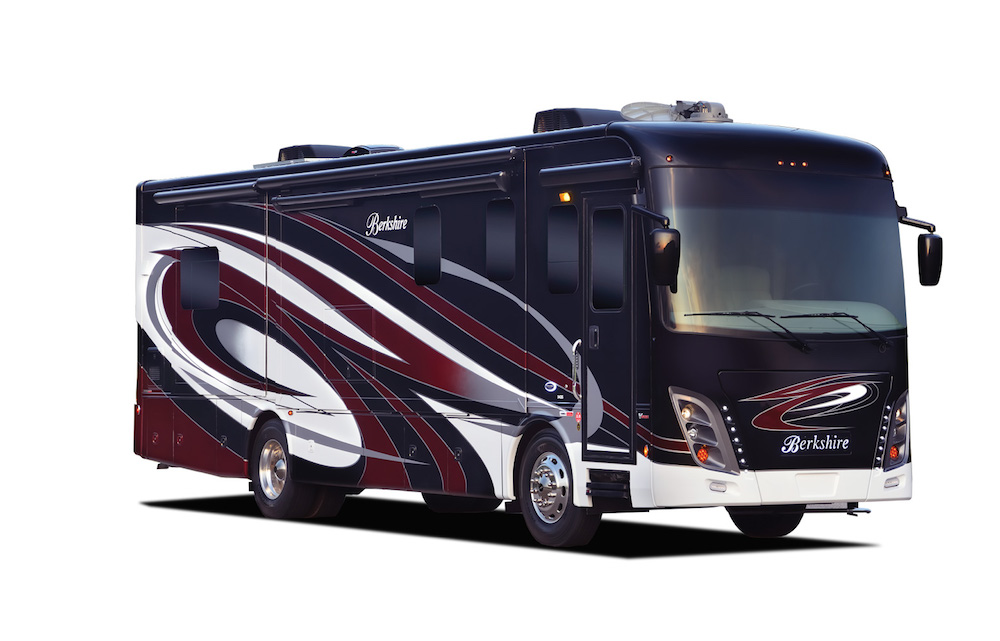
Table of Contents
Pros and Cons of Class A Motorhomes
For a full soup to nuts review of the exact specifications of a Class A Motorhome in particular, check out our helpful guide: What, Exactly, Is A Class A Motorhome?
Motorhomes, in general, when compared to travel trailers, combine both the living space and the vehicle in a single unit.
The cab of a motorhome includes both the drivers and passengers seat and essentially provides a more comfortable, luxurious form of seating.
The living space in a motorhome is accessible
In a class a motorhome, every part of the living space is accessible as soon as you pull over. If someone in your family tends to need rest stops more regularly, the motorhome has everything you could need right there in the vehicle — kitchen, bathroom, pantry, and the like. You don’t need to go searching for rest stops that can accommodate the travel trailer as well as have all the amenities you may require — all your personal facilities and amenities are right there in the vehicle.
Another advantage of having your living space accessible is there is much less risk of pulling up to a campsite with a complete disaster in your wake. If the fridge door opens during a turn someone in the motorhome will probably notice and remedy the situation before you have a mess of yoghurt and orange juice covering the floor.
Class a motorhomes also let you keep your pets right there in the RV with you. They are more comfortable as you may let them roam rather than keeping them in a crate for long periods of time, and your furry companions get to enjoy the ride with you.
You will need to stop for gas less often
The fuel tank in a class a motorhome was designed for driving your motorhome, so it is large enough to take you long distances.
If you’re driving a truck with a travel trailer, you’ll burn through gas a lot faster than just driving the truck, because trucks were not all built to be hauling cabin-sized trailers all day, everyday.
Class a motorhomes are easier to drive
Many people who have owned or used both motorhomes and travel trailers say that a motorhome is far easier to drive.
Towing something as large as a travel trailer is not an easy task and requires a lot of forethought when it comes to exiting, changing lanes, or turning in general.
Having your full travel experience, home and vehicle, makes for much easier driving.
Class a motorhomes are easier to set up
Setting up the water and electricity for a motorhome tends to be quicker and easier than a travel trailer. People who know their motorhome well can often set up within 20 minutes from parking.
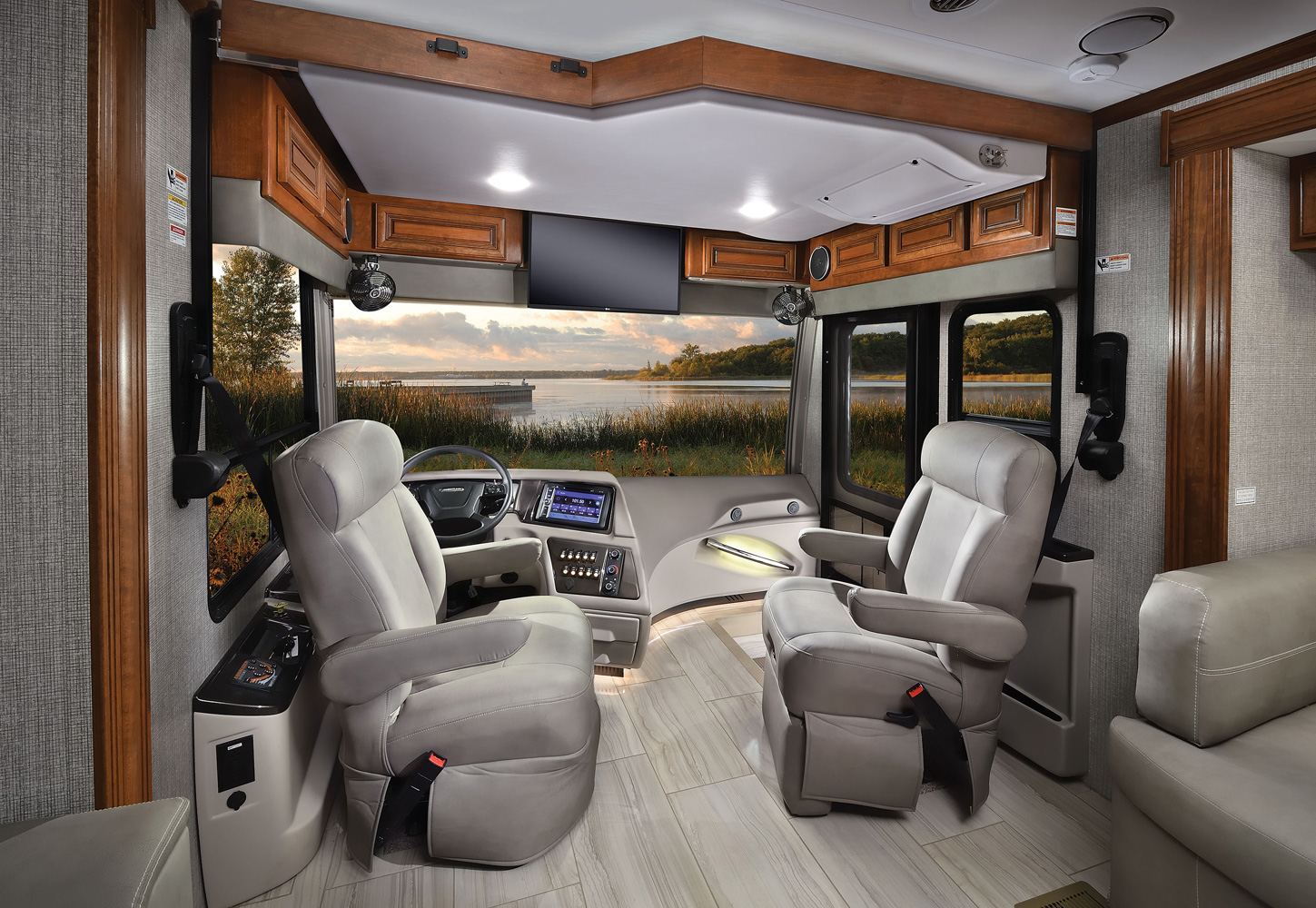
You may be limited in where you can visit
Because Class A Motorhomes are quite large and require particular setups for water and electricity, it’s usually most ideal to park motorhomes in some type of RV park.
On the other hand, travel trailers are a little more versatile and can be parked in most (if not all) campsites, while motorhomes are more particular and need specific accommodations.
It’s more difficult to leave your campsite
Motorhomes make driving from site to site much easier; however, once you get to the site it can often be difficult to go out for groceries or see the tourist destinations in your city of choice.
People don’t want to connect and disconnect the water and electricity and park the large vehicle multiple times a day, so the best way to still have easy travel within a city while using your motorhome is to tow a small car behind you.
On the other hand, this point is very much a matter of opinion as to whether it sits in the pros or cons list. Some motorhome enthusiasts say they prefer towing their small car behind them as then they don’t need to drive their big truck in the city, while travel trailer advocates have said they prefer having a larger vehicle with them so they can do more and carry more in their truck.
A class a motorhome costs more
Motorhomes, because they are an all-in-one unit and tend to have more amenities tend to be much more expensive than travel trailers — especially if you keep in mind also needing a small vehicle to tow behind it.
You pay for what you get, so since there tends to be more convenience and more things with ready access with a class a motorhome, they do come with a higher price tag.
Servicing requires a particular mechanic
When you choose a motorhome you need to be more diligent with your servicing schedule because not every mechanic will be able to provide repairs and tune-up services. On the flip side, travel trailers don’t tend to break down, trucks do, and the truck is often easier to find a suitable mechanic.
Pros and Cons of Travel Trailers
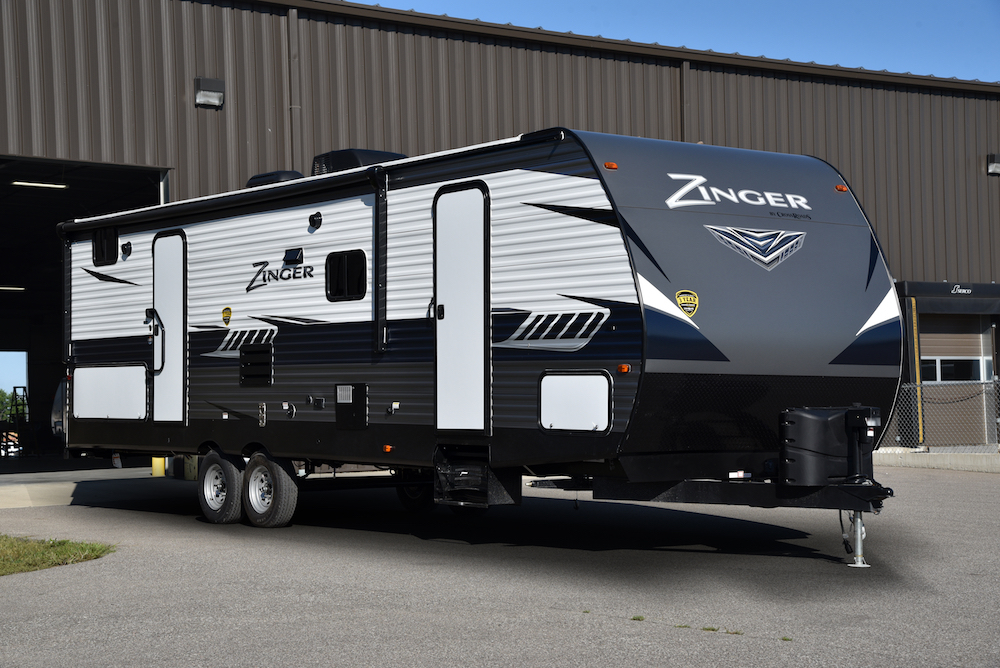
It’s easier to travel outside of your site
Because all you need to do is unhitch your truck from your trailer to leave the site, travel trailers have the advantage of being able to leave your belongings behind at your camp destination as you head out to explore the sights and sounds of the area you find yourself in — even if it’s just to leave for a beer run.
Travel trailers offer safer transportation
Children are always safer in the backseat of a truck than they are in a motorhome. Motorhomes will have places for children to sit and sometimes buckle in, but the backseat of a truck keeps families safer than that of a motorhome.
Travel trailers are less expensive
Travel trailers are significantly cheaper than motorhomes because they are just that, trailers not vehicles.
You pay less because they often have less amenities and “perks,” but if you’re looking for a simple way to travel and go camping — and your tenting days are behind you — travel trailers are an incredibly economical option.
You do need to include the cost of a vehicle that can actually tow your trailer though, trucks and some SUVs can tow a trailer, but your Honda Civic isn’t going to cut it, so the added cost of a truck needs to be considered.
Travel trailers require less maintenance
Travel trailers do not break down as much as a motorhome would because there is not as much to maintain, if your hitch and wheels are in good shape, you’re usually good to go!
Travel trailers can be more difficult to drive
If you’re not used to towing large items, driving with a travel trailer is going to be quite the learning curve. Making turns, changing lanes, and the like are all trickier when you’re towing a trailer.
Travel trailers are more difficult to set up
Setting up camp with a trailer is not very quick, you have to unhitch your truck which is not an easy process as well as get everything ready. Setting up your trailer at a camp site can take anywhere from an hour, depending on how much experience you have.
Travel trailers are less spacious
If your trailer is meant for full time living, a travel trailer may be too small for you. You can get incredibly large trailers up to 40 ft, but when you do that the travelling and driving conundrum is increased. For a trailer that is easier to travel and drive with, you will have to sacrifice a large amount of living space.
Final Thoughts
As we’re sure you’ve come to notice, when it comes to choosing between a class a motorhome and a travel trailer, it isn’t really a question of which one is better, but, instead, a question of which one suits your needs and lifestyle best.
The same features or challenges can be viewed as either a disadvantage or an advantage by different people. The important thing is to figure out what kind of camping experience you would like to have, what is important to you, and what isn’t as important.
Whether that ends up being travel trailer and truck because you like the versatility, or a class a motorhome towing a small car because you like the ease associated. Whatever matters to you, there is a recreational vehicle that will be right for you, and we’d love to help.

JUST LIKE YOU, WE'RE ALBERTANS TOO.
Want helpful rv tips and reminders sign up for the grove rv newsletter today, browse by topic.
- The Latest Trends
- How To Guides
- Destinations
- Around Grove RV

A guide to the 8 types of RV explained, from Class A to camper vans
- RV sales have been increasing as people have started looking for ways to travel during the summer while still social distancing.
- There are several RV and RV trailer types available on the market.
- For those looking to purchase or rent an RV for summer trips, here's a guide explaining the different RV class and trailer types.
- Visit Business Insider's homepage for more stories .

RVs and RV trailers are no longer just for older folks looking for post-retirement travel plans or suburban families looking for a summer getaway.
RV sales started skyrocketing when states started their first rounds of lifting stay-at-home orders. And now, RV interests have been hitting new customer segments, such as millennials looking to fulfill their "digital nomad" dreams.
But for first-time home on wheels buyers and renters, the RV and RV trailer market may seem daunting.
Each RV and trailer type differs from the other in size, floor plan, weight, and design to fit the needs of different customers. For example, large toy hauler trailers allow families to bring both their children and their ATVs and kayaks on the trip. But other trailer types, such as the teardrop, may not even include an interior kitchen due to its smaller size.
Whether you're looking to purchase your first RV, or you've been browsing RV rental platforms Outdoorsy and RVshare for a weekend RV getaway here's a list of different RV and trailers, explained:
Class A: the largest RV.
Class A RVs are the largest of the three RV classes.
According to Outdoorsy , Class As are typically built on a diesel or gas-powered vehicle, commercial truck, or commercial bus chassis. This expansive size allows its interior to have the same amenities as any traditional foundation-based home, although this often means it can be the most expensive RV type.
Because of this, the Class As are a popular choice for people who want a luxuriously large RV for full-time living on the road, according to General RV .
Class B: the smallest RV.
The Class B is the smallest motorhome of all three classes.
This segment is commonly otherwise known as a camper van or a converted van. It's also currently popular among many millennials looking to pursue #VanLife , and recently, many van conversion companies have seen a skyrocketing request in builds .
Because Class Bs are often small, the vehicles typically don't include the same spacious amenities as a Class A. However, it's still possible to have the kitchen, bathroom, bedroom, and dining area basics with the right floor plan by being creative and integrating multi-purpose furniture, such as a dining table that can be flipped into a sleeping space.
Related stories
Class B's are also easier and cheaper to operate and don't require any kind of special driver's license.
Nowadays, many Class B RVs in the US are built on Ford Transits, Mercedes-Benz Sprinters, and Ram Promasters.
Class C: the in-between RV size.
As counterintuitive as it is, the Class C RV is smaller than a Class A, but bigger than a Class B.
Class Cs are known as "versatile" RVs that have more space for amenities and beds with its average length sitting between 20 to 31 feet, according to Outdoorsy . The class can also often be identified by the over-cab sleeping area, according to Expedition Motor Homes .
Class C RVs are often built on the chassis of pickup trucks or vans, making it more fuel-efficient and less expensive than the Class A.
Pop-up camper: the camping tent on wheels.
Pop-up campers are towable units that can be expanded by unfolding its sides, which are often made of canvas, according to RVshare . This makes it similar to a more structured, above-ground camping tent that's more affordable than other RV or trailers, according to Outdoorsy .
And because the pop-up campers have lightweight foldable components, they can often be easily towed.
Pop up campers typically range between eight feet to 16 feet, although this size expands when the roof is popped up and unfolded, according to Popup Advice .
Travel Trailer: the most popular trailer.
The travel trailer category is relatively broad, but this versatility means it can fit many sizes, floor plans, amenities, and budget requirements that customers may have. According to Thor Industries , it's also the most popular towable with a length between 13 to 40 feet.
Travel trailers often require a pickup truck, SUV, or van with a hitch to be towed, according to Outdoorsy .
Fifth Wheel Trailer: the largest trailer.
Fifth wheels are the largest RV trailer segment available and can often be identified by its raised extension like that of an over-cab in the Class C RV segment. This extension then hangs over and attaches to the vehicle that is towing it, which is often a pickup truck, according to Thor Industries .
Fifth wheels average between 25 to 40 feet. Due to this size, fifth wheels often have plenty of space for rooms and amenities. This also makes it a good trailer for those who want to travel with a larger group of people or folks who plan on camping at a single site for a longer time.
Teadrop Trailer: the tiny rounded trailer.
Teardrop trailers fall on the lighter and smaller end of the RV trailer spectrum, according to Camp Addict . Because of this, the pint-sized trailers can often be easily towed, although the interiors won't be as decked out with amenities as a Class A RV.
To accommodate this, teardrop makers have to be creative, either by offering a larger trailer size and floor plan, or using pull-out units and tables — such as a pull-out kitchen — to utilize the exterior space of the trailer.
Toy Haulers: the trailer that has room for extra outdoor or water toys.
Toy haulers are built like a home on wheels with a large garage to store outdoor gear and toys like motorbikes, snowmobiles, or kayaks.
However, it's not technically its own trailer segment. Toy haulers — which are generally 21 to 40 feet long — often come in the form of a travel trailer, fifth wheel, or one of the motorhomes, according to Thor Industries .
Watch: How long will social distancing last? It's complicated.
- Main content
Class A Motorhome VS Travel Trailer: Which Is The Best For You?
By skyriverrv

It can feel like a lot to navigate when trying to decide what RV to purchase. If you’re just starting to think about purchasing an RV for the first time, all the different terms, brands, layouts, and sizes might leave you scratching your head, wondering what the differences are. We want to make it as easy as possible for you, so today, we’re going to do a comparison of motorhomes and travel trailers. We’ll cover what the differences are and which is right for you.
Motorhomes Explained
Class A Motorhomes are your motorized RVs. It has everything you need all in one space. You drive the motorhome, and you don’t need a separate truck or vehicle to pull it along. It’s self-contained.
What that means is that while you’re upfront driving to your next destination, everyone else can be sitting in the motorhome. Because you’re driving what will ultimately be quite a large motorhome, you’ll need to get used to the way your motorhome moves. Knowing how much space your motorhome has when passing objects, turning corners, and reversing are all things you will need to learn, but you can definitely get used to it.
The other major thing to point out is that with a motorhome when you arrive at the RV park or resort, you simply park and hook your motorhome up to the amenities on site.
Travel Trailers Explained
Travel trailers are towable RVs. That means you’ll need to tow it behind your truck or SUV. That means you will have a secondary vehicle to think about along your trip. On travel days, as you move from one park to another, everyone will need to travel in the truck, since it’s illegal to be in a travel trailer while it’s moving.
Travel trailers are usually a little more compact than motorhomes, but there are still be some pretty big ones that can easily fit the whole family. Just like with a motorhome, you’ll also need to get used to towing a travel trailer. It might be wider than your vehicle, so you’ll need to get used to how driving feels with a travel trailer on the back.
When you arrive at your destination, you’ll need to park your travel trailer up, unhook it from the back of your vehicle, and hook it up at the campsite.
What Are The Major Differences?
You might already notice the really key difference : motorhomes are motorized, and travel trailers are towable. But the differences in this section are about more than that. They’re about how these two different RV types work in practice, for your average couple or family on the road.
Travel days look very different. In a motorhome, even though everyone needs to be buckled up while moving, there are different options as to where you’re seating and what activities you can do. That means kids can sit at the dining table (if there are seat belts in the chairs) watching the TV as you sit upfront and drive. If you have children that are car seat aged, there are special car seats you can find that are ideal for traveling in a motorhome.
With travel trailers, that would be illegal. Instead, everybody has to sit in the vehicle (including pets) because it’s unsafe to sit in a towable travel trailer whilst it’s on the move. If you have young children you don’t need to worry about finding a different carseat that works in the RV.
Routes You Can Take
This might seem like an odd point to bring up, and it might even come as a surprise to many of you, but you can’t easily go off-roading with a motorhome. Now, you might be thinking ‘Why would you want to go off-roading in a motorhome?’, and that’d be a fair question to ask. But the truth is, there are many RV parks and resorts that are located in surprising places that are a little off the beaten track.
Many trucks have four-wheel drive and are able to tow large travel trailers on an off-road route to get to your destination. But any motorhomes taking the same route might seriously struggle, and in the worst-case scenario, may even get stuck.
So in practice, you’ll need to think about the sort of RV adventures you’ll want to have. If you’re planning on sticking to the freeways and stopping at coastal locations right on the beach, then motorhomes will work just fine. But if you’re a family or couple that likes to travel down roads off the beaten track for adventures, then you may prefer a travel trailer instead.
Maintenance And Running Costs
Initial investment aside for a moment, since many travel trailers and motorhomes, can come in at similar prices when you compare different brands and sizes, etc., let’s just concentrate on the maintenance and running costs of the two different RVs.
With a motorhome, you need to remember it is a motorized vehicle. This means it requires the same type of service and maintenance as your daily driver. In addition, you will have the maintenance that comes with an RV. With a travel trailer, you don’t have to worry about servicing an engine or other maintenance that comes with a vehicle. However, you will have to make sure you are properly maintaining your tow vehicle as well as doing regular RV maintenance.
Which RV Is Best For You?
There are clear pros and cons for both travel trailers and motorhomes, but where those points go on the list is up to each individual buying the RV. Some people prefer the conveniences provided by a motorhome. They may not own a truck or SUV and don’t want to buy one in order to go RVing.
Other people like to set up camp, unhook their tow vehicle and have easy ways to drive around for day trips. They prefer the conveniences of a travel trailer.
The point is that deciding between motorhomes and travel trailers is a personal experience. You have to ask yourself some questions about what feels right for you.
Do you feel comfortable behind the wheel of large vehicles, want the convenience of being able to access your RV while on the road, and would prefer being able to just pull up at the RV park and relax right away? Then choose a motorhome.
Do you prefer driving your truck and want to be able to experience the road less traveled? Then a travel trailer is perfect for you!
Take-Home Message
We’ll finish with one last piece of advice. If you’re still undecided between Class A motorhomes and travel trailers, we’re happy to help you decide what option is the best fit for you that will help you achieve your travel goals. Our joy is being able to help you find the perfect RV for you. If you tell us what your needs are, we’ll be able to help you decide. After all, sometimes all you need is a little extra guidance to help you make your mind up and find the perfect RV!


- Find a Location
A Guide to Class A Motorhomes
In basic terms, a Class A RV is a type of recreational vehicle. They are great for taking the family on long road trips or seeing the open road with friends. However, there are a few characteristics that set them apart from other RV classes.
Common Class A RV Features
Class A motorhomes are distinguished by their large, flat front windshields. They’re the only type of RV with that feature, as other motorhomes are more like camper vans or cabover campers. Here are some of the other commonalities that most Class A RVs share:
- One of the largest and most luxurious RV options
- Anywhere from 29-45 feet long
- Capable of sleeping 4+ people
- Fueled by gas or diesel
- Designed to handle a bigger load
- At least two slide-outs for an expanded living space
- A feel of home with spacious interiors that include a kitchen
What is a Class A RV Chassis?
Since a Class A RV is larger than most vehicles, it needs a heavier frame. They are usually built on a bus chassis, a specially designed RV chassis, or a commercial truck chassis. Learn more about RV chassis and how they impact ride quality, structural integrity, and what can be built on top of them.
Class A Diesel Pushers versus Class A Gas Motorhomes
Like all motorhomes, you’ll find Class A RVs powered by gasoline or diesel fuel. Of course, this impacts how much you pay at the pump and can impact the availability of fuel in the case of diesel pushers. Until I bought my diesel truck, I wasn’t aware that every gas station doesn’t necessarily offer diesel fuel. So an important thing to remember if you’re considering a diesel pusher is that you’ll need to be more strategic about fuel stops.
Beyond fuel price and availability, there are several other important distinctions between Class A gas motorhomes and diesel pushers:
- Engine Location. Most manufacturers place the engine in a diesel pusher at the rear of the coach, as opposed to at the front of the coach in a gas Class A motorhome.
- Towing Capacity and Torque. Diesel pushers generally have more towing capacity and increased torque or power.
- Ride Comfort. The inclusion of air ride suspension and air braking systems makes diesel pushers ride more smoothly (although you’ll find those suspension and braking components on some gas motorhomes).
- Highway Noise. Because the engine is located at the rear of the coach, you’ll experience a quieter ride in a diesel Class A motorhome than in a gas model.
- Resale Value. Diesel motorhomes tend to hold their value on the resale market better than gas RVs.
How Does It Look and Feel Inside a Class A RV?

Some might call these “classy” RVs since they have many luxury features. So, what’s inside a Class A RV that makes them beyond fancy? Depending on the model, you could get:
- Wood accents
- Queen or king-sized beds
- A coffee table between the driver and front seat
- A TV in the bedroom and living area
- A drop-down overhead bunk bed
- Electric cooktop
- Many sleeping areas
- Seatbelts for every seat
- Washer/dryer (or at least prep for one)
Pros and Cons of Class A RVs
As with any class of RV, there are pros and cons that you’ll want to be aware of before making a purchase.

Let’s take a closer look at the major advantages of owning and traveling in a Class A motorhome.
Great For Family Road Trips
The kids can have their own spacious seating while you hunker down in front. They’ll have a table for their books, games, or tablets. Plus, with all the beds, bunk beds, and pullouts on board, you won’t have to worry about finding a hotel. Calling a Class A RV a motorhome is not just a name. With all the amenities on board, it will feel like a motorized home.
Great Views
Do you want to see the world? Do you want to look up from your steering wheel and be amazed at what’s before you? The large windows of a Class A RV allow you to see the road in a new way. Lush trees and large mountains are only a sampling of the great bounty your eyes can feast on. In the elevated cockpit of a Class A, you have more visibility on the road, other vehicles, and the surrounding landscape. It’s a one-of-a-kind experience.
No Trailer Required
If you’ve ever been apprehensive about towing a travel trailer, fifth wheel, or toy hauler, Class A RVs don’t require the added stress or expensive equipment needed for towing. Driving one will take some acclimation, but many RVers appreciate that it’s one independent unit.
Nearly Theft-Proof
If you lock it while out and keep the keys with you, no one can take it. Plus, if you start to feel unsafe, you can quickly lock up and drive away, though a cumbersome option. Class As are formidable RVs you can easily secure. Just ensure you lock your cargo bays, too.
Onboard Generator
Anyone who suddenly lost power knows how life-saving a generator can be. Having an onboard generator helps in case the campsite lights go off. Class A motorhomes come equipped with an onboard generator, and they are helpful beyond emergencies. Onboard generators make your RV more capable of boondocking in a pinch.
Plenty of Space and Storage
One thing you might wonder about is space. Is there enough space to have a moment to yourself? Will your family feel like packed sardines? Nope. Even with the expandable sides tucked in, you’ll have plenty of room. In addition to space to relax, you’ll also have more than enough storage space. You could pack beach toys, small appliances, and tools too!
You Can Have a “Toad”
Are you going to be in one area for a long while? Maybe head to the beach for the summer? Or what about heading out to the lake? The beauty of A Class A RV is that you can tow your car with you. That way, you’ll be able to take the car into town without taking the RV. Towing the car along is called having a “toad.” Your toad doesn’t have to be a car; you can tow a boat for some extra lake fun, or you might opt for a Class A toy hauler if you’re more into dirt biking and ATVing.
Diesel and Gas Options
If you like having options, you’ll be happy to know that there are Class A diesel motorhomes and gas models. There are also Class A diesel bunkhouse RVs that’ll sleep your whole family and then some.
Cons of Class A Motorhomes

Despite their many advantages, there are some downsides of Class A RVs that you should know.
Fuel Economy
Depending on your model, most Class A gas motorhomes average 6-10 miles per gallon. Diesel pushers don’t average much better at 7-10 miles per gallon.
Large Blind Spots
Class A RVs are large vehicles with blind spots to match. It can take some time to get used to driving them, especially when it comes to turning and backing up. When turning, be sure to take a wider turn than you would with your car to ensure there’s space to get around. Before backing up, check to ensure that a person, animal, or vehicle is not behind you.
Finally, you will have a wide view of the road and tall adults. But small children standing right up against the RV will be harder to see. So before taking off, it’s best to check that no one is in front or behind the RV.
Flat Fronts
RVs don’t have anything sticking out from the front windshield. Their flat fronts provide little protection in a head-on collision. Also, they typically don’t have airbags. You should be seated and belted when the vehicle is moving. Also, the flat front makes it hard to access the engine, so only go in if you know what you’re doing. Never open it up to “just explore.”
The Cockpit Can Be Hot
The engine sits in the front of the RV, making the cockpit a little hot. The wide windshield driving directly into the sun’s rays doesn’t help either. So, what can you do to cool things off? Turn on the A/C while packing for the trip. When it’s time to hit the road, the cockpit will be comfortable.
No Noise Buffer
Sometimes, you need quiet while on the road. That will be hard to come by since there’s only one level. One way to combat that is to ask that people wear headphones when listening to music/watching movies.
Can’t Tow Two Things
Towing your car along is a great advantage. Who needs the whole RV to stop by the store for eggs or sunscreen? However, you can’t tow your car and a boat. So, if you want to tow toys to the lake, you’ll have to leave the car at home.
Not All Mechanics Understand Class A RVs
Your trusted mechanic might know what’s going on with your Ford, but RVs are a different story. You’ll need to search for a shop that knows RVs and how to work on them.
Prices for Class A RVs can be a little high. They range anywhere from $100,000 to more than $200,000.
But there is some good news here! Camping World offers RV services for maintenance and collision repair, so you can rest assured your camper receives the best care possible.
What is a Common Class A RV Price?

As mentioned above, $100,000-$200,000+ is the average Class A RV price. But there are some ways to lower that cost. One is to look into a used model. Buying a used Class A RV allows you to afford features you might not have otherwise and stay closer to the lower end of the price range.
Another is to consider which features are needs and which are wants. Forgoing some wants (e.g., certain luxury features) could mean a lower price.
Class A versus Other RV Classes
Besides Class A, there are two other classes of RVs: Class B and Class C.
What Are Class B RVs?
Compared to a Class A motorhome, camper vans (as they’re also known) are on the complete opposite end of the motorhome spectrum. You might assume that a Class B RV would be a medium-sized RV, but it’s the smallest of the three classes. They’re much easier to drive than a Class A RV and also much easier to park.
However, there’s very little interior living area. It’s basically just enough space to cook, sleep, and retreat out of the elements when the weather isn’t great. Most Class B RVs have a wet bathroom as well. That means the shower and toilet are in the same room. Sure, they have innovative solutions to keep your RV toilet paper dry when you’re showering, but the toilet might need to dry for a bit before you use it after a shower.
Still, sleeping in a van camper is a major upgrade from car or tent camping, especially for those interested in taking road trips solo or with your partner.
Depending on the model, Class B RVs are/can have:
- Around 17-24 feet long
- Built on a van chassis
- 18-22 miles per gallon
- Able to sleep up to two people
- A dinette that converts into a bed
- Storage space for gear
What Are Class C RVs?
The “C” in Class C RV doesn’t stand for classic, but it might as well. It’s the RV people picture when thinking about RVs. You’re likely already picturing it; the iconic cabover area above the driver’s cockpit. That cabover bunk is the defining feature of a Class C RV, but you’ll find a ton of variety when exploring Class C floorplans. You’ll also find variety in what’s under the hood (i.e., regular class C versus Super C RVs).
Some people think of Class C motorhomes as medium-sized RVs that have some space, but not as much as Class A. That couldn’t be further from the truth. Nowadays, you’ll find luxury Class C motorhomes packed with residential amenities, full-length slide-outs, and the kind of upgrades that were. once reserved for the Class A crowd.
That being said, there does tend to be a marked difference in cost from an average class C to an average class A motorhome. If you want an RV that has plenty of amenities but costs a little less than a Class A, consider a Class C. Class C RVs usually are/have:
- Built on a truck or cutaway van chassis
- The ability to sleep two to eight people
- Full kitchenette
- Entertainment system
- Heating and cooling
- A full bath
Is a Class A RV Right for You?

Is Class A right for you? Well, that depends. If you’re looking for an RV that feels like a real home on wheels, then yes, Class A could be for you.
Class A RVs are great for families who like to get outdoors while still having access to amenities like a bathroom, kitchen, and soft bed to sleep in. They are the quintessential glamping camper. If you want something slightly smaller with a full bathroom and kitchenette, consider a Class C. Those who love vans, and the van lifestyle would enjoy a Class B.
Looking to buy or rent? Shop Class A RVs today so you can hit the open road in class.
Want to continue your RV research? Here are a few more resources you might find helpful:
- The Tiffin Experience in Red Bay, AL
- The Revamped Winnebago Adventurer is Ready for Summer
- How Much Do Class A Motorhomes Vary in Size and Why Does it Matter?
What questions do you have about Class A RVs and whether one is right for you? Let us know in the comments below.
Leave Your Comment Cancel Reply
Save my name, email, and website in this browser for the next time I comment.
Shop By RV Type

Your Adventure Awaits
Copyright © 2023 cwi, llc all rights reserved.
- RV Glossary |
- Privacy Policy |
- California Privacy Rights |
- Do Not Sell or Share My Personal Information |
- Targeted Advertising Opt Out |
- Terms of Use

Travel Trailer vs Class C Motorhome 17 Pros and Cons Comparison

- BUYERS GUIDE
G. Yoganand
In this article, lets check out the differences between travel trailer vs class c RV.
Deciding between different rv’s can be confusing. Isnt it?
But, you can make it very much easy for you, If you compare the options in terms of all your priorities. Many people are stuck on a decision to make between a travel trailer or a class c rv or other motorhome.
Can it be simplified in terms of all the differences? Well, read on to understand the comparison between travel trailer and class c rv.
Here is a summary of all that you should know before choosing between the two.
1. Cost Comparison – travel trailer are less costly
Travel trailer or class c rv or any other motorhome generally comes at thousands of dollars. And, when you pay such a big amount, comparison between various peers is bound to happen.
Paying big amount upfront for your camper needs to be one of the main factor for you, unless you are a millionaire.
Travel trailer is seen to be cheaper, at least most of the travel trailer would normally come at a price that is lesser than class c rv. This is average price comparison as otherwise you would also find travel trailers that can be more costly also.
But, it totally depends on what kind of travel trailer you are buying.
A lot depends on the size of the trailer you are looking for, what kind of amenities you want, the layout and also the construction type.
If you start looking for travel trailers in market, you would see that mostly the prices start with as low as $7000 and go upto as high as $70000.
A travel trailer at $70000 would be a matter of much thought though. Anyways, overall average price of travel trailer is seen to be mostly between $15000 to $25000. By saying this, i mean the most popular travel trailers come at a price that lies in this range.
Class C RV upfront cost is on higher side and they normally start at $50,000, which is almost equivalent to the highest model travel trailer you would get in market.
Class c motorhomes are better in terms luxury, when you compare them with travel trailers and thus, obviously are priced higher. Also, you don’t pull them behind your car. On an average most popular class c rv prices remain in the range of $60,000 to $85,000.
These motorhomes are priced based on amenities, size, floor plans and also, the manufacturing brand If you are looking to pack the recreation vehicle with things like dinner table, bed, refrigerator, sofa, bathroom then the prices would be higher and then, there is almost no comparison between the travel trailer and class c rv.
Thus, the price comparison between class c motorhome and travel trailer camper is clear and you should have a clear idea of what you are looking for.
With a budget of 20,000 or less will mean looking for a new class c rv is not a correct thing unless you are going for used one(that’s a completely different point).
2. Better Driving experience with Motorhome
Driving a camper or a motorhome is a experience that you wouldn’t get going around in car or big SUV. Going around in big rv definitely means you should be much more careful.
A big vehicle of a length of 30 feet not only demands for great care while driving, but also you should be comfortable driving it. Thus, it is a factor of lot of importance to not take into consideration.
Here are some top short Class C Motohormes .
Driving, when you have something towed behind using hitches can be tough in comparison to a big rv, but its totally subjective, some people find big rvs difficult to drive on road while some see a hitched travel trailer a total headache.
The best way to decide which one suits you will be taking a test ride, it could be a new one; if the dealer has such a facility or trying some one else’s travel trailer or class c rv.
If you have been driving any of these previously, then you yourself should be in a good position to understand your level of comfort driving them. Braking can be tough when you have travel trailer behind your car and will need learning as you continue to drive it.
There are quite a lot of factors to be vary of, when you have a hitched trailer behind the car. Backing a travel trailer also needs special attention, initially it may be the difficult part to deal with.
But, with practice you should be able to master it though. It would need proper use of mirrors, spotters to be able to do it like a pro. A class c rv backing may not be as difficult as travel trailer though. In comparison to a small car, it obviously will be fearful for new rvers. But, shouldn’t be an issue once you get good hands on.
A travel trailer can come good on narrow roads as compared to class c rv, which will be much wider.
Also, a class c motorhome can give you much better view , though windshields which may not be possible with travel trailer as you will be sitting in car; which will have lesser windshields.
You don’t get access to living area while you are driving in a travel trailer, where as class c motorhome makes it possible.
3. Towing efforts with travel trailer
Remember a buying travel trailer means you consider lots of factor associated with the towing which is not the case with class c rv or any other motorhome.
That’s the main difference between the two. Can this itself can be factor with greater significance to decide between the 2 and go for a motorhome? Getting a new travel trailer needs you to be sure that the car you already have is capable to pulling the trailer with ease. A matching need to be developed between the car and the trailer.
Getting hitches connected to car, making sure that the connection is perfect every time you head out for camping can be lot for someone with less patience.
With class c rv or any other motorhome for instance its just about taking the RV on road and driving. The set up with trailer can be time consuming and sometimes pretty much a headache.
Safety can also be a concern while you tow the trailer, your car or other vehicle may not always be the perfect fit for towing and that’s when the safety can be a concern.
Although you will get the list of cars good for towing a travel trailer also your car manufacturer stating the same in manual may not always mean you are good to go.
A travel trailer when bought will have certain weight but when you start packing things in it, its weight may go out of limitation for your car. Thus towing a travel trailer not only needs special consideration but also a safety check needed.
Using brakes on travel trailer towed car is also a thing of special practice and you need to be a well trained if not pro.
Thus a fact itself that you need to tow behind car is a greater factor for many to chose for class c rv or any other motorhome in the range. However if you are okay with towing or if you had experience of doing it previously tat you should be better off.
4. Travel trailer Needs less Maintenance
Maintaining a car itself can be a task that many people find tedious. If you are of that nature than owning a rv or travel trailer can get tough for you.
A travel trailer when compared to class c RV for maintenance does not vary much and both need similar kind of schedule to follow. A class RV maintenance will be more costly as compared to a travel trailer, it will also need good storage in garage with a bigger space.
A travel trailer since smaller in size needs a smaller space and a maintenance can be easy as compared to class c rv or any other motorhome.
In case of class C rv you need to be careful about the appliances in it during winters, a class c rv comes at a high cost you cant afford to take things for granted. A travel trailer with minimum amenities will need less attention in comparison to a motorhome.
Read : How to keep travel trailer warm in winter
Having said that a motorhome is generally built heavily with a quality that can be much better that travel trailer and this means the RV or motorhome could be better off handling harsh conditions.
A travel trailer for instance can be protected by a cover which may not really be the case with a big RV. You would need a better garage, that is high in length and bigger n size.
5. Class C RV Has More Space
A motorhome when you compare the overall space you get for driving, living etc is larger as compared to a average travel trailer.
With a motorhome or class c rv you have a cabin that’s much above the road, it gives a perfect view while traveling. Which is not the case with travel trailer when you are sitting in your car.
With a modest price tag a trailer can give you space that will be compact, utilized in a manner to put it stuff as compact as possible as minimum as it gets.
A class C rv will give you a living area that’s larger, a bathroom with a shower that will good enough depending on the length you chose.
Overall with class C rv you have the luxury of space that is not possible with tow-able trailer. Having a bigger space in your camper or RV can be of much more importance when you are camping with kids.
For a couple a travel trailer could be a good fit if you are ready to live with the shortcomings. It all depends from person to person and the priorities. A large travel trailer can also be good for space, but may come with a price tag that almost similar to a motorhome.
Storage space with motorhome is also more and that can e of much more priority for many, Camping is all about packing things for the stay, but imagine you had less space that could fit in all things.
If you are kind of person who just packs things without giving many thoughts or if you are big family that needs lots of packing then go for a storage that meets your requirements. its as simple as that.
6. Less Depreciation in Travel Trailer
Depreciation of RV is something that many people hate. A costly vehicle loosing its value over a period of time hurts a lot. The moment you buy a brand new motorhome it starts to loose its original value.
Depreciation comparison between travel trailer and class c rv or any other motorhome like class B or class A can be a significant factor that can make chose travel trailer. Specially if you are among those who believe in selling old stuff for a good return or renew your RV after certain usage.
A travel trailer find itself with a depreciation little lesser as compared to class c RV. Class A motorhome or class c RV depreciation is directly proportional to the year of manufacturing.
For example, a 2014 model class C rv will loose more on its value as compared to a 2016 model. A year of manufacturing makes a lot of difference and so does the miles on odometer. A travel trailer does not have a odometer and that can be an advantage for it. It solely depends on the year on manufacturing and its condition.
Read : Travel trailer essentials
Maintaining the RV is of great importance if you want to prevent the depreciation percentage to certain extend.
But, unfortunately even with best of best maintenance you cannot prevent the going down of worth of your RV.
If we were to compare solely based on numbers the depreciation of travel trailer and class c rv remains almost similar for 5-8 years (could be between 40-50%) but as you go beyond 10 years a class c rv losses its sheen more as compared to travel trailer.
Class C rv or even other motorhomes loose close to 85% of their value where as a good maintained travel trailer can still hold close to 30% of its value that is losses 10-15 % less than class C rv or class A RV.
Having a look at these average numbers it is upto you if you really care about these 10-20 % after 10 years.
I think most wouldn’t care and the decision on class C against travel trailer should be taken considering the resale value factor with minimum importance.
7. Class C RV has better longevity
When you pay thousands of dollars for a rv or a travel trailer you obviously expect it last for as long as possible. Average life of a rv depends on lots of factors and is not tied with it when you buy it.
You will get warranty for various parts, but to expect a definite life for the trailer or class c rv will be foolish.
A rv or a travel trailer needs scheduled maintenance a good care is needed to keep it going for you.
Imagine you very a very good care taker of your rv then you can expect a good built travel trailer to last as minimum as 12-15 years. The most important part of the travel that you need to be specially careful about is the trailer roof.
Travel trailer roofs are subjected to leakage if sufficient care is not taken. Motorhomes on the other hand can be live a little longer, they are built solid, more capable and thus can last for 20 years or more on an average. It also depends on how many miles the rv ran.
A class A or C may give you more than 200 thousands of miles which may take you around 20-22 years to do. Comparing life of a travel trailer and class c rv solely for the purpose of deciding between two could be a thought for future too ahead.
Also, the life of trailer or the class c rv is very much dependent of many factors which can be controlled by the owner. It depends on how you store the rv when not in use, scheduled maintenance, usage frequency and so on.
8. Travel trailer puts pressure on car mpg
Getting a rv for thousands of dollar is matter of significant investment. Once you get a rv its not only about paying for the upfront cost, with the rv comes other costs.
There are lots of other things you end up spending before you go on that first camping experience. One of the other costs that you have with a rv is the fuel cost.
In fact, it is one of the major spending that a rver has to do to goa around in it. Many a times full time rver complain about the money they have to put in fuel costs. Considering this its important to do sufficient study on how many miles you can get with your class c rv or a trailer.
Getting best fuel economy for rv can be a significant cost saving factor. GA mileage is a parameter that can depend on lots of factors like the age of motorhome, the condition of you rv or trailer, the weight you carry on with in also on where you are driving the rv.
It also depends on the speed with which you drive the rv. On an average a class c RV can give you a gas mileage of around 10-12 miles per gallon (mpg).
It also depends on the wind conditions like a windy day will reduce the mileage may be by 1-2 miles depending on how the construction of the rv is to facilitate the wind resistance.
The wind condition is in fact more of a factor that affects the mileage that the weight of the RV. Pulling a travel trailer on an average also should give a mpg of around 10 miles per gallon.
Read : Truck Camper Or Travel Trailer
Here again, it depends on the frontal area of the trailer being towed. A good wind resistance handling by trailer will increase the mileage by 2-3 miles per gallon.
Also, the speed with which the trailer is being pulled matters. Imagine a speed of around 60 miles per hour, a weight of around 9000 pounds, length of travel trailer around 25 feet gives a mileage of around 8-9 miles per Jagiellon.
9. Travel trailers are available in abundance
Travel trailer are available in plenty in market as compared to class c RV or other motorhomes and thus there is a great chance that you will find a one that best suits your needs.
It is not that you wont get a class c rv as per your needs but you may have to hunt longer to get the one that best suits your needs. Buying second hand is also a option and when you compare the second hand selling market of travel trailer with class c motorhomes you will have lots of options with travel trailers.
In the year 2017 more than 5 lac RV’s were sold in united states which was less than 3 lacs in 2013, that means a growth of more that 100%.
With so many RV’s selling each year the availability of second hand has also increased and because there is so much growth the manufacturers have also spun into action.
Most of the RV’s sold include travel trailers and this number is also greater than the class c rv types. Travel trailer being less in cost are more popular and thus their selling is also larger.
Some of the travel trailer brands that sell most include keystone rv, jayco, rockwood, dutchmen, Airstream . Class C RV manufacturing brands that sell highest includes Winnebago, coachmen, tioga, four winds, jayco , gulf stream, itasca and many more.
10. Class C RV is much bigger
Rv’ or motorhomes have lengths that can intimidating. A length of more that 15 feet itself can be a tough one for a new driver who haven’t had the opportunity to drive such vehicles previously.
When you compare travel trailer length with a class c motorhome both have big lengths but class c motorhome are on an average about 50% more in lengths as compare to travel trailers.
Travel trailers are seen to be having average Lengths of around 20 feet where as class c motorhomes are seen having a average length of 28 feet. You will find variety of lengths but the most popular are seen with these lengths. A class c rv have lengths that start from anywhere from 22-25 feet.
Their counterparts class B rv are seen having average lengths of around 20 feet. Where as class A motorhome are among the lengthiest and they can be as lengthy as 45 feet or even more sometimes.
Understanding the length of RV or a travel trailer is important because you should be comfortable with their length, also you will have to think about the garage for storage at home.
Also, campsites or national parks have length restriction and you may want to have a length that fits in your favorite or close-by nation park of campsite.
Having a lengthy travel trailer can be a hard one to tow and you should check on the length so as to make sure you are not buying a one that will be too much to tow. Also a large length for a travel trailer would also mean more weight which should be within limits for your car to handle during towing.
11. Class C RV are heavier than travel trailers
Rvs of any kind are heaviest that run on roads. They weigh thousands of pounds. A more weight obviously means a reduced mileage.
With advances in manufacturing technology there has been reduction in with over the years. Yet the pounds haven’t come down to that level. Thus its important for you to compare the weight of rv that you intend to buy.
A class C rv is among the heaviest ones only to lag behind class A motrhomes that are heaviest of them all.
A class C RVs weight on an average is seen in between 10000 to 15000 pounds. Travel trailer on the other hand have weight that is much less in comparison to class c rv’s, a 18-20 feet travel trailer can be around 2000 pounds heavy.
It is important that your trailer is as light as possible, since you will be towing it with your car or SUV. And a car or mini truck will have its own capacity to pull and thus checking on the weight of trailer should be your first priority.
Its not only trailer weight but also the overall weight that you should check. A packing for camping can quickly get heavy exceed the limits of your towing vehicle.
Its also necessary that you are aware of overall weight with full gas tank. Having long trailer can give you good space but the pulling vehicle will be under pressure. There are also laws that prevent from pulling certain weight (you need to check that with the states towing laws).
12. Better Construction in Class C RV
Class C rv or any other motorhome are generally better made as compared to towable travel trailers. Their Construction quality is good and is more durable.
Saying these it does not mean all the class C rv construction will be of better quality. It depends on the brand, manufacturing year model. Obviously when you pay 2 to 3 times more you are bound to get it for a better quality.
Inexpensive travel trailer are made up of corrugated aluminium where as class C rv are costly made up of fiberglass or smooth aluminium.
Many a times understating the construction material of rv becomes a tough because all of them almost similar. But it is essential to understand the material type and their pros and cons.
13. More Set up at campground needed for travel trailers
With class C rv or any other sophisticated motorhome you get automatic leveling and thus the manual setup at campground efforts are reduced. This however may not be true with all models though.
Old models may not have automatic leveling. Travel trailer need little more efforts when it comes to doing the basic setup at campgrounds.
On-boarding the generator and doing other stabilization, disconnecting the travel trailer from the towing car are needed in travel trailer where as with class c motorhomes you may sit within without doing much of setup and start the camping. That’s the difference. No matter what RV you own but do not make these setup mistakes at the campground .
14. With travel trailer you get less Amenities
With class C motorhome you get amenities that are just the kind of luxury you would expect in a hotel.
Many thins fitted in so well and compact that may not be the case with travel trailer. A motorhome gives you the luxury of dinning within. Cooking inside, having air conditioner may not be possible with all travel trailers.
Most of the class C rv will have shower, toilet within. Where as travel trailer mostly may or may not have shower and toilet.
15. Additional Cost is more with travel trailers
A travel trailer need to hitched behind a car and for that you will have to spent anything from around $50-$800 also a regular maintenance may be needed for the hitched connection and even replacement of equipment.
This additional cost is not involved in case of motorhomes. Both the travel trailer and class c rv incur almost similar overnight parking costs which could be around $10-$50 per night.
Indoor or outdoor storage costs are also similar for both. An indoor storage costs around $50-$500 where as outdoor storage cost of renting could be anything between $40-$100 on an average.
16. Need of Car at camping
A big class C rv can be a good thing to have but imagine you need a car at the campsite may to go to a near by place where taking the big RV is difficult.
Read : Read Before towing behind a class C RV
When you go with travel trailer you already have car that come very handy. With big rv you then end up renting a car or tow a car behind your motorhome (which again will be differentiating factor), that’s the difference and advantage you have with travel trailer.
17. Insurance Cost
The bigger your RV larger is the amount you pay for the insurance. A travel trailer costs much less for insurance as compared to a class C or class A motorhome.
Insuring a travel trailer can be confusing as there are lots of factor that come into picture. A trailer can be insured right from $200 that can be as high as 8000.
Where as class C rv insurance can cost you anything between $800 to 10000. The more luxury you have the more you pay per year for the insurance.
Want to try before you finalize on travel trailer or class c? You can rent a RV on outdoorsy or rvshare and then decide.
In Conclusion
Travel trailer is less expensive but you also need a car or truck to tow them. You will have to deal with all the things related to towing but you get a separate car to drive, if needed.
Class C motorhome on the other hand is costly but it will give you better living space and facilities to enjoy. Choosing between the two comes down to your budget, weather you are comfortable in towing and also, the style of life you desire in an RV.
You Might Also Like
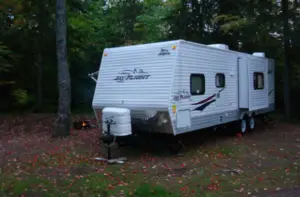
7 Best RV’s for First Time Buyers
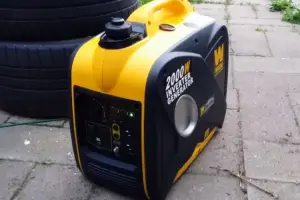
5 Best RV generators under $1000

Can you finance a used RV ?

10 Best Roof Top Tents For Jeep
- Hybrids & EVs
- Motorsports
- Tips, Tricks & Trends
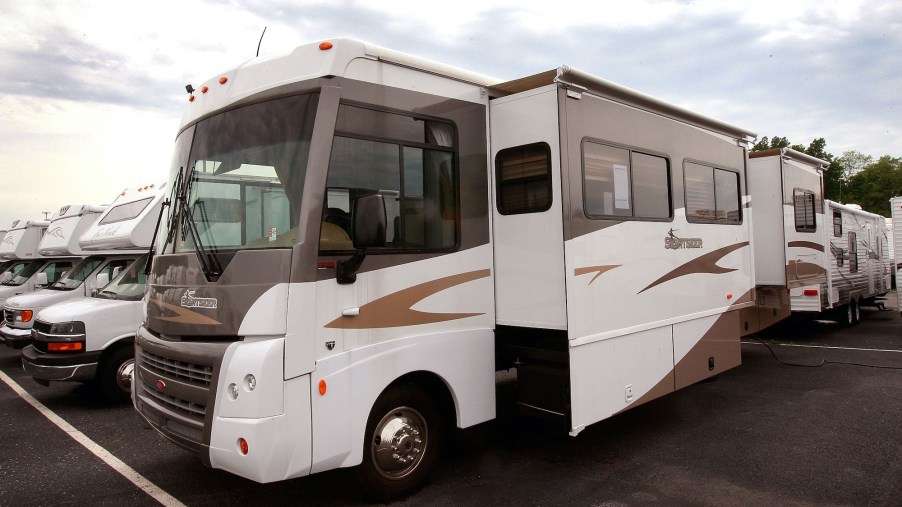
Travel Trailers vs. Motorhomes: The More Practical Choice Is Obvious
Socially distant activities are still recommended for now, so RV sales are booming . Travel trailer and motorhome RV models are perfect for campers who don’t want to rough it too much in the great outdoors. The two are very similar, so how do you know which one best suits your needs? Camper Report has the answer.
Both motorhomes and travel trailers come in various sizes. A Class A RV is as long as a bus and features a large kitchen and living room area. For something more minimalist, a pop-up trailer is still fairly spacious. However, for one type of camper in particular, it’s clear which one is more practical.
The perks of owning a travel trailer or motorhome
The best thing about trailers and motorhomes is their versatility. Motorhomes come in Class A, Class B, and Class C variations . These RVs can accommodate up to four passengers comfortably for a week or more in uncharted territory. Travel trailers also come in different sizes, the smallest of which can be installed on the bed of a truck.
Either one is suitable for a weekend getaway, but it’s important to remember size limitations. Large RVs and trailers can be a nightmare to park in small spaces or campsites. This is especially true for travel trailers that need to be attached to another vehicle. On the other hand, a smaller RV is easier to maneuver.
A few notable differences
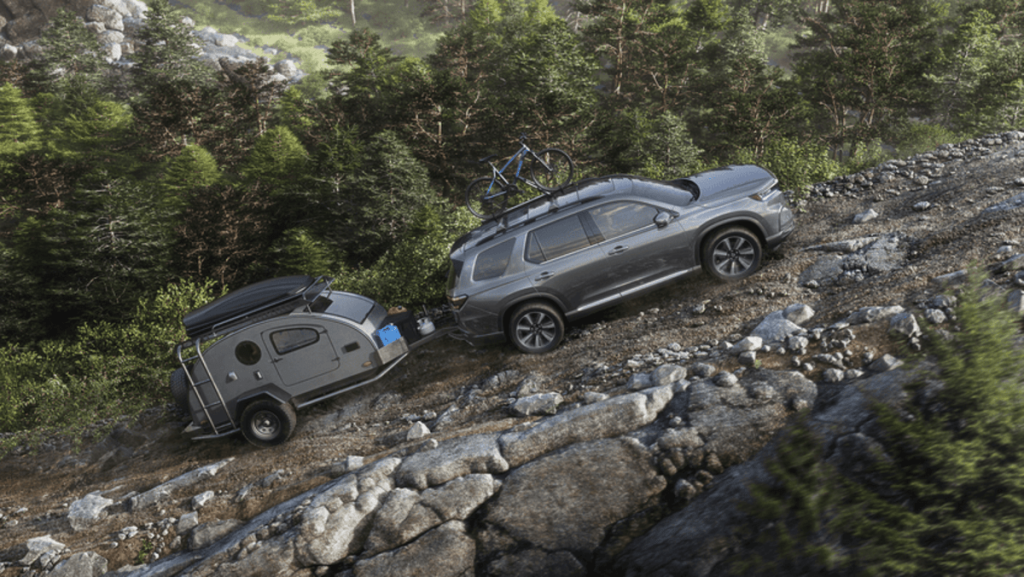
The biggest difference between the two is that a motorhome can be driven by itself. Most are powered by a diesel engine that gets around 15 mpg. This may seem like a downside, but keep in mind that pulling a travel trailer also causes lower gas mileage .
Motorhomes and travel trailers also have a steep price difference. A large travel trailer may cost around $30,000, while a smaller motorhome starts at $50,000. If you make a few camping trips per year, it may make more sense to go with the travel trailer.
Motorhomes will also depreciate faster than travel trailers, according to NADAGuides . The only exception is a fifth-wheel travel trailer, which has a depreciation rate of 71 percent over 10 years. A Class C RV will lose around 50 percent of its value after five years of ownership. Most travel trailers will still be worth 60 percent of their original value after five years.
How much does each cost to own?
After the initial sticker price is paid, then you have to consider maintenance costs. Since the motorhome comes outfitted with more standard amenities, it will cost more to repair over time. Since this type of RV is a car at heart, it still needs routine inspections and oil changes as well.
Despite the fact that it doesn’t have an engine, a travel trailer still needs insurance, just like a motorhome. Your rate will depend on the insurance company, but you can usually expect to pay more for the RV. A large travel trailer only costs $500 a year on average, while a Class A motorhome may cost up to $4,000, according to Classic Vans .
Is the travel trailer or the motorhome the more practical option?
For those who want to spend as little money as possible, the travel trailer is the better choice. A trailer is also more suited for the casual camper who only takes vacations during one season. However, if you don’t own your own car to pull the trailer, you might be better off with a motorhome.
While some minivans can tow a trailer, you’ll probably have to purchase a truck in most cases. The cost of a truck and trailer combined could end up costing more than the standard motorhome RV. If you plan to live in one for an extended period of time, go with the RV.
Jayco’s Unbeatable Warranty Makes It a Tempting Choice for Your Next RV

Texting While Driving Is a Primary Traffic Violation in 48 States – What Does That Mean?

Inspection Stickers Might Be on the Way Out

What Is Considered High Mileage for a Used Car
Addison White
Addison White is a contributing writer for MotorBiscuit.

RV vs. Travel Trailer: Which Is Better?
By: Author Brennan Valeski
Posted on Last updated: August 8, 2021
Categories Auto & RV , RV Living , Travel Trailer
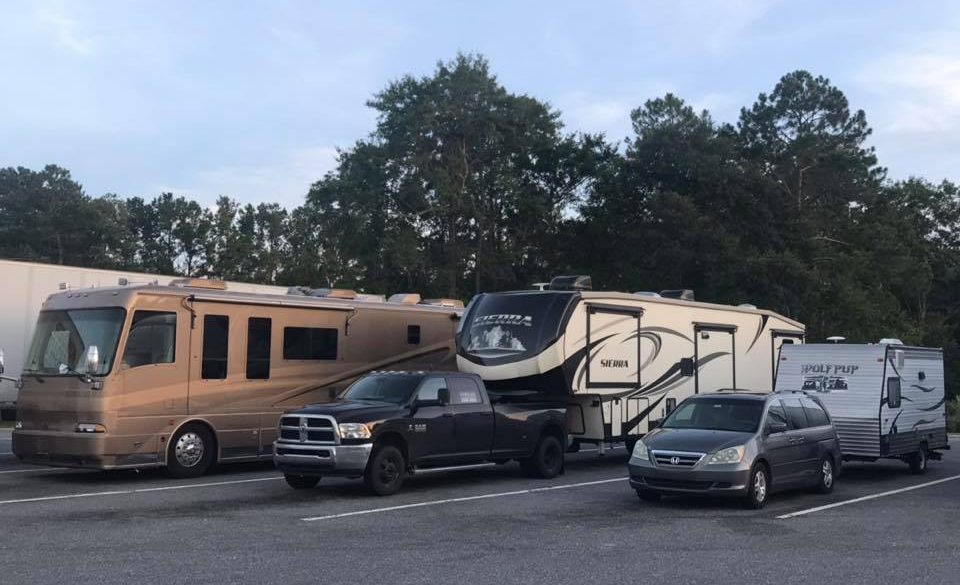
Is it better to drive a motorhome RV, or to tow a travel trailer that hitches to your existing vehicle? It’s a very important question for anyone looking to become an RVer and travel to various campgrounds and camping trips.
For most people, a travel trailer will be a better option. Unless if you plan to stay in one location with a large Class A bus style motorhome, or want the mobility of a shorter campervan, the ability to have a separate camper allows you to save on money, headaches, and maintenance.
Here are a few of the pros and cons and things to consider with an RV vs. travel trailer:
When to Go for a Large Motorhome Class A RV
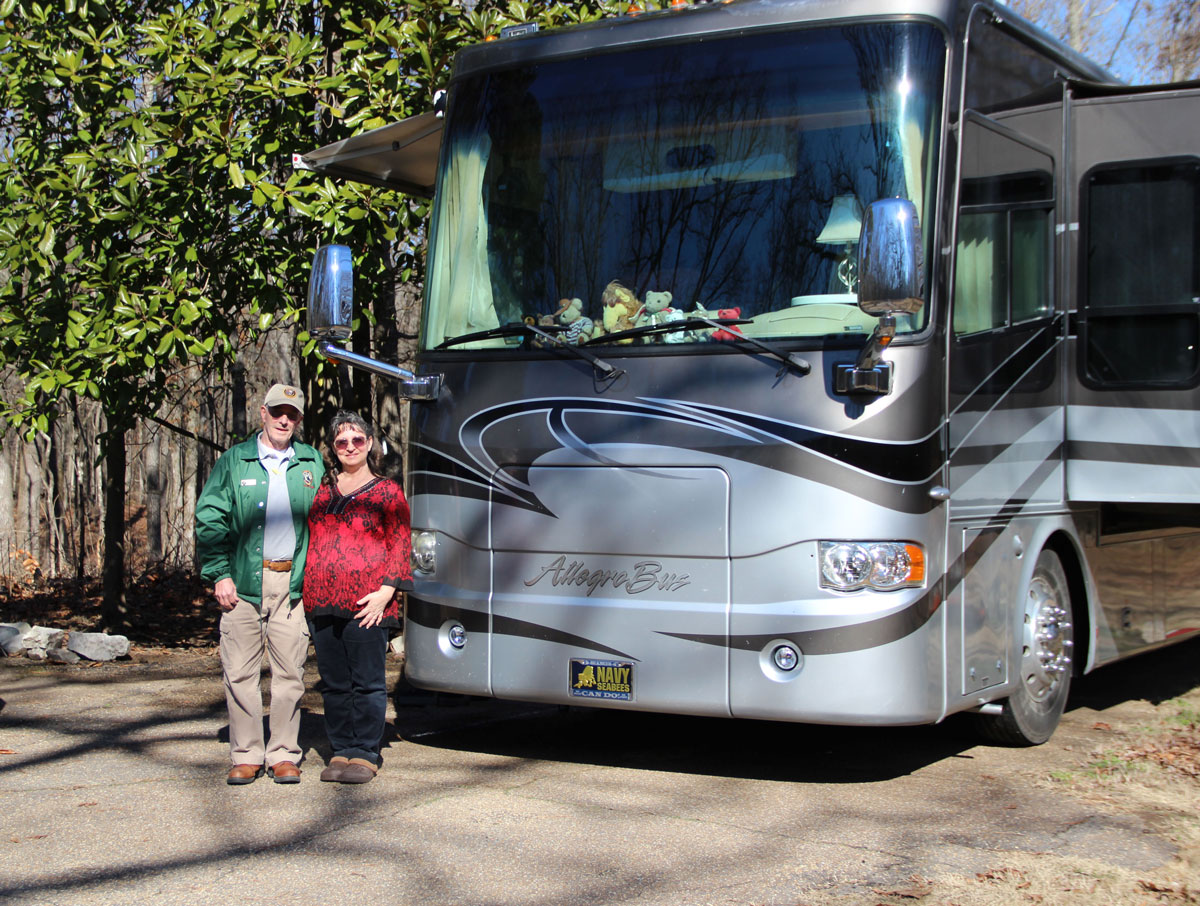
For the retirement age folks and older crowd out there, there’s a lot of them that only drive to one location. This may be an RV park or campground, and once they get there, they tend to stay and don’t leave the RV park for a long period of time.
In this case, a large motorhome makes sense since you won’t be moving around too much. You can take advantage of the luxurious cabin and not need to worry as much about the length of your RV since it’ll be more like your home on wheels that’s parked in one spot.
Once You’re at a Location, What Do You Do With Your Rig?
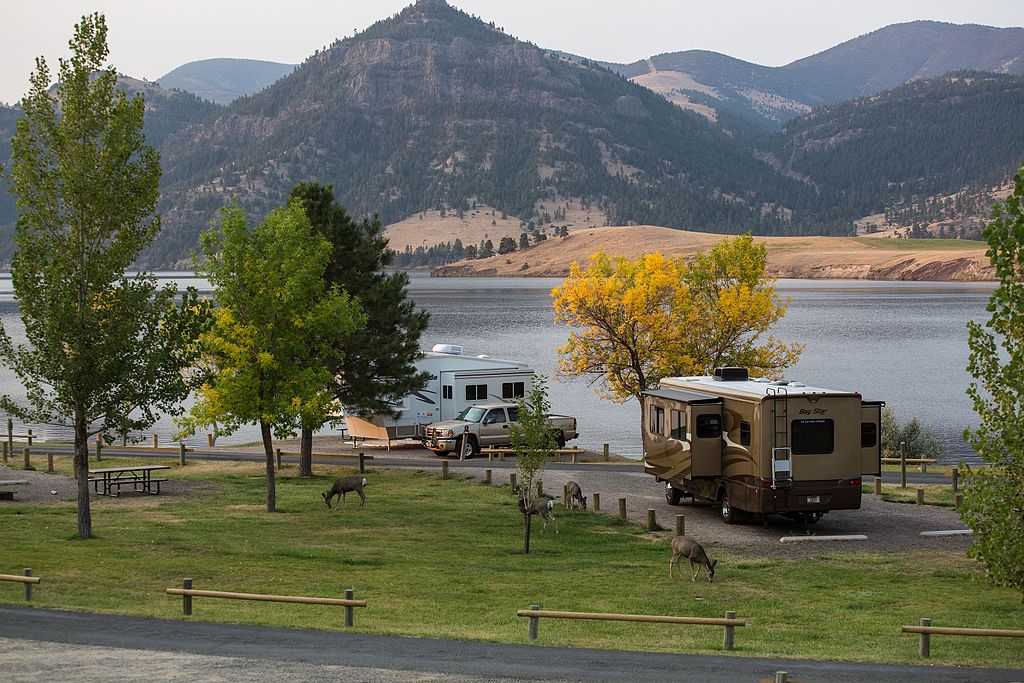
Many people have the idea that they’re going to get a full-on RV with a vehicle and home all in one piece. What happens when you need to go get groceries? What if you want to get a pizza? Or to go hiking?
If your vehicle is a bus, you have to take the entire thing with you wherever you go. Not to mention that once you get to an RV park or campground, you hook everything up.
This includes connecting the water and sewer hoses, hooking up electrical wires, and doing your leveling job. This is about a 15 to 30-minute set-up or tear-down each time. That means it’s a lot more work every time you want to go somewhere, and something you really don’t want to do constantly.
Funny enough, most people that have full-on RVs will end up towing a tiny vehicle behind it for this exact reason.
Generally, Travel Trailers Do Not Break Down
There’s typically not something too complicated that breaks on a travel trailer.
Your tow vehicle is a normal vehicle that you can take anywhere to get serviced and worked on.
This is not the case with a $300,000 motorhome that needs to get repaired at a specialized place. Many times they’re diesel engines and specialized vehicles.
Getting it repaired is going to cost a lot more and be more difficult to find a place to get it serviced.
RVs Do Not Have to Be Unhitched
This is a major benefit to driving a motorhome RV. If you’re an old-timer and you pull into a campsite, you connect all the hoses and wires and use the self-leveling functions, there’s not much else to do.
Whereas with a travel trailer, you have to back it in, unhitch it, and there’s a bit of work to it. If you’re 70 or 80 years old, then it makes sense to not put yourself through such strenuous labor.
You Can Use Your Tow Vehicle When You’re Not RVing
With a travel trailer, you spend however much on your tow vehicle. Let’s say about $45,000 for an average truck and then about $30,000 on a large travel trailer. This adds up to about $75,000 all in.
When you’re doing your usual day-to-day stuff, you still have a truck or tow vehicle to use as a regular mode of transportation. Then, the travel trailer just goes to the storage park or sits on your property.
With an RV, the least expensive ones will be about $100,000. However, it’s sole purpose is as an RV.
It’s less expensive to have a travel trailer and a tow vehicle, and you have something that you can use when you’re not traveling.
RVs Are Easier to Drive
With one large unit, they’re easier to drive since you don’t have to worry about sway and towing. No hitching up, all you have to do is hop in the driver’s seat and you’re off to your next destination.
There’s More of a Range of Travel Trailers to Choose From
With travel trailers, you have more of a range of sizes to choose from. For the most part, driving RVs have a few set sizes and lengths for a Class A, Class B, and Class C, without too much in between.
In comparison, you can go from extremely large and long travel trailers, all the way down to the small sizes that you can tow with a minivan. These price ranges go from $5,000 to $10,000 for tiny travel trailers, and all the way up to $30,000 or $65,000 massive 40-foot trailers with double slides.
Go for a Conversion Van or Class B RV for Something in Between
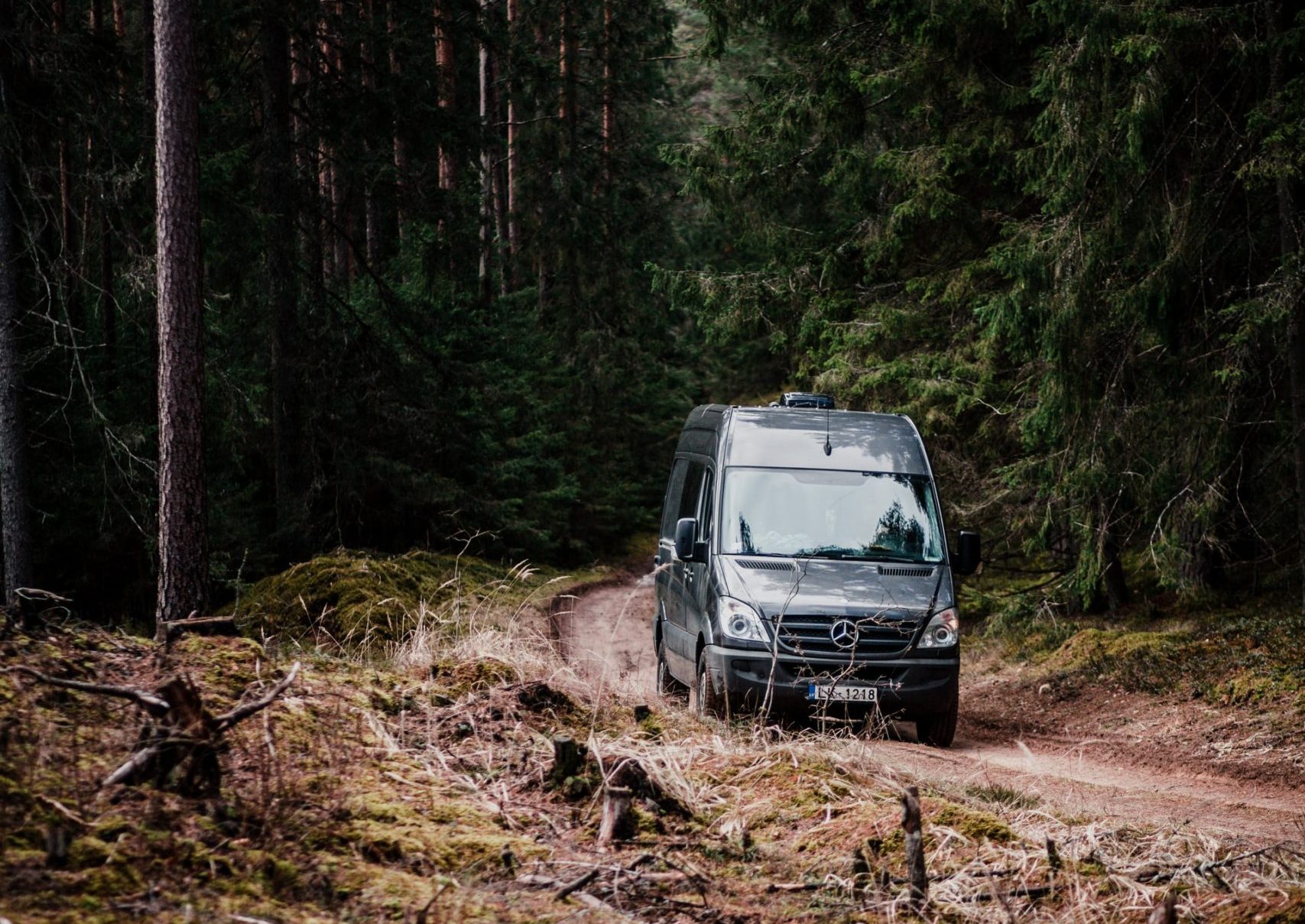
With the popularity of van life, conversion vans and different variations of Class B RVs have come to the forefront of the RV world. Campers and aspiring travelers can take advantage of the smaller size, common and easy to work on engine chassis, and that your home and RV are all in one.
Typically a campervan will cost more than the average travel trailer. On the other hand, you don’t have the cost of a tow vehicle if you don’t already own a capable one.
The main thing to keep in mind between an RV vs travel trailer is that you don’t get away from two vehicles. A lot of people think to get the RV and then they’ll have the vehicle and the living in one unit.
In the real world, that only works if you’re older and plan on going to specific places. If you’re not going to go anywhere once you’ve gotten to where you’re going, then an RV may make sense. Otherwise, travel trailers are the way to go.
Every product is independently selected by editors. Things you buy through our links may earn Vox Media a commission.
From Tiny Trailers to Huge RVs, a Definitive Guide to Every Type of Camper
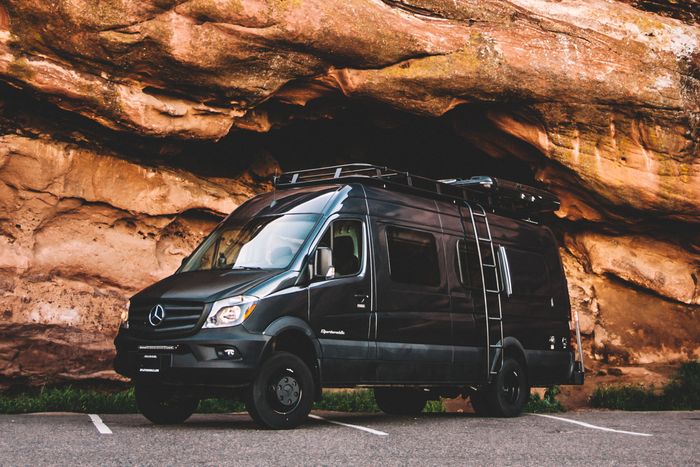
This story was originally published by Curbed before it joined New York Magazine. You can visit the Curbed archive at archive.curbed.com to read all stories published before October 2020.
There’s a lot to love about campers and RVs — that’s why we started a community group just for camper addicts. But even the most enthusiastic camper aficionado can get confused: What makes a Class C different from other RVs? Why is a fifth wheel trailer called, well, a fifth wheel? And are camper vans considered an RV or…something else?
Whether you’re looking to buy a new camper or just want to level up your camper vocabulary, this guide is a good place to start.
In the Recreational Vehicle (RV) world, you’re either towing something, or you’re not. It sounds simple, but that’s the first main distinction. If you’re not towing a trailer, then the vehicle and the living space are on the same chassis and you can always access the interior of your camper when you’re driving.
If you’re towing something, you’re likely pulling some sort of trailer. How much that trailer weighs and how you actually pull it depends on a few factors, and that’s what we break down in this guide. From Class A RVs to the tiniest featherweight trailer , here’s every kind of RV you can find on the road.
Class A RVs: The Biggest Beasts on the Road
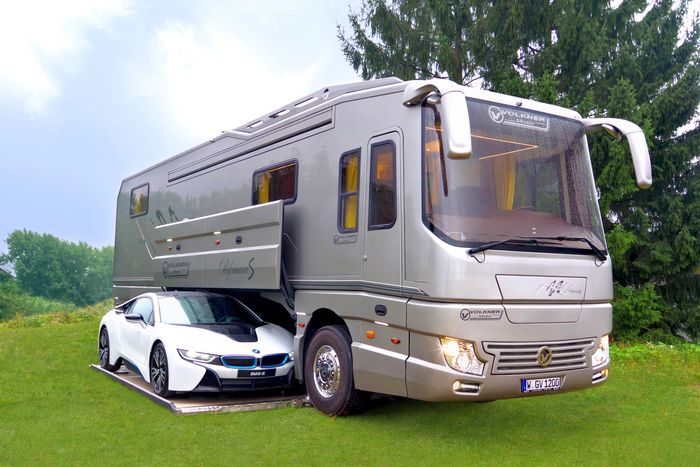
Size: 26 to 45 feet
Weight: 13,000 to 30,000 pounds
Details: The biggest motorized RVs on the market, Class As are like giant homes on wheels. They can be relatively simple or come with all sorts of bells and whistles , including over-the-top amenities like king-size beds, washer and dryers, and mobile garages that can hold a sports car . You get a lot of space with a Class A, and potentially some serious luxury. Another benefit is that you can usually tow a car behind a Class A. But Class As can also be very expensive, have low fuel efficiency, and are limited on where they can travel due to their size and hookup needs.
Class C RVs: A Mid-Size Option
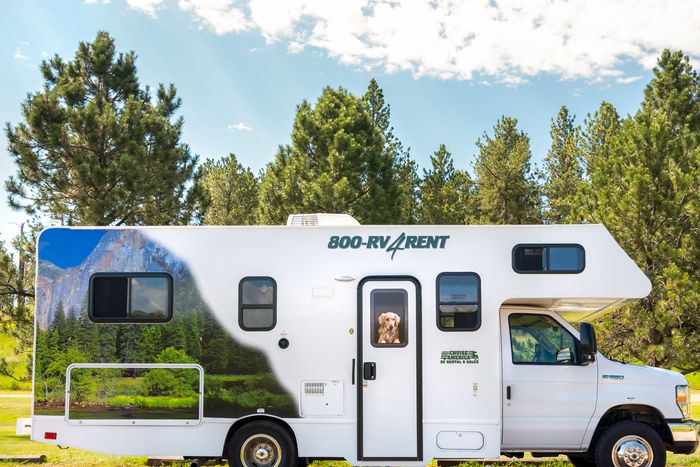
Size: 20 to 30 feet
Weight: 10,000 to 13,000 pounds
Details: Not quite as big as a Class A, but not as small as a Class B. Yeah, we know that’s confusing. Sleeping quarters in a Class C are often over the cab with another area in the back, and you might find slide outs similar to those common in larger Class As. Class C RVs usually have a separate bathroom area, whereas a Class B camper van might not. Class Cs work well for people who want something smaller and less expensive than a Class A, but think a camper van is too small. Note that Class C RVs usually aren’t big enough to tow another vehicle.
Class B RVs: Van Life and So Much More
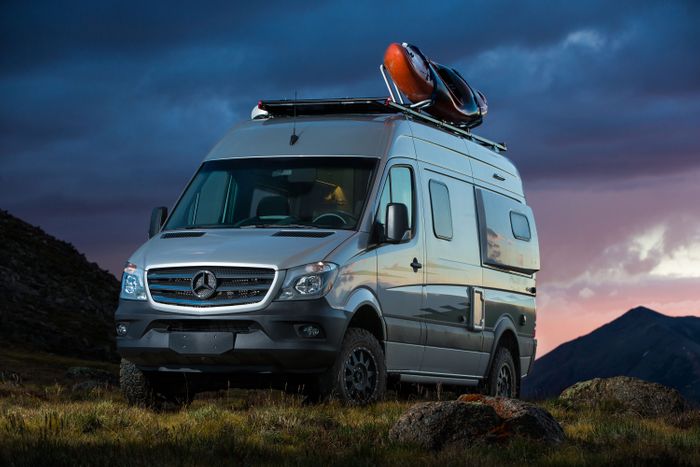
Size: 17 to 23 feet
Weight: 4,000 to 9,000 pounds
Details: Often called camper vans, Class Bs are a mid-size option that are much smaller than the big Class A RVs. Common van bases include the Mercedes Sprinter, Ford Transit, and Ram Promaster , and these small but mighty campers can be basic — think bed and storage — or have extras like bathrooms, dining areas, and room to sleep six . The biggest drawback is that you don’t get as much space or amenities compared to Class As and Cs, but there are also benefits to the Class B; some come in a four-wheel-drive option , get good fuel economy, can fit in many parking spots, can stay off the grid , and are easy to drive.
Travel Trailer: Big, Small, and Everything in Between
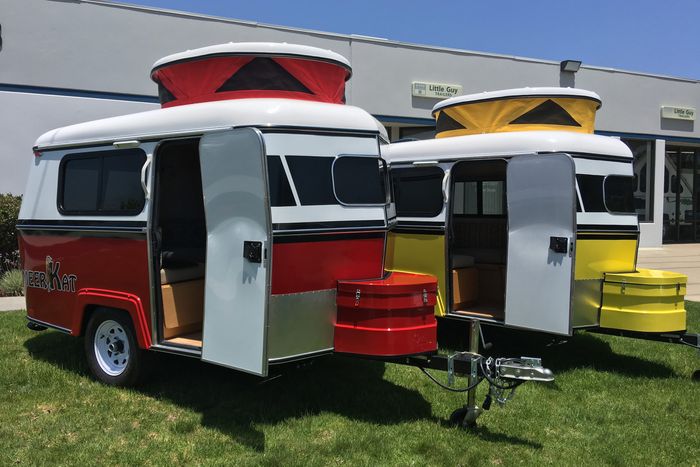
Size: 10 feet to 40 feet
Weight: 1,100 to 12,000 pounds
Details: There’s probably no greater range of campers in a single category than the travel trailer. Bumper pull travel trailers connect to a standard trailer hitch, and they can range from lightweight to fairly heavy. This means that the smallest travel trailers can be pulled by a small SUV, while others might require a large truck. Travel trailers are good for campers who want to unhitch and store the camper more easily when not in use, and a plethora of options means that there is something for everyone. Just how diverse is the travel trailer category? The 10-foot Happier Camper is a travel trailer, and so is the 33-foot Classic Airstream , a trailer that’s more than three times as large. You’ll also see convertible trailers , teardrops , and trailers with vintage style .
Pop-up Trailer: Compact and Easy to Store
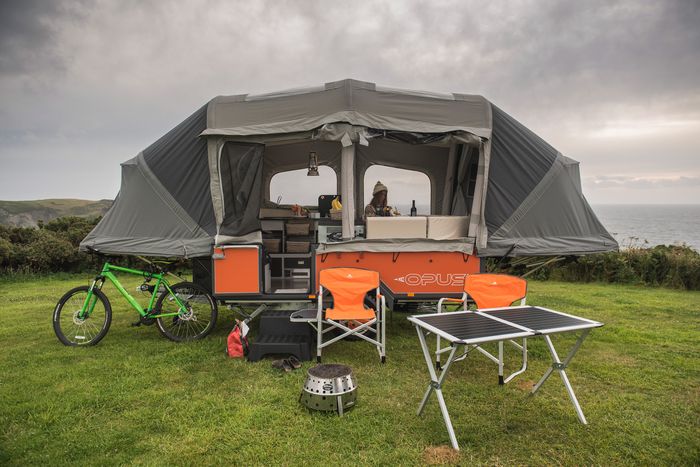
Size: 8 feet to 16 feet
Weight: 700 pounds to 4,000 pounds
Details: Also called a folding trailer, the pop-up trailer is a lightweight camper that folds into itself for easier storage and towing. Think of pop-up trailers as an alternative to a tent, since you get a similar open-air feeling , with a living area in the center and two sleeping areas on either side. Pop-up trailers are great if you don’t mind fewer amenities, can’t tow a lot of weight, and your main goal is to avoid sleeping on the ground. Many are also reasonably priced. The downside? Folding trailers aren’t as well insulated for weather — think of them as three-season camping tents.
Fifth Wheel: The Largest Trailer You Can Buy
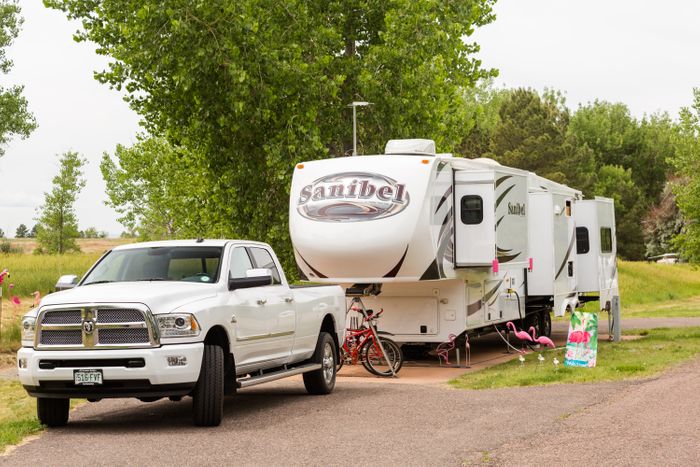
Size: 22 to 40 feet
Weight: 7,000 to 20,000 pounds
Details: Fifth wheel trailers are the largest trailers you can tow behind a vehicle. They are called “fifth wheel” because the front of the trailer extends over the bed of the truck. The truck bed contains the hitching mechanism — a u-shaped coupling component — which can make fifth wheels easier to tow than some other travel trailers since it’s easier to turn. Fifth wheels offer all the space and comforts of a Class A RV — including slide outs, bathrooms, and even multiple bedrooms — but they also require a pickup truck with a specifically fitted hitch. This type of RV is best for someone who wants all the amenities of a large Class A, but wants to tow it and then store it when not in use.
Truck Campers: From Weekend Campers to Expedition-Ready Vehicles
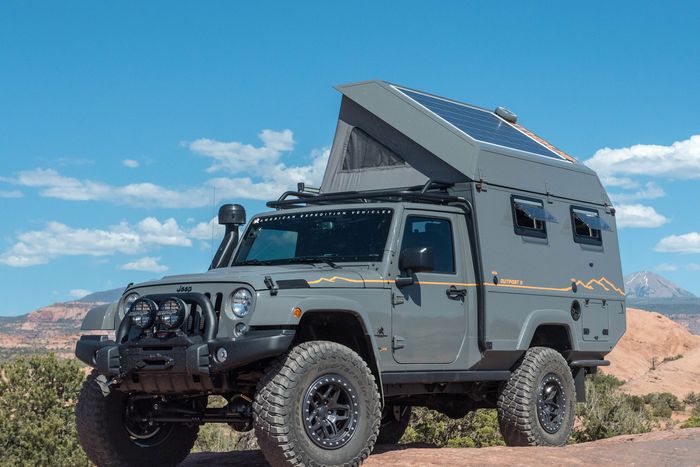
Size: A few feet longer than your truck
Weight: 1,000 to 5,000 pounds
Details: Truck campers like the one pictured above are best for traveling off-the-grid for weeks, months, or even years. This isn’t a camper meant for a large family; it works best for one, two, or a maximum of three people. Four-wheel-drive capabilities and burly suspension mean that these campers can go anywhere but have limited storage and only the most basic amenities. There are also truck campers with more amenities meant for regular campground stays; these often use a rear door and can include an overhead sleeping cabin. Options for truck campers include long and short beds, hard-side and pop up, as well as slide outs.
- corner shop
Most Viewed Stories
- ‘Please Don’t Hang Out Here’
- Tokyo’s Public Toilets Will Leave New Yorkers Sobbing
- This Week’s Worth-It New York City Apartment Listings
- Your Very Own Masonic Temple in Hillsdale
- The Squatters of Beverly Hills
- Brooklyn Tower Is in Trouble
Editor’s Picks

Most Popular
- Eva Alt Is Selling Downtown
What is your email?
This email will be used to sign into all New York sites. By submitting your email, you agree to our Terms and Privacy Policy and to receive email correspondence from us.
Sign In To Continue Reading
Create your free account.
Password must be at least 8 characters and contain:
- Lower case letters (a-z)
- Upper case letters (A-Z)
- Numbers (0-9)
- Special Characters (!@#$%^&*)
As part of your account, you’ll receive occasional updates and offers from New York , which you can opt out of anytime.
- Skip to primary navigation
- Skip to main content
- Skip to primary sidebar
- Skip to footer
Journey With Confidence
Class A RV vs Class C: Which One Is Right For You?

- RV Lifestyle
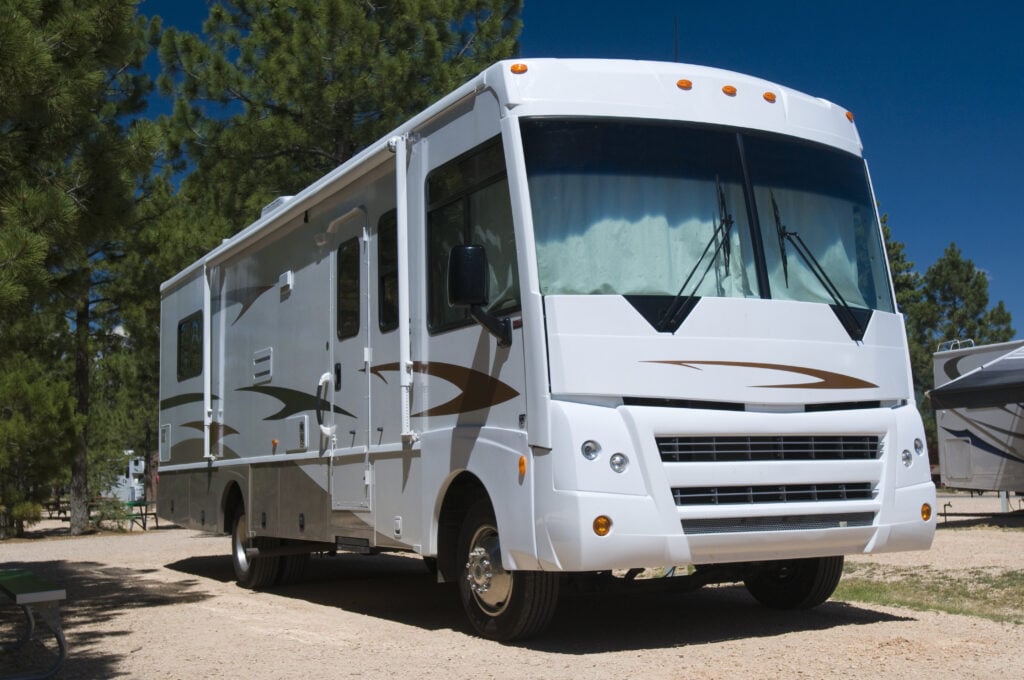
Should You Get A Class A Or Class C Motorhome?
If you’re looking for a new RV, you may have narrowed it down to a Class A or Class C motorhome. These are both popular builds that have some similarities. However, they have pros and cons that are worth considering. Of course, the best vehicle is the one that fits your situation.
These motorhomes are the most common ones to find on the market nowadays. Class B motorhomes (aka camper vans ) are great for short-term journeys, but they aren’t suitable for large groups or extended camping trips. Before you can find the perfect RV for you, it’s time to compare and contrast Class A and Class C motorhomes.
Class A RV Pros and Cons
Large build.
First of all, Class A motorhomes are some of the largest on the market. The only other models that come close are fifth wheels. Generally, a Class A motorhome will be at least 30 feet long, and some are closer to 40 feet. This gives you a spacious interior that has room for plenty of furniture, appliances, and open space. If you’re looking for the biggest option, a Class A is what you want.
Multiple slideouts
Because they are so long, these motorhomes can also accommodate a large number of slideouts. Most have at least one or two, but some have four or more. In some cases, there will be a single slideout that runs the entire length of the vehicle. Either way, there are plenty of ways to expand the usable space of these RVs.
Tons of undercarriage storage
If storage is a deciding factor between a Class A or Class C motorhome, choose a Class A RV. In addition to a wealth of interior closets, cabinets, and overhead storage, these vehicles are also equipped with storage lockers under the floor. These can be accessed from the outside, and they’re perfect for storing camping gear and other bulky items that wouldn’t fit inside.

Luxury designs and amenities
Because Class A motorhomes are so large and expensive, they can provide many luxuries and amenities that other RVs can’t. They are usually designed with high-quality furniture and decoration schemes. The appliances are also top of the line. If you’d like to have a luxurious road trip or campout, you can’t beat the comfort of a Class A motorhome.
One of the biggest drawbacks of a Class A RV is the price. Because they’re so large and luxurious, they cost a pretty penny. You can expect to pay at least $100,000 for a new model and sometimes closer to $250,000. That’s a significant investment that could go toward a cheaper RV or even a house! You need to be very committed to the RV lifestyle for this price to be worthwhile.
Gas guzzlers
Class A motorhomes are notorious gas guzzlers. You’ll pay quite a bit to fill them up, and you’ll need to do this frequently. So in addition to the high initial price, it’s going to remain expensive as long as you drive it.
A 30-40 foot vehicle is definitely a different beast compared to a typical car or truck. You may need to take special driving classes to feel comfortable behind the wheel. Even if you’re confident, a Class A motorhome is bulky and slow to respond on the road. It takes some getting used to and will inevitably spark some road frustration from the drivers around you.
Hard to find parking
Parking is also a challenge with one of these RVs. If you travel in urban areas, it’s going to be hard to find a spot that can accommodate you. Some campgrounds also have length limits, so you may be somewhat limited in your options there as well.
Class C Pros and Cons
One of the most significant benefits of a Class C motorhome is the lower price. They are smaller than Class A models, so you can definitely find a better price range.
Maneuverability
Generally, Class C RVs are easier to handle than their larger Class A counterparts, making them more suitable for navigating through tight spaces or busy campgrounds.
Maintenance
In many cases, Class C motorhomes are built on standard truck or van chassis. This means parts can be more readily available and mechanics more familiar with their engines, potentially leading to lower maintenance costs.
Easier resale
Due to their lower initial cost and popularity among a wider range of RV enthusiasts, Class C motorhomes can sometimes be easier to resell than specialized or luxury Class A models.
Less intimidating for novices
For those new to RVing, a Class C often feels less intimidating to drive and operate than a large Class A motorhome.
More fuel efficient
Class C motorhomes still require a good amount of fuel, but they are much more efficient than Class A models. They’re also easier to handle on the roads because of their smaller design. You can save money when you buy them and avoid costly refill trips.
Smaller than Class A motorhomes
Although there are various vehicle lengths, Class C motorhomes are generally smaller than their Class A counterparts. Even the largest options usually don’t come close. However, if you’re looking for a compromise between a Class A and Class C motorhome, you could always explore Super C RVs. They are essentially extra-large versions of the Class C design.
Less storage space
These vehicles don’t have the spacious undercarriage storage compartments. As such, they are limited in their ability to pack gear on long trips. While you can tow additional storage, it’s not the same as having everything packed into one vehicle.
Not as luxurious
While many Class C motorhomes are still quite luxurious, they might not have the same level of high-end finishes and amenities as a Class A. If you’re looking for the ultimate in RV luxury, Class A is typically where you’ll find it.
Limited slideouts
Compared to Class A motorhomes, Class C RVs generally have fewer slideouts. While this might not be an issue for everyone, if you’re looking to maximize your interior space with multiple slideouts, a Class A motorhome might be a better choice.
When it comes to choosing between a Class A or Class C RV, it really boils down to your personal needs and preferences. Both types of RVs have their unique strengths and weaknesses.
If you’re still having trouble deciding between a Class A and a Class C motorhome, consider the primary uses and needs for your travels:
Choose a Class A if:
- You require a lot of space.
- You plan on using your RV for full-time living .
- Storage space is a priority.
Choose a Class C if:
- You’re not comfortable driving a massive RV.
- You’re looking for a more affordable RV.
- You want a versatile vehicle that can serve multiple purposes.
We hope this guide assists you in your decision-making process. Purchasing a motorhome is a significant commitment, and we hope you find the one that perfectly suits your needs.
No matter what you choose, the most important thing is to ensure it aligns with your lifestyle, travel habits, and budget. Before making a final decision, it might be beneficial to rent each type for a short trip to get a feel for their differences in a real-world setting. This hands-on experience can be invaluable in helping you make an informed decision.
Comparing Class A RVs vs. Class B vs. Class C RVs
Picking out an RV is an experience that requires making some decisions. From deciding on how big of an RV you need, to choosing which amenities are must-haves for your family, RV shopping is a complex process.
However, choosing a motorhome doesn’t need to feel overwhelming. Armed with the right information makes it easier to navigate the variety of RV types on the market.
If you are on the hunt for a new RV, check out the following guide for a breakdown of the differences between Class A , Class B , and Class C RVs. This guide will help you make choosing the right one for your needs easier.
What is a Class A RV?
Whenever you think of a luxury RV, you are probably envisioning a Class A RV . Class A RVs are one of the largest options on the market, ranging anywhere from 29 to 45 feet in length.
Not only are Class A RVs the largest on this list, but they are also the RV type most likely to feature high-end amenities and premium interiors.
Class A RVs are a go-to choice for those who want to travel without sacrificing any of the comforts of home.

What amenities are included?
Due to the ample space a Class A motorhome offers, these RVs come equipped with almost any amenity you could imagine. All of the following are options for Class A RVs:
- Full kitchen, including a full-sized refrigerator and stove
- Full bathroom, including a sink, toilet, shower, and bathtub
- Multiple sleeping spaces
- A master bedroom with a door that closes
- Dedicated dining area
- Extra seating for passengers complete with seat belts
- Slide-out deck
- Electric awning
- Living room with couches and seating
- Entertainment center
- Slide-out storage on the exterior of the RV
- Built-in exterior tables, grills, and other camping equipment
What amenities are found in a particular Class A RV will depend on the make and model, but generally, with a Class A motorhome, you can expect the ultimate in luxury on the road.
When is a Class A the right choice?
Class A is a great fit for large families, retirees, and anyone who desires camping in comfort. Many Class A RVs are also available with premium interior upgrades, such as hardwood flooring, marble countertops, and leather seating.
Class A motorhomes, however, are not a good pick if you plan to drive down tight roads or visit campgrounds with size limitations for campers.
Class A RVs for Sale
Check out the best in RVs.
2024 Newmar King Aire 4596
at Transwest of Belton, MO
New Class A
- See Details
- Confirm Availability
2024 Newmar Ventana 4037
3 Slide Outs
2022 Newmar Kountry Star 3717
at Transwest of Frederick, CO
Used Class A
4 Slide Outs
3,558 Miles
Contact Transwest
2023 Newmar Bay Star 3225
Sale Pending
2017 American Coach American Dream 45A
32,072 Miles
2019 Newmar London Aire 4543
38,557 Miles
2023 Newmar King Aire 4521
at Transwest of Fountain, CO
2023 Newmar King Aire 4531
2023 newmar ventana 4068.
at Transwest of Grand Junction, CO
2023 Tiffin Allegro Bus 45 OPP
What is a class b rv.
On the other end of the spectrum of RV types are Class B RVs . These motorhomes are designed to be compact and easy to navigate. Most Class B RVs range from 18 to 24 feet in length. They’re also known as camper vans.
While not all Class B motorhomes are built on a van chassis, many of them are. These smaller campers are easily parked in a normal parking space and don’t require special storage.
Class B RVs are often chosen by solo travelers, couples, and those who wish to traverse off the beaten road.

Although they are small in size, Class B motorhomes still pack in the amenities. When shopping for Class B RVs, you can expect the following amenity options:
- A sleeping space that is often convertible or tucks away into a wall to free up space
- A small dining area
- A kitchenette
- A small bathroom
- Storage space
- Solar setup for boondocking
- Off-road capabilities, such as 4x4 options or upgraded trail tires
The exact amenities found in a Class B camper vary greatly based on the size of the chassis and the manufacturer.
When is a Class B the right choice?
Class B RVs are an ideal pick for one to two travelers. They are a wonderful choice for those who wish to visit harder-to-access campsites or campgrounds with strict limitations on vehicle sizes. A Class B RV might not feature the luxury of Class A, but it makes up for it in versatility and easy maneuverability.
Class B RVs for Sale
2023 winnebago solis 59p.
New Class B
19ft 9in Long
2024 Pleasure-way Plateau XLTS
2024 winnebago revel 44e.
19ft 7in Long
2025 Winnebago Revel 44E
2023 winnebago adventure wagon 70 se.
Used Class B
2023 Winnebago Travato 59KL
2023 winnebago travato 59g, 2024 winnebago solis pocket 36b, what is a class c rv.
Landing somewhere between the high-end luxury of a Class A RV and the adventurous spirit of a small Class B van, a Class C RV ranges between 21 and 41 feet long and offers a little bit of both RV styles.
These RVs are easier to maneuver than a Class A but offer a few more amenities and space than a Class B.
In many cases, a Class C RV is equipped with additional slide-outs that feature extra sleeping space, making them a great fit for families.

A Class C RV has enough space to feature a similar setup to a Class A RV. The following are all common features of a Class C motorhome:
- A full bathroom
- A full kitchen
- A slide-out deck
- A built-in awning
- A dedicated dining area
- Extra seating for passengers
- Closets and storage space
- Outdoor storage
When is a Class C the right choice?
Class C RVs are a great choice for families who need more room than a camper van but don’t want to maneuver the length of a Class A RV. Class C RVs are allowed in most campgrounds and can handle a lot of the same roads that a Class B can tackle.
These RVs are an ideal blend of amenities and improved fuel efficiency.
Class C RVs for Sale
2022 winnebago navion 24d.
Used Class C
1 Slide Out
7,491 Miles
2024 Winnebago EKKO 22A
New Class C
2024 Winnebago Navion 24 J
2024 renegade veracruz 30 vrm, 2023 winnebago navion 24v, 2025 winnebago ekko 23b, 2018 leisure travel van unity u24mb.
60,200 Miles
2024 Winnebago Vita 24P
24ft 5in Long
2023 Winnebago Navion 24J
25ft 6in Long
What's the difference between a Class C RV and a Super C RV ?
A Super C RV is just like a Class C RV in many ways, but uses a different type of fuel and has a more powerful engine.

A Super C RV features a heavy-duty front-engine chassis and is powered by diesel fuel instead of standard unleaded gas. Super C RVs also often feature an overhead bunk and attached cab.
When deciding between a Class C RV and a Super C RV, your considerations may include whether or not you need to tow vehicles or other equipment with your motorhome. A Super C is more capable of this task due to its powerful engine. If you'd prefer to avoid using diesel fuel, a Class C RV may be better for you.
Shop Our Quality Inventory of RVs
The best way to determine which type of RV is best for your needs is to check out each RV style in person. At Transwest, we carry a quality inventory of Class A, B, and C RVs.
Our experienced staff will be more than happy to walk you through each style of RV. We can help you determine which type will be the ideal pick for your adventures.
Not only do we carry a premium selection of RV types, but we also carry a variety of motorhomes designed by the leading RV manufacturers, including Newmar , Tiffin , Winnebago , Thor , Cimarron , Logan Coach , and more.
Come visit us today and find the right RV for your next adventure.
Keep Reading
Four of the best routes for rv trips.
Are you new to the RV Life? Are you looking for a drive that is challenging? Or maybe you just want to mix things up and try something you’ve never done....
Shopping For A Vehicle
Introducing newmar’s 2024 lineup.
The RV industry has come to expect nothing less than top-of-the-line from one of the leaders in luxury motorhome manufacturing, and Newmar’s 2024 lineup i...
The Ultimate Guide to Road Trip Snacks
Planning a road trip involves a lot of things. You have to pick a destination, choose the route that is best for you, pick out the dates, and maybe even set a b...
25 Ways to Celebrate the Holidays in an RV
The holiday season is a magical time of year, and the luckiest among us will celebrate it by hitting the open road in our RV. Whether you're a full-timer or j...
10 tips and tricks to winterize your RV
Some folks in our community are lucky enough to RV full-time , but if you’re like many people, cold weather marks the end of your RV excursions in favor...
10 unexpected items you should bring on every RV adventure
If you’re here, you already know that RVing is about so much more than just the destination. It's also about the unexpected detours and spontaneous moment...
Pros and cons of a grill on an RV trip
For some people, bringing a grill on an RV trip is a no-brainer. Others don’t necessarily prioritize cooking while on vacation or prefer to use their RV k...
10 tips for a smooth RV trip with kids
RV trips with kids can be a delightful adventure and a way to create lasting memories for everyone onboard. But truly amazing trips don’t just happen on t...
Journey into Other Topics
Our industry experts are here to help.
Find your perfect RV
Interested in this vehicle.

Class A Motorhomes: Everything You Need to Know Before Buying
Want to travel the rolling hills of the midwest, the majestic mountains of the west and the diverse city terrain of the east all while enjoying the full comforts of home? A motorhome might be the perfect RV for you. Motorhomes are a classic yet modern RV that is a fantastic option for a low-maintenance, relaxed RV experience.
There are multiple different types of RVs that differ based on their design. Motorhomes, specifically, are unique because they are driven, not towed, like travel trailers or fifth wheel RVs. If you’re interested in travel trailers, you can read our ultimate guide to buying travel trailers . And if you want to explore all RVs, you can read our guide to buying RVs .
Key Takeaways:
There are three types of Motorhomes, Class A, Class B, and Class C. Class A Motorhomes are the largest and most expensive motorhome type, but they offer every amenity you could ever want out of an RV.
Most New Class A Motorhomes cost between $100,000 and $200,000
Prepping and driving a Class A Motorhome might be easier than you thought.
Table of Contents
What is a Motorhome?
Motorhomes are completely self-contained RVs that require little to no setup and have room for your passengers to move about while on the road. There are 3 different classes of motorhomes: Class A, Class B, and Class C.
The phrase ‘motorhome’ and ‘RV’ (recreational vehicle) tend to be used interchangeably, however, many people say RV when they actually mean motorhome.
RVs are any recreational vehicle – Class A Motorhomes, Class B Motorhomes, Class C Motorhomes, Toy Haulers, Travel Trailers, Teardrop Trailers, Fifth Wheel Trailers, Hybrid Trailers, Pop Up Campers, Truck Campers, and Towables.
Motorhomes are types of RVs that you can camp in and drive while also having space to move around. Driving a motorhome can take some practice because you have to change your driving techniques to accommodate for the extra length and weight.
What is a Class A Motorhome?
Motorhomes come in many different shapes and sizes. A Class A Motorhome is probably the most classic RV, and by that we mean, when you picture an RV in your head, a Class A is likely what comes to mind. Here’s an example of what many Class A’s look like today:

Class A motorhomes are not only the largest and most expensive, but they are also the most common RVs, which is why these big, boxy bus-style rigs are most preferred by full-time RVers.
Class As are built using a heavy-duty frame that is built on either a commercial bus chassis, a commercial truck chassis, or a motor vehicle chassis. There is also room to move around while you’re on the road and usually a minimum of two slide-outs to increase living space at the campsite.
Class A motorhomes can comfortably fit 4-8 adults, but some can hold up to 10 or 12, especially if some of the passengers are children. Usually, there is a master bedroom in the back as well as couches that fold down into beds in the living area and sometimes lofted sleeping areas in the front or back of the rig.
For quality and luxury, the Class A motorhome is the way to go, as they not only offer more living space, they offer more storage space as well. Let’s take a look at the benefits of owning a Class A motorhome.
What are the Advantages of a Class A Motorhome?
The most motivating reason to get a Class A Motorhome is convenience, comfort, and space. These really are hotels on wheels. Passengers can move about the motorhome freely while the vehicle is in motion. This means it is closer to riding on a private train or airplane than traveling in a traditional car.
There is tons of storage in Class As. Most of them have a full king sized bed in their master suite as well as standard kitchen-sized refrigerator and oven for cooking. Most Class As have at least 1.5 bathrooms if not two full bathrooms so there is never a line to use the facilities.
Many Class As even have pop-outs to make the living and sleeping areas even more spacious for the passengers. There are tons of reasons to love a Class A Motorhome, but sipping on a coffee and watching TV while someone else drives you around the country is a pretty good one.
Benefits of a Class A Motorhome:
Ample space and roomy interior
More power and towing capability
Better visibility due to height
Smooth ride
Plenty of storage
Large tank capacity
AC and Heat
Built in Laundry facilities
Smart floor plans that utilize space
No need to worry about a hitch or towing
Class A Typical Weight: 33,000-36,000 pounds
Class A Typical Length: Up to 45 feet
What are Some of the Best Class A Manufacturers, Models, and Brands?
Now that you understand exactly what a Class A is, let’s talk about the folks making them. From retro-style Airstream to family-owned Tiffin, there are so many RV manufacturers, brands and models available in the industry, it can be overwhelming at first. It was hard for us to narrow down the list, but we’ve rounded up some of the top Class A Motorhome manufacturers and brands in the industry to help you get started.
Tiffin Motorhomes is a family-owned private company that offers smooth and quiet rides with smart driving and features that are built for experiences. The luxurious Allegro Bus is their most popular model for those who enjoy full-time RV living. Tiffin’s Class A products include the Allegro, Allegro Breeze, Allegro Red, Phaeton, Allegro Bus and Zephyr.
Thor Motor Coach is one of the most popular brands in the industry. They offer many different sizes, layouts, and pricing for Class A, B, and C motorhomes. Popular Thor Motor Coach Class A models include the Tuscany, Venetian, Challenger, Axis, and Palazzo.
Winnebago offers a wide range of RVs to choose from. From quality construction Class A diesel motorhomes with spacious living to a number of comfortable Class C motorhomes, they all offer a wide range of Winnebago’s key features to keep you comfortable. Popular Class A Winnebago motorhomes include the Adventurer, Vista, Forza, Journey, and Sunstar.
Entegra manufactures luxury Class A and Class C motorhomes that run on gas or diesel fuel. They have been a part of the Jayco family since 2008. Just this year, Entegra launched an all-new Class B Camper RV to their already impressive lineup. A new Class A from Entegra runs anywhere between $330K all the way up to over $800K for some models.
Newmar hand-builds each coach one by one and they have been for 50 years. They offer luxury, diesel, and gas Class A motorhomes and their mobility lineup features the world’s leading wheelchair-accessible Class A coaches. Explore the Newmar luxury motorhome lineup, which includes King Aire, Essex, London Aire, and Mountain Aire. Other popular Newmar models include Ventana, Bay Star, Canyon Star, and Dutch Star.
Forest River is one of the largest manufacturers of quality RVs who offers a variety of models and floorplans. They offer a wide range of motorhome brands to choose from so you can find one that fits your needs. Popular brands include Coachmen , Georgetown, and Forester.
How Much Does a Class A Motorhome Cost?
Class A Motorhome pricing is strongly influenced by size. You can safely assume that the longer and heavier a motorhome is, the more it will cost. However, in general, Class A Motorhomes are one of the most expensive categories in the entire RV space. They are the largest of the Motorhome style RVs, and they include much more space and technology than a travel trailer or a fifth wheel.
On average a Class A Motorhome will cost around $100,000 to $200,000+.
Prices can vary depending on how new the motorhome is, what brand or manufacturer it is from, who is selling it, the amenities, special features, upgrades etc. Here are some examples of new and used Class A prices currently available:
*If you are going custom, prices are unlimited.
If you are considering making the leap and investing in a Class A Motorhome, most of us will need to finance these behemoth vehicles. Find out the best tips and tricks to get the best possible loan rates with our Finance Guide . Worried about your credit and how it might affect your loan for a Motorhome? We’ve got you covered. Just because your credit isn’t in the best shape doesn’t mean you can’t afford a Motorhome. Learn more with our Guide to Getting a Loan with Bad Credit.
How to Finance a Motorhome
A motorhome can cost a pretty penny. Most people will need to take out a loan in order to purchase one. If you do take out a loan, you want to make sure you get the best possible loan rate, so that you owe as little interest as possible. Searching for good loan rates and negotiating pricing can be daunting. Luckily, we have a Definitive Guide to RV Loans that goes over everything you need to know about how to finance an RV.
Concerned about your credit and how your score might affect your ability to finance or purchase a motorhome? Educate yourself on how to use the tools in your shed to still get the best rate possible with our Guide to Bad Credit Loans.
How to Buy a Class A Motorhome
If you are interested in purchasing a Class A Motorhome, you have one choice to make first: new or used. There is no wrong answer, but it does impact where you look for your dream motorhome. If you are interested in a new Class A, finding a RV dealer in your area or reaching out directly to your manufacturer of interest is the best place to start.
If you are open to new and used, you can check some of these places for available inventory:
Facebook Marketplace
Newspaper Ads
RV Dealerships
GoRollick Buying Experience
Just like cars, motorcycles and boats, new RVs are sold through franchised RV dealers. Simply head to google and search for Class A Motorhome dealers in your area. Remember, most dealers will only sell one or two brands, so consider deciding which brand you want to purchase before visiting a dealership.
If you are feeling ready to search inventory, we recommend you start with GoRollick ’ s nationwide network of new and used inventory.
GoRollick works with the best dealers in the country who are dedicated to price transparency and a great buying experience. With GoRollick you can get an upfront price and a special offer on your next golf cart, plus savings on after-purchase products. Then when you’re ready, you can shop at one of our Certified Dealers. GoRollick also ensures that you get access to all available manufacturer incentives. If you’re curious about what’s currently available, you can check out our incentives page here.
Not quite sold? Maybe this will help. Use our guide on How to Take Advantage of Powersport and RV Manufacturer Incentives on Your Next Vehicle Purchase to get the most bang for your buck, and when you are ready to buy, check out our list of the latest available manufacturer incentives to ensure you are getting the best price available.
Where Can I Park My Motorhome When Traveling?
As much fun as the drive itself might be, there is usually an equally as exciting destination awaiting your arrival. When you get there, or on your way, you will need to stop and park your RV somewhere safe and legal. For more information on RV traveling tips check out 6 RV Rules You Didn’t Know About .
There are several places you can park your motorhome while you are on the road. Many of these places are safe, free and available for temporary parking, you just have to know where to look. One of the best and easiest places to park for an overnight break from driving is a truck stop, but these can fill up quickly. Also look at places like Walmart, K-Mart, Lowes, Home Depot, Cabelas, and Camping World for quick, overnight, dry camping.
Pro Tip: Dry camping means there are no hook-ups for water, gas, or electricity. You will only have what is already onboard your RV and you will not have a place to dump your tanks when dry camping.
If you are looking for a stop along your trip, there are literally hundreds of beautiful state parks, national parks and RV campsites for RVs to set up for anywhere from a night to a few weeks, dry or wet. Check out Campendium or GoodSam or to find RV parks and campgrounds and to check their price, availability and amenities.
If you need some more concrete ideas on where to park your motorhome while you’re on the road, check out our list of the Top 10 Best RV Parks in America and plan your next trip! There is a wide variety of RV Parks and campgrounds across the country that range from $15 a night to $45-$50 a night.
Common Questions About Motorhomes
Even though motorhomes are the most common RV you might think of, something about them can seem intimidating if you aren’t already familiar with motorhomes. Especially the massive size and power of a Class A. You might have some (totally normal) logistical questions about what you need to know before you rent, drive, or buy one of these bad boys.
Below are some of the most common Class A Motorhome questions:
Do I Need a Special License to Drive a Motorhome?
The requirements for a special license are dependent on two factors:
Where you live and are planning to visit
How much your RV weighs
You can just use your regular drivers license to operate RVs that weigh less than 26,000 pounds. However, in certain states (listed below), if your RV is over 26,000 pounds, you will need a special license to operate the rig. Usually this is a CDL (Commercial Driver’s License), which is something many states require for heavier vehicles, such as 18-wheelers or vehicles towing large trailers.
The following states require special licensing for rigs over 26,000 pounds:
Connecticut
North Carolina
Pennsylvania
South Carolina
Washington, D.C.
Some of these above states require a traditional CDL while other have more unique license requirements such as a Class A, B, C, or E addendum to your regular driver’s license.
In order to get a CDL, you will need the following:
21 years or older
A spotless driving record
A valid driver’s license
Pro Tip: Keep in mind that some states require different license classes and have different length and weight requirements. It’s always a good idea to check your state ’ s specific laws or local DMV before you hit the road. If you want to be sure to avoid any confusion with licensing, choose a smaller RV such as a Class B or C. Here is a link to the CDL State-by-State requirements.
Do I Need Insurance for a Motorhome?
Most state laws require motorhomes (and all vehicles) to have minimum liability insurance coverage if you are driving on the road.
Liability Coverage Includes:
Bodily injury liability
Property damage liability
If you travel often or are living in your RV full-time, you should consider additional insurance coverages. You should also consider additional coverages if you took out a loan to finance a motorhome or if your RV is a rental. Additional coverages can include things like collision, roadside assistance, uninsured/underinsured, total loss and more. Learn more about RV coverages here .
Can I Claim My Motorhome as a Residence for Tax Purposes?
Yes, you can claim your motorhome as a residence for tax purposes, but there’s a catch.
The IRS allows taxpayers to designate only one residence only as a main home at any one time. That means that the “main home” must be the one where you ordinarily live most of the year — and if that’s your motorhome it must have all of the proper facilities.
Most people claim their motorhome as their secondary residence if it qualifies as a second home. The benefit of treating your RV as either a primary or secondary residence on your tax forms is to take allowable homeowner tax deductions that can decrease your overall tax bill.
Pro Tip: As long as your RV is security for the loan used to buy it, you can deduct mortgage interest paid on that loan.
Check Out More Helpful RV Guides and Articles
RVs and Motorhomes are a fantastic way to travel as a group. They allow you to bring your home, and all the comforts that go with that, anywhere you like. The US in particular has some of the most stunning national parks and hidden gems to visit and utilizing an RV or motorhome makes for the perfect vacation full of memories.
If you are interested in purchasing, selling, or upgrading an RV, we have all the information you need. Below are some articles and guides we’ve curated to answer any of your RV questions so you can move forward feeling confident you made the right choice for you and your family.
How to Sell Your RV
Advice for First-Time RV Buyers
Renting Your RV: A Money-Making Guide
RV Classes: The Ultimate Guide
GoRollick Marketplace – Find the Perfect Motorhome
When you’re ready to find your next Motorhome, be sure to check us out at GoRollick.com .
See nationwide inventory, specs, and incentive information
Get an upfront, transparent price on your desired Motorhome
Receive special offers on both the Motorhome as well as additional accessories
Take advantage of Bonus Savings plus the option to Buy From Home from select Certified Dealers
Shop at one of our Certified Dealers who are committed to providing an exceptional buying experience
Check out and Subscribe to the GoRollick YouTube Channel to watch reviews, test rides, and more!
You may also like

How To Save (And Make) Money With Your Own RV

Top 10 Ways to Get Outdoors in 2023
Leave a comment cancel reply.
Your comment
Get access to exclusive deals, updates on manufacturer rebates, and product reviews and test drives
Where to Park an RV
Choosing the Right RV
RV Park Review Sites
Reserving a Parking Spot
Music Festivals
Disney World
National Parks
Best for Families
Dog-Friendly RV Parks
RVing With Alcohol
Driving on Icy Roads
Accident and Emergency Guide
Best Weather Apps
How to Find Cheap Rentals
RV vs. Motel: Where to Stay
Guide to RV Warranties
Budget-Friendly Parking
Best RVs to Buy
Maximizing Gas Mileage
Buying an RV
Towing a Car
Turning an RV
Cleaning an RV
Sleeping Tips
Propane Guide
Pros and Cons of RV Travel
Motorhome vs. Towing a Trailer
Should You Drive a Motorhome or Tow a Trailer?
MCCAIG / Getty Images
The top reason many RVers give up on the lifestyle is towing. Towing consists of using your car to pull a trailer behind you. 5th wheel RVs , travel trailers and campers are some examples of recreational vehicles you can tow. With the growing popularity of teardrop trailers , everyone thinks they can pull whether they know how to or not. It takes some time to learn how to tow and for some drivers, the learning curve is too difficult to overcome. They either walk away from RVing or turn to motorhomes as an alternative.
Towing is a hurdle some can't overcome, but luckily you can drive a motorhome instead. Let's look at motorhomes and trailers to see what's right for you so you can take to the road and get adventuring.
What You Need to Know About Driving a Motorhome
Motorhomes are self-propelled RVs. They have a built-in engine, allowing you to drive it back and forth. Motorhomes are the most expensive types of RVs on the market. They offer full living accommodations, including bedrooms, bathrooms, living rooms and storage. They are fully customizable making them a versatile option for travelers looking for more on the road. Retirees, full-time RVers, telecommuters, and others are ditching the traditional home and living on the road traveling and seeing the world around them.
When driving a motorhome, you must get used to how big the RV is. This can make clearing train tracks, making turns, and switching lanes more difficult as you have a significant blind spot to work with. Once you get the hang of driving a motorhome, it becomes more comfortable over time and is an option for those who can't get a handle on towing a trailer.
Pro Tip: Motorhomes come in a variety of sizes and price ranges, they're not out of reach of the average consumer anymore. You can find one comfortable to drive to your favorite destinations by visiting an RV dealership and touring them in person.
What You Need to Know About Towing a Trailer
Towables include any trailer or RV that needs to be towed by another vehicle. These types of RVs are hitched to the truck and can be more difficult to control when turning and switching lanes. Depending on the size of the recreational vehicle, you can tow with something as small as a motorcycle. If you invest in a 5th wheel trailer or an expandable travel trailer, towing becomes more difficult until you're used to handling the setup on the road.
When towing, you're dragging an RV behind you. This means that the RV doesn't always react the way your towing vehicle does. If you don't know how to handle when the trailer begins to sway, you can cause an accident. This can scare potential RVers because they must learn how to drive all over again when towing a trailer. Luckily, many RV dealerships and automotive clubs offer classes on towing a trailer to help teach you best practices on the road.
Pro Tip: Towing can be done with something as small as a motorcycle. You may be able to tow and not even realize it because your vehicle didn’t come with a tow package.
Should You Learn How to Tow Before You Decide?
RVing comes down to personal comforts on and off the road. Luckily, there are options out there to help you learn how to handle a motorhome or tow a trailer. Some states require you to pass a class to tow a vehicle before you register the RV. Some states encourage you to practice, allowing you to register the RV but never checking up on you after that.
If you're ready to buy an RV , you're going to be driven by your budget, which will most likely limit your ability to buy a motorhome from the start. Most RV dealerships will allow you to test tow RVs around the lot, giving you the chance to see how towing works and see how comfortable you are with it. From there, you can determine if learning how to tow is worth the effort.
Learning how to tow an RV isn't easy, but with practice, it can be done. You'll learn more by hitting the road towing than you will be watching videos and taking classes.
Practicing towing in your neighborhood is the first step followed by learning how to back up an RV and parking it. The more you take the time to learn how to tow and handle any issues that come up, the more comfortable you'll be towing .
Which RV Option Is Right for You?
If you make an effort to learn how to tow, trailers are the cheaper and more worthwhile option for first-time RVers. Motorhomes are meant for those looking to invest in full-time RVing or retirement.
Not everyone can get over the learning curve towing presents. You must examine all options out there, try out towing and then make the right choice based on your comfort level.
Planning an RV Trip: The Complete Guide
Your Guide to Class B+ Motorhomes
9 Tips for Maximizing RV Gas Mileage
Everything You Should Know Before Renting Your First RV
RVing 101 Guide: Towing
How to Tow a Car Behind Your RV
RVing 101 Guide: Turning an RV or Trailer
These Luxury RVs Are Reimagining Home on the Road
The Best RV Rental Companies
Everything You Ever Wanted to Know About RV Types
Comparing Hitches: Bumper Pull vs. Gooseneck
10 Cool Ways to Upgrade Your RV
The 4 Classes of Motorhomes
Your Guide to Travel Trailers
The Only Guide You Need to Buy an RV
Scenic California Drives: 7 Routes That Will Make You Swoon
- Skip to main content
- Skip to secondary menu
- Skip to primary sidebar
- Skip to footer

Jeffsetter Travel
Travel Consultants and Travel Tips
13 Best Class A RVs In 2024
April 27, 2022 by August Croft
Last updated on March 24th, 2024 at 12:40 pm
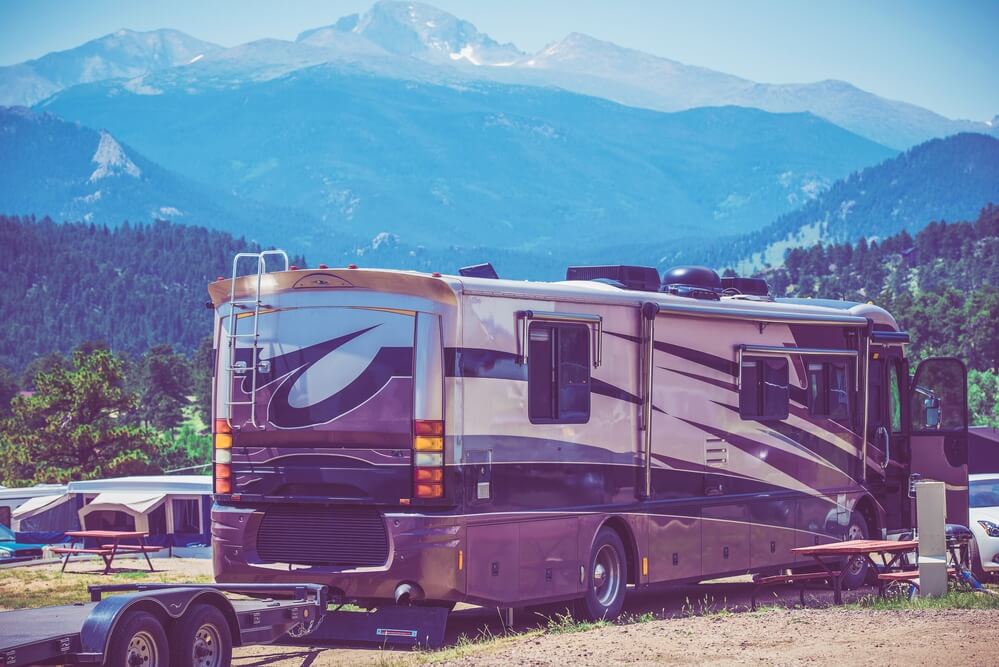
All of our reviews are based on exhaustive research, industry experience and whenever possible, hands-on testing. When you make a purchase using one of our chosen links we’ll receive a small percentage of the proceeds. This supports the site and keeps Jeffsetter running. You can read more here .
With so many RVs on the market today, you may be wondering what some of the best Class A RVs are in 2023. Keeping an eye on new releases and top-reviewed RVs is essential to making an informed decision, knowing exactly what to look for in an RV purchase.
In this article, we’ll address everything worth considering about a Class A RV purchase , including giving our list of the best Class A RVs in 2024! By the end of this article, you should have a clear understanding of what matters in a Class A RV, including some fantastic makes and models to look at.
Only interested in checking out our list of Class A RVs? Use the table of contents below to jump ahead to our 13 Best Class A RVs in 2024 now!
What Is A Class A RV?
A Class A RV is the largest type of motorhome available on the market. These rigs can run on either gasoline or diesel fuel, and they often have a fairly sizable towing capacity as well as living space. Most Class A RVs range in length from 25 feet all the way to 45 feet, if not more. They range in terms of luxury finishes and available living and sleeping arrangements, but given the size of Class A rigs, they are highly diverse and unique.
While not everyone is ready to drive a rig as large as a Class A motorhome, the size of these RVs makes them ideal for just about any family or camper. You may want a Class A rig to live in full-time, or maybe you’re interested in the larger sleeping capacities afforded by a longer Class A. No matter the reason you want one, Class A RVs suit a wide variety of people.
They aren’t necessarily cheap, especially by other RV standards. You can get a 45-foot-long travel trailer for much less money compared to a 45-foot Class A RV. However, many RVers enjoy the freedom and flexibility of a Class A RV. These rigs are large enough to tow a conventional vehicle behind them so you can park your RV at camp and hit the road in something a bit easier to drive .
What To Consider In A Class A RV?
Whether you’re a seasoned RV owner or simply brand new and want to learn a bit about Class A RVs, there are a number of considerations worth making before purchasing a Class A RV!
One of the most important things to consider when making an RV purchase of any type is the floor plan. It can be pretty difficult to determine what sort of floor plan or layout you need without touring or trying some different ones out first. Given their impressive length and versatility, Class A RVs have a staggering number of layouts and floorplans available.
There’s a Class A RV for everyone, including large families and couples , as well as solo travelers looking to live in their RV full-time. A few things to keep in mind include how much space you need in your kitchen, how large your bathroom needs to be, and whether or not you need amenities to suit full-time living, such as washers and dryers and master bedrooms.
Some Class A RVs have innovative bunkhouses and other sleeping arrangements for groups of children or young adults. Much of the furniture inside a Class A is convertible, providing even more sleeping arrangements when it’s time for bed. Plus, depending on the floorplan, there may even be the opportunity for electric fireplaces and secondary bedrooms or bathrooms. The sky’s the limit in terms of a Class A floor plan!
We’ve already mentioned this, but budget is absolutely something to keep in mind when considering a Class A RV purchase. These motorhomes are among some of the most expensive on the market today, depending on their size and luxurious features. It’s rare to find a brand new class A RV for less than $100,000. This is something to note, as many modern motorhomes average anywhere from $150,000 to $250,000 if not far more!
Some of the rigs on this list are over half a million dollars, if not close to a million! This is an unfeasible amount of money for many, but this doesn’t mean you can’t afford a Class A RV. Some Class As are more affordable than others, and you can keep an eye out for certain things to keep the price down.
For example, gasoline Class A RVs will always be less expensive than diesel Class A RVs . A shorter Class A will also help keep the cost down, though it will limit your overall living space. Finally, some Class A RVs are known as luxury, while others have standard furnishings and features, making them less expensive overall.
Number Of Travelers
One of the main advantages of purchasing a Class A RV is the fact you’ll likely have enough living and sleeping space for everyone you want to bring along for a camping trip. Knowing the average number of travelers you plan on camping with on any given vacation is a good idea before making your final Class A RV purchase.
I strongly encourage you to investigate many different Class A RV layouts so you can find something to work well for your family and friends. You may want a bunk bed for young children , or maybe you’re seeking a rig with two master suites for adults. Knowing how many seat belts you need is vital for safety when traveling.
You never want to travel with more passengers than there are seat belts in a rig, though many options nowadays have multiple seat belts. You may or may not have to worry about this, but it is something to think about.
Boondocking Ability
While the average Class A is less suited to boondocking than the average Class C, you may want to consider how many off-grid features and boondocking capabilities your new RV has. But what is boondocking exactly, and what should you keep an eye out for when shopping?
Boondocking is also known as dry camping, and it refers to the ability to camp in an RV without hookups or utilities. It’s simply camping only with the water in your holding tanks, as well as the electricity available through your battery , generator, or solar power. Given the immense size of most Class A RVs, they aren’t ideal for boondocking. However, you may still be interested in finding something that allows you to boondock, even if it’s only for a day or two.
Something to keep in mind is knowing roughly how many hours of power you need, along with how many gallons of water you need for a trip. Additionally, most off-grid capabilities come as nonstandard features or additions that aren’t included in the initial purchase price of your RV. Finding a Class A with a decent amount of boondocking features may drive up your overall costs, and it may be something to consider if you’re looking for a Class A RV on a budget.
Luxury Finishes
Speaking of Class As on a budget, you may or may not be looking for luxury finishes and features inside your new RV. For the most part, new motorhomes are classified as either standard or luxury motorhomes, and sometimes the same make and model is available in either a standard or a luxury finish.
Luxury motorhomes come in a variety of styles and finishes, but they are typically more expensive and better made than standard motorhomes. Some luxury finishes include hardwood cabinetry, marble countertops and bathroom accessories, and residential appliances such as full-size fridges and ovens .
We’ve only just begun talking about the different fuel types available for Class A RVs, but you may have already guessed you can get a Class A with a gasoline fuel engine or a diesel fuel engine. But what are the pros and cons of both options?
Generally speaking, diesel engine Class As are more expensive than gasoline ones. This is likely due to the manufacturing process of diesel fuel engines, compared to that of a gasoline fuel engine. One argument able to be made in favor of diesel fuel is that it’s less expensive overall compared to gasoline.
Many full-time RVers exclusively choose diesel engines, given their overall lifetime savings. Paired with a fantastic credit card for RVs, you’ll save more money in the long run, especially if you plan on using your Class A frequently.
Towing Capacity
Something to consider in your final Class A RV purchase is the towing capacity of your rig. Given the large size of Class As, many consumers and RV customers have residential cars or other big items behind their Class A. You may be interested in doing this, especially if you own a boat or want to bring another vehicle along with you that is easier to drive.
However, you may be more hesitant to do this if you purchase a Class A that’s extremely long to begin with. The last thing you need is to add an extra 10 feet onto your 40-foot rig! This can make it more dangerous to drive, as well as less convenient overall.
On the other hand, if you truly need another vehicle to help you get around town while you are camping, finding a Class A RV with a decent towing capacity is a good idea. Most of these rigs are capable of towing a standard vehicle or boat , so you likely won’t have to worry about these numbers in any extreme detail.
Feeling confident about what you need to look for in a Class A RV? Let’s go over our list of the 13 Best Class A RVs available in 2024 now!
Best Overall: Tiffin Open Road Allegro
- Interior Height : 7′
- MSRP : $259,078
- Exterior Length : 34′ – 38′
- Exterior Height : 12′ 10″
The Open Road Allegro from Tiffin is their original Class A RV make and model, popularized and extremely successful over the last 50 years. But what makes this RV special, even to this day? Ranging in length from 34 to 38 feet, the Open Road Allegro comes in 5 unique and versatile floorplans. Given the length of time this make and model of Class A RV has been sold, I’m assured the layouts are suitable for a wide range of RVers, including me, my partner, and our dog!
This luxurious Class A RV costs over $200k which is a hefty investment, however, it has a lot to offer RVers looking for the most comfortable time on the road possible. In the grand scheme of Class A RVs, I find this price is incredibly reasonable, especially given Tiffin’s dedication to both luxury and function.
There’s a full-size residential kitchen inside this Class A RV, along with the option for a walk-around king bed and theater seating in the living room which comes into their own on drizzly, chilly winter days. I love that I’m able to outfit this rig in such a variety of ways, as it means I can create an Open Road Allegro that suits my lifestyle and budget.
The interior design of this Tiffin rig is elegant but homey, making it accessible to a variety of families and campers. Some would argue the interior design is a bit average, especially for such a highly-priced vehicle. However, I find it classic and fresh, whilst also being easy to clean and maintain which is essential for me with a doggo on board! All in all, the Tiffin Open Road Allegro is a great rig for RVers of any level or experience with a healthy budget.
- Multiple floorplans
- Range of lengths
- Built on a reliable Ford F-53 chassis
- Interior lacks personality
- High price tag
Best Starter Rig: Coachmen Mirada
- Interior Height : 6′ 7″
- MSRP : $233,515
- Exterior Length : 30′ 7″ – 36′ 10″
- Exterior Height : 12′ 5″
Based on the number of layouts and functional, multi-purpose interior design, the Coachmen Mirada is a fantastic starter rig for a variety of reasons. For one, it costs less than our previous Class A RV from Tiffin, making it a more budget-friendly option. This is ideal for those wanting to give a big rig a go but stick to a small budget wherever possible!
Similar to our best overall rig, Coachmen Mirada is available in 5 unique floor plans. This Class A ranges in length from 30 to 36 feet, making it smaller than our previous choice too. Since Class A RVs are sizeable rigs to drive, some RVers may find it beneficial that this rig is a little shorter than other options. I like feeling comfortable and confident on the road, and since some Class A RVs are simply huge, I’d rather opt for a smaller option.
The attractive solid cabinetry and countertops in the kitchen and bathrooms, help bring a certain sleekness to this rig. I particularly like the beautiful solid flooring that’s easy to clean and maintain. Floorplan-dependent, the Mirada has a classy king-size bed, a kitchen with a farmhouse sink , and a bathroom to suit any number of guests. Speaking of guests, most of the floorplans can sleep at least four or five individuals, making them ideal for large groups or families.
Having ample space for guests is important to me as often, friends or family want to jump on board and experience the excitement of RVing too. Part of the reason the Mirada is so spacious is thanks to slide-outs. Although slide-outs on RVs are excellent space enhancers, they also require additional maintenance and care.
With so much to think about already with RVing, this may be a dealbreaker for those looking for a more chilled time with less to be concerned about. Overall, the Coachmen Mirada is an ideal option for those wanting a familiar name to trust when making a big RV purchase. There are countless optional extras available too such as a stackable washer and dryer system which I know would transform any camping trip!
- Fairly priced
- Variety of optional extras
- Exterior color choice
- Features slide-outs that will require ongoing maintenance
- More compact option
- Limited interior color choice
Best On A Budget: Jayco Alante
- MSRP : $172,418
- Exterior Length : 29′ 11″ – 32′ 2″
Many RVers stand by the Jayco RV brand name, and the Jayco Alante is no exception. This particular Class A is the smallest on our list, and it therefore has the smallest price tag. Starting at just over $170k, this Class A RV is a perfect match for smaller budgets. Beginning at 29 feet long and ending at 32 feet long, it’s easy to see this RV isn’t as spacious as some of the other options on our list.
However, this isn’t necessarily a bad thing, as the Alante can still sleep up to 8 people, depending on the floorplan. There are only 3 floorplans to explore with this Jayco rig, and each is unique. There are a number of standard features included in the initial purchase price of this rig, making it even more budget-friendly than other options. I love that the onboard generator and solar power are standard, along with the Jayco magic included in all of their rigs.
Standard features include hardwood cabinetry and integrated technology to make my camping experience easy and stress-free. The interior design of this RV is light and bright, making it appealing to a variety of families and campers. Plus, Jayco offers a number of fantastic warranties and customer service, giving me the peace of mind I need before hitting the road.
Given the shorter lengths of this Class A RV, it may not suit the largest of families comfortably, especially on a rainy winter day when everyone is stuck inside! However, the Jayco Alante is fantastic for those not planning on traveling with too many other people and sticking to a smaller budget and compact Class A rig.
- Classic interior
- Sleeps up to 8
- The smallest floorplan may be too compact
- Limited optional extras
Best For Boondocking: Entegra Coach Emblem
- MSRP : $234,975
- Exterior Length : 38′ 2″
There’s a lot to be said for the Entegra Coach Emblem , given the fact that it has many boondocking features included standard. Not only does this rig feel luxurious, but it also feels like a practical and sustainable vehicle. The two house batteries, generator , and solar panels on the roof, all make the Emblem a great boondocking rig, able to support off-grid adventures. The high-tech features aren’t overwhelming, and in fact, I find the touchscreen control panel easy to use.
Traveling year-round means I need to be covered for both summer and winter weather conditions. Having heated holding tanks is a game-changer in sub-zero temperatures, and takes the concern over my water freezing away instantly. This option from Entegra Coach also has upgraded Wi-Fi so I can work on the road no matter where I am. Keeping connected is essential for me, so upgraded Wi-Fi is a wise investment.
The interior design of this rig is classy and sophisticated; it’s easy to forget I’m in a house on wheels in the Emblem. A Class A RV of this magnitude is a fantastic choice for RVers desiring comfortable, full-time living or extended vacations. This rig is equipped with an outdoor shower ideal for washing down pets or having a scrub in nature!
There are only 3 available floorplans with this Class A, which doesn’t provide the variety of some of the other RVs on this list. All floorplans are roughly 38 feet long which I think hits the sweet spot for Class A RVs, given that it’s big enough for several people, but isn’t too long to be difficult to drive or park at RV locations across the country.
For me, the main drawback of the Entegra Coach Emblem is that it utilizes a gasoline engine, meaning fuel will be more expensive in the long run. However, with a starting price of just over $230k, this rig packs a punch and can sustain boondocking adventures too!
- Boondocking features standard
- Ideal length
- Good cold weather features
- Gasoline fuel
- Limited floorplans
Best For Large Families: Entegra Coach Cornerstone
- MSRP : $925,980
- Exterior Length : 44′ 11″
- Exterior Height : 12′ 8″
The Entegra Coach Cornerstone is similar to our last option; Emblem. Cornerstone, however, steps up the luxury game even more, and this Class A RV has one of the top price points across our entire list. Creeping over the $900k mark, this rig may be out of reach for some RVers, but it’s still a beauty we need to appreciate! With 5 floorplans to choose from, and a length just shy of 45 feet, the Entegra Cornerstone is one of the best Class A RVs for large families or travel groups.
Such a long-length RV might be too much for beginners, or those who prefer to drive smaller wagons. This impressive size provides plenty of space for the entire family to enjoy, whether or not the great outdoors are calling. Nearly every floorplan option has two bathrooms on board, and some have two full baths , which is relatively unheard of in RVs!
Additionally, some floorplans feature bunk beds and alternative sleeping solutions to create enough space to sleep nearly 10 people! Along with being able to comfortably transport and sleep additional people in my camper, I also like to know the vehicle I’m driving is reliable and capable of all the exciting locations I plan on heading to. Therefore, the Cummins 15L x15 turbocharged engine gives me the confidence to head to a wide variety of locations on vacation.
Once I’ve reached the campground, we can all relax on the spacious L-shaped couches and dinettes before cooking up a feast in the kitchen. This rig has so much to offer, from ultimate style and opulence to useful components and space, but for such a high price tag, I’d like to see some of the optional features as standard.
A washer/dryer and desk area are non-standard features, increasing the overall final price tag substantially. However, the Entegra Coach Cornerstone remains a grand Class A RV for families who don’t want to leave the convenience and comfort of home behind.
- Large Class A RV
- Double bathroom options
- Flexible sleeping arrangements
- Too long for some RVers
- Lacks length options
Most Luxurious: Newmar King Aire
- Interior Height : 7′ 1″
- MSRP : $1,615,360
- Exterior Height : 13′ 4″
The Newmar King Aire is the most expensive RV on our best Class A RVs list, clocking in at just over 1.6 million dollars. This is a huge commitment and likely won’t suit a number of budgets out there today. However, with such abundant luxury features in the King Aire, I couldn’t resist adding it to our list. I’m yet to see a more lavish Class A than this Newmar.
It has luxury leather furniture, including heated and massaging theater seating, and the kitchen rivals most residential kitchens with its full-sized refrigerator and dishwasher. Similar to other options on our list, the King Aire lacks choice with floorplans, however, Newmar hasn’t missed a thing with this Class A. Maxing out at 45 feet in length, these rigs are all extremely functional and livable, with a variety of features included in the purchase price. And thank goodness for that, given just how high the price is!
Bathrooms in RVs don’t tend to be particularly attractive spaces, yet the attention to detail in the King Aire is clear in the bathroom. This rig has detailed tiles in the shower, and a designer featureceiling to bring the space to life. The kitchen is just as gorgeous with an intricate backsplash, stainless steel refrigerator, soft-close cabinetry, and even a pull-out pantry for stocking up on dried goods!
The Newmar King Aire has everything a traveler could possibly want and more, whilst also being functional enough to sleep a large volume of people. No matter how stunning this Class A RV is, I can’t hide away from the extremely unaffordable price tag. It’s clear to see why this rig costs so much, and with so many impressive standard features, you really do get what you pay for.
- Customizable floorplans
- Wide range of standard features
- High-end touches and finishes
- Very high price tag
- Long length isn’t suitable for beginners
Best Diesel Fuel: Newmar Dutch Star
- Interior Height : 7′ 9″
- MSRP : $564,340
- Exterior Length : 38′ 11″ – 43′ 9″
- Exterior Height : 13′ 1″
The Newmar Dutch Star is a slightly more affordable rig than our previous option, and it’s a diesel engine with the most floorplans available in any other Class A RV on our list. Astonishingly, this rig has 10 floorplans to choose from, and starting from under $600k, the Newmar Dutch Star may be within reach of many RVers. Floorplan dependant, this Class A is available in 37′, 40′, and 43′ lengths, giving travelers the freedom to explore a range of sizes.
The Dutch Star is extremely customizable with an abundance of options from real wood cabinetry and gloss or matte finishes. This results in a rig that’s a great fit for its owners for all the vacations yet to come. This luxurious Class A feels homely and warm, partly thanks to the fireplace in the living area that adds even more comfort.
One of the best things about this Newmar is the sheer volume of both standard and optional features. Being able to customize a rig to personal tastes is a big part of successful RV living, and the Dutch Star achieves this. It’s also an ideal rig for tall folks like me since it has a whopping 7′ 9″ of interior height! This helps transform the space into a light, airy, coach that the whole family will want to take on vacation time and time again.
Besides the price, they’re likely isn’t much of a catch to this particular make and model. My only concern is with the grand size of the Newmar Dutch Star and cathedral ceilings that may make things difficult when boondocking or heading off-grid. It may be harder to heat and cool than other, smaller Class A RVs, and has more height limitations too.
- A staggering number of floor plans across multiple lengths
- Classic interior deisgn
- Floorplans with multiple bathrooms
- Height may be a concern
- Very large RV
Best For Pets: Thor A.C.E.
- MSRP : $182,850
- Exterior Length : 30′ 9″ – 33′ 5″
- Exterior Height : 12′ 2″
I can’t imagine having to leave my furry friend behind, but luckily, the Thor A.C.E . is a Class A RV that suits pets just as much as humans! It’s also far more affordable compared to the majority of RVs on our list, so there’s no need to fear the price tag! With 4 floorplans and a variety of lengths from 30′ to 33′, there are many different options to explore.
For pets, there’s a stable food and water dish drawer, a special window so pets can look outside at the wildlife and even a thoughtful little space to keep leashes and attach a dog securely while loading and unloading the RV. In addition to this, all the flooring and furniture inside this Class A is easy to clean and maintain so I don’t need to get stressed about muddy paws.
Spending as much time outside when I’m out in my camper is important to me, and Thor has made the exterior space of the A.C.E. an impressive, functional area which I love. There’s a power awning with LED lighting, an exterior TV, a Bluetooth soundbar, and an exterior kitchen on select floorplans. Since there’s also plenty of storage throughout the A.C.E. including pass-through storage, I can keep belongings stored away and organized when they’re not needed.
This helps keep the entire RV neat and tidy and also means any additional gear doesn’t have to encroach into the living area. Instead, it can stay stashed away until it’s needed. Finding luxury in a budget-friendly rig like the Thor A.C.E. can be difficult, but Thor has done their best to create a modern fresh Class A the whole family will be proud of.
Pros:
- Pet-friendly features
- Ample storage
- Budget-friendly
- Lacks luxury features
- Compact Class A RV
Best For Four Seasons: Tiffin Phaeton
- Interior Height : 6′ 9″
- MSRP : $515,614
- Exterior Length : 45′
- Exterior Height : 13′ 3″
Tiffin is arguably one of the best Class A RV manufacturers, and the Tiffin Phaeton is no exception. There are only 4 floorplans to explore with the Phaeton, but since this rig is simply so stunning and functional, it won’t take long to fall in love with a certain layout. This Class A is built for a variety of situations and families, whilst also being ready to tackle just about any weather scenario, with superior insulation and other outstanding features.
Light, bright, and functional, the Phaeton remains a customer favorite according to Tiffin. It offers a variety of luxurious features and perks across a number of floor plans. This means I can choose the exact rig to fit what I’m looking for and leave the dealer with a rig that truly feels like mine. This isn’t the cheapest Class A RV on our list, but by no means is it the most expensive!
The Phaeton feels like luxury with b eautiful flooring and cabinetry options, but thankfully it’s just a little over $500k, making it an achievable camper for many. Not only can I bring everything and everyone I want with me in this well-appointed and spacious rig, but I can also tow a toy too! The Tiffin Phaeton has a 10,000-pound towing capacity for easily towing snowmobiles or a boat .
Traveling year-round in an RV means facing whatever weather Mother Nature wants to throw! Features such as collision mitigation with forward warning and active braking, make this Class A a dream to drive in testing winter conditions. Electric stability control means a safer time on the road, and even if it’s snowing, I’ll be warm and cozy thanks to high-performance thermal insulation in the sidewalls.
- Impressive cold weather features
- Safety features
- High towing capacity
- Substantial investement
- Solar is an optional extra
Best For Full-Timers: Forest River Georgetown 7 Series GT7
- MSRP : $269,603
- Exterior Length : 33′ 11″ – 40′ 1″
Forest River doesn’t make very many Class A RVs, but the Georgetown 7 Series GT7 is a great rig, boasting an affordable price, and many great features. This rig feels spacious and welcoming, making it ideal for full-timers or those living in an RV for a substantial portion of the year. There are three available floor plans ranging in length from 33-40 feet. While this may not seem like very many choices, all of them are unique and even have spacious bathroom options.
There’s even the option of a master suite with its own bathroom, making the Georgetown 7 Series GT7 feel like a residential home. I love the option of a walk-around king-size bed, as this makes things a lot easier when I want an early start to the day and my partner wants a lie-in!
Other floorplans have a power bed option which represents Forest River’s creative thinking for making the most of the space in the Georgetown. The two larger floorplans can cater to multiple travelers since there are several additional seatbelts to safely transport passengers. Safety is paramount for me, and since Forest River is such a known and trusted name, I’d expect no less from them!
Like many of our previously mentioned options, this rig has slideouts, which may not be to everyone’s tastes since they require extra care and maintenance. However, if this Georgetown 7 Series Class A is given the love and attention it deserves, it should last for many more adventures in the future.
- Reliable RV manufacturer
- Ideal for full-time couples
- Slide-outs may not suit everyone
- Less interior height than other Class A RVs
Best Diesel Fuel Under 40′: Thor Motor Coach Riviera
- MSRP : $359,250
- Exterior Length : 34′ 11″ – 39′ 9″
- Exterior Height : 12′ 6″
Finding a reliable diesel Class A RV can be tricky, but thankfully, Thor Motor Coach has created the Riviera , a Class A diesel pusher that’s ready to take the whole family out into the forest or down to the lake for a summer to remember! One of the best things about the Riviera is that it’s under 40′ long, making it accessible to a wide range of RVers who prefer to drive rigs less than 40 feet.
Thor has successfully manufactured a rig that’s comfortable, luxurious, and way under the half-a-million mark! The exterior is modern and sleek, boasting features such as a 40-inch TV , spacious basement storage, and a patio awning equipped with LED lighting for ultimate comfort even as the sun goes down. Having diverse features on board an RV is important, but I also want to feel safe and secure with the vehicle I’m driving.
Therefore, I take great peace of mind in the reliable Freightliner XC-S chassis this motorhome is built on. The Cummins diesel engine means cheaper fuel in the long run, and the 10,000-pound hitch means I can tow whatever additional gear I want to, and with ease! The Thor Motor Coach Riviera is a stunning example of a Class A RV that’s ideal for families or medium travel groups.
There are 3 floorplans to choose from, each able to sleep either 4, 6, or 8, people, so it’s easy to find the layout best suited to each individual RVer. Thor is such a familiar name in the RV world, and with rigs as impressive as the Riviera, it’s easy to see why! The abundance of standard features is staggering, but I wish there was more than 100W of solar offered for improved boondocking ability.
- Great outdoor features
- Impressive hitch capacity
- Can sleep up to 8 people
- Limited solar power
- Humble bathroom size
Best Gas Motorhome: Winnebago Sunstar NPF
- Interior Height : 6′ 8″
- MSRP : $229,662
- Exterior Length : 30′
- Exterior Height : 12′ 1″
The upgraded Winnebago Sunstar NPF is one of the best gas Class A RVs out there, and it’s ready to take campers into the depths of national parks across the country. Built on a trusty Ford F53 chassis with a 7.3L PFI V8 engine, this rig is able to tackle anything the wilderness throws! With a driver confidence package, a rearview monitoring system, and a touchscreen display, I feel able to handle this rig, regardless of its hefty size.
This gas Class A RV has helpful weatherproofing features such as power mirrors with defrost, so adventuring doesn’t have to stop just because winter has begun. Functionality only increases inside the Sunstar NPF with powered roof vents, and residential vinyl flooring throughout that’s a breeze to clean and maintain, even with a four-legged family member on board!
For me, the kitchen has always been the heart of the home, and this doesn’t have to change simply because I’m living life on the road! Winnebago has ensured the kitchen in the Sunstar can cope with family demands whilst also remaining attractive. The Corian countertops and backsplash add elegance, while the stainless steel double sink, large fridge/freezer, microwave, and recessed 3-burner make cooking up a feast for the whole family a joy.
The Winnebago Sunstar NPF is kitted out with an impressive solar energy charging system, boasting three 115W roof-mounted panels, and a 1000W inverter . This initially sounds like an impressive amount, however, large families with heavy electrical use may need to increase their solar or tilt the panels in winter to achieve better performance.
- Modest price
- Ability to sleep 5
- Beautiful kitchen
- Only 1 floorplan
- Big families may need more solar power
Runner-Up: Winnebago Inspire
- MSRP : $379,419
- Exterior Length : 35′ 9″
- Exterior Height : 11′ 11″
Built on a trust Freightliner XCS chassis, the Winnebago Inspire is a reliable rig, pushing boundaries and limitations, allowing anyone to come along for a camping adventure. The BraunAbililty Century-2 wheelchair lift is an innovative addition, enhancing the audience of this Winnebago rig. Hydraulic leveling jacks and cruise control are just a couple of the other features of the Inspire.
I love how convenient this Class A RV is, from the JBL premium audio amplifier and subwoofer for making long drives more entertaining, to the blackout roller shades inside the camper which provide relief from blazing sun and privacy from passers-by. The LED ceiling lights throughout are a perfect match with the soft vinyl ceiling and help make the space feel light and warm.
The Winnebago Inspire has everything on board a camper could need, from multiple USBs throughout, to a spacious kitchen. Cooking in this space is a breeze thanks to a microwave oven, 3-burner stovetop, countertop space, and ample storage for stocking up on goods in between big journeys into nature.
The exterior space is just as stunning, and it can be enjoyed come rain or shine thanks to two powered patio awnings equipped with LED lighting for late nights under the stars. Matching functionality with aesthetics can be hard to achieve, but Winnebago has accomplished just that with the Inspire.
- Sleek and modern
- Wheelchair lift
- Two awnings
- Substantial cost
Final Thoughts
Finding the best Class A RVs in 2024 is easier than you might think! There are many more options available on the market today in addition to the ones on our list, though hopefully, we’ve given you some insights into a rig fit for you and your lifestyle .
Take time to find the best Class A RV that works perfectly for you, and you’ll be able to enjoy the next camping season to the fullest!
Important Links
- Advertising Policy and Affiliate Disclaimer
- Privacy Policy
- Contact Jeffsetter Travel Blog
- Ask Jeffsetter a Question
Recent Posts
- Review: Ken’s House of Pancakes (Hilo)
- Review: Arden Waikiki
- Spirit Airlines Defers Deliveries
- Las Vegas May Get Another Airport
- Two Local Companies Vie for Lanai EAS

- Books & Merch
- Gear We Use
- National & State Parks
- Best RV Campgrounds in New Hampshire
- Best RV Campgrounds in NC Mountains
- Best Florida Beach RV Campgrounds
- South Dakota
- The Great Lakes
- Campers Swear By This Portable Device That Keeps Dogs Safe -The Best Portable Dog Fence for Camping (2024)
- Mosquitos and bugs
- Camping Clothes
- Camping Gifts
- Camping Internet
- 5 Best RV Backup Cameras for RV & Trailer
- 7 Best Screen Tents for Camping (2024)
- Best RV Campgrounds in California
- 5 Best Key West RV Parks
- 9 Best RV Campgrounds in New Jersey
- Camping Reservations
- Campground Comparisons
- Cheap or FREE RV Camping Sites
- Best RV Campground Memberships & Clubs
- Boondocking 101
- Boondocking Adventures
- RV Internet
- What Do Flamingos and Upside Down Pineapples Mean?
- Where to Find FREE or Cheap RV Sites Camping
- RV Winter Camping
- RV Show List for 2024
- 17 Best Camper Vans 2024 (New Class B RVs Available!)
Class B vs. Small Travel Trailer: Which Is Better?
Are you struggling with the great debate of class b vs. small travel trailer well, here are the main pros and cons for each….
- 1 Are you struggling with the great debate of Class B vs. small travel trailer? Well, here are the main pros and cons for each…
- 2 Class B vs. Small Travel Trailer Overview
- 3.1 Pro #1: Easy Setup & Teardown
- 3.2 Pro #2: Easier to Drive & Park
- 3.3 Con #1: No “Run Around” Vehicle
- 3.4 Con #2: More Expensive
- 3.5 Con #3: Less Roomy
- 4.1 Pro #1: Have a “Run Around” Vehicle
- 4.2 Pro #2: Less Expensive
- 4.3 Pro #3: Roomier (Wider and Can Have Slides)
- 4.4 Con #1: Harder to Drive & Park
- 4.5 Con #2: Rougher Ride & Potential Fishtailing
- 5 Class B vs. Small Travel Trailer: Deciding Which Is Better for You
- 6 Our RV Buying Secrets
During one of our recent “ Ask Us Anything ” live broadcasts, the topic of a class B vs. small travel trailer came up. Kelly wrote:
“Can’t decide on a small pull trailer or class B. Pros and cons to both.”
We briefly noted the pros and cons of each during the livestream, but want to expand more with this article.
By the way, we do these “Ask Us Anything” live broadcasts on our RV Lifestyle Facebook page every Sunday at 7 pm EST.
Class B vs. Small Travel Trailer Overview
We go into more detail below, but here are a few key differences to sum it up. A Class B is easier to drive and set up and tear down, but leaves you without a “run around” vehicle and is more expensive than a travel trailer.
A travel trailer takes more practice to learn to tow and park, but your tow vehicle serves as a “run around.” Travel trailers are less expensive and roomier than Class Bs.
Again, those are the main points, but let’s take a closer look at those and more…
Pros & Cons of a Class B Motorhome

A Class B, often called a campervan, is generally 18-23 feet long and is built on a commercial van chassis. There is also a marketing class (not an official class) called Class B+, that’s a bit bigger.
To learn more about Class B motorhomes, check out these related resources:
- Class A vs. Class B vs. Class C RV: Which is Right for You?
- 10 Super Practical Reasons to Buy a Class B RV
- 17 Best Camper Vans
And STAY TUNED – we are currently testing out several Class Bs, as so much has changed in the last few years. If you subscribe to our YouTube Channel (and click the bell icon), you'll be notified as soon as those videos are released!
But for this article, let’s jump right into the pros and cons compared to a travel trailer.
Pro #1: Easy Setup & Teardown
As a motorhome, you simply pull a Class B into the campsite, set the leveling blocks under the tires, and you’re pretty much set. At least, as far as getting your RV situated.
The same is true in reverse. Remove the blocks, and you’re good to go! However, remembering those blocks is harder than you think, as we learned from the movie RV and the Dumbest RV Camping Mistakes .
Pro #2: Easier to Drive & Park
Driving a campervan isn’t much different than driving a regular passenger vehicle, especially if compared to a minivan or truck. There tend to be more blindspots, but otherwise, you can essentially drive it off the lot with confidence.
Con #1: No “Run Around” Vehicle
A lot of people choose Class B RVs because they’re easy to zip around and tour in. This is great when going from destination to destination, but is a bit of a con when you’re camping in one place.
Since your Class B is your “run around” vehicle, you have to break camp to go sightseeing or to run errands. Of course, you don’t have to tear down your whole camp, but you do have to disconnect, put in the awning, etc.
A way around this is to bring ebikes or use your Uber app.
Con #2: More Expensive
When compared to small travel trailers, new Class B motorhomes start a bit over $100,000 but can be closer to $200k and up. In most cases, it even costs more than buying a small travel trailer and tow vehicle. Plus, you can use a tow vehicle as your everyday vehicle when you're not traveling.
Additionally, Class B motorhomes may have higher maintenance costs due to their complex mechanical systems, specialized components, and the fact that they are built on a commercial van chassis. This higher initial and ongoing cost could be a significant drawback for budget-conscious travelers.
Con #3: Less Roomy
Another drawback of Class B motorhomes is their limited interior space. Class B campervans are narrower compared to small travel trailers, which can make them feel cramped, especially during extended trips or when camping with multiple people.
Additionally, Class B motorhomes typically do not have slide-outs, which are room extensions that you can slide out when at camp.
Pros & Cons of a Small Travel Trailer

The pros and cons of a small travel trailer are essentially the opposite of Class B. However, it still helps to explain them further.
Pro #1: Have a “Run Around” Vehicle
One of the key advantages of opting for a small travel trailer is that your tow vehicle can double as a “run around” vehicle once you have set up camp. Once you have parked your travel trailer at the campsite, you can easily detach your tow vehicle and use it for sightseeing, grocery runs, or sightseeing.
Pro #2: Less Expensive
Small travel trailers are more budget-friendly than Class B motorhomes, especially if you already own a tow vehicle. The price difference can be so significant that this pro alone might decide for you.
Small travel trailers can start at about $20,000 dollars. Of course, there are luxury trailers (think Airstream) that exceed $100,000, but you have a full range of options with 5-digit pricetags. Whereas rarely will you find a new Class B with less than a 6-digit price tag.
Of course, you have to factor in the price of a tow vehicle if you don't own one already.
Pro #3: Roomier (Wider and Can Have Slides)
Travel trailers typically offer more interior space and versatility compared to Class B motorhomes. They typically have wider floor plans and more headroom.
Plus, some travel trailers come equipped with slide-outs, which can be extended to create additional room inside the RV when parked.
Con #1: Harder to Drive & Park
The main challenge associated with small travel trailers is learning to drive and park them confidently. Maneuvering a travel trailer can require more skill and practice, especially when it comes to reversing, navigating tight spaces, or backing into campsites.
Additionally, the length and width of a travel trailer can make it trickier to handle on the road, particularly in crowded or windy areas.
Con #2: Rougher Ride & Potential Fishtailing
Another downside of small travel trailers is that they may offer a rougher ride compared to Class B motorhomes, especially on uneven or bumpy roads. You might experience “trailer bounce” or “porpoising” as the trailer pulls up and down on your hitch.
On that same note, the towing dynamics of a travel trailer can sometimes lead to fishtailing, which is when the trailer sways from side to side behind the tow vehicle, affecting stability and control. Passing semi-tractor trailers and strong crosswinds can cause this, too.
You'll need to learn proper weight distribution, hitch setup, and driving techniques to help mitigate these issues.
Class B vs. Small Travel Trailer: Deciding Which Is Better for You
Ultimately, deciding which is better comes down to a personal decision. It’s best to make a list of the pros and cons that affect you. For instance, some people already know how to tow trailers or aren’t intimidated to learn. So, they wouldn’t consider towing difficulty as a con.
Hopefully, this overview helps get you started. Here are more resources to help:
- 5th Wheel vs. Travel Trailer: Which is Better for Me?
- 7 UNWRITTEN RULES of Pulling a 5th Wheel or Travel Trailer
- 15 RV Pro Tips: Backing Up a Travel Trailer
Our RV Buying Secrets

Next to your home, an RV is most likely the 2nd most expensive thing you'll ever purchase.
We get questions every day of other RVers wondering. “How do you buy a new or used RV?”
So we created a 75+-page downloadable digital guide to help you understand the nuances that come with purchasing an RV, where you can save thousands of dollars in the buying process, what the right questions are to ask dealers, what things to look out for, how to select the right unit, amenities, warranties, and so much more!
This ebook is designed to help make your purchase process as smooth as possible. And to teach you step-by-step exactly what to do so you can start your RV Lifestyle today!
Published on 2024-02-29
Mike Wendland is a multiple Emmy-award-winning Journalist, Podcaster, YouTuber, and Blogger, who has traveled with his wife, Jennifer, all over North America in an RV, sharing adventures and reviewing RV, Camping, Outdoor, Travel and Tech Gear for the past 12 years. They are leading industry experts in RV living and have written 18 travel books.
Leave a Reply Cancel reply
Your email address will not be published. Required fields are marked *
Related Posts

Community Connection: How Shared RV knowledge can enhance your RV Lifestyle

9 BEST National Parks for RVing in Solitude

21 Best Travel Guides for RVers

Small But Might: Tiny RV Trailers That Will Make You Want to Hit the Open Road
Posted: December 19, 2023 | Last updated: December 19, 2023
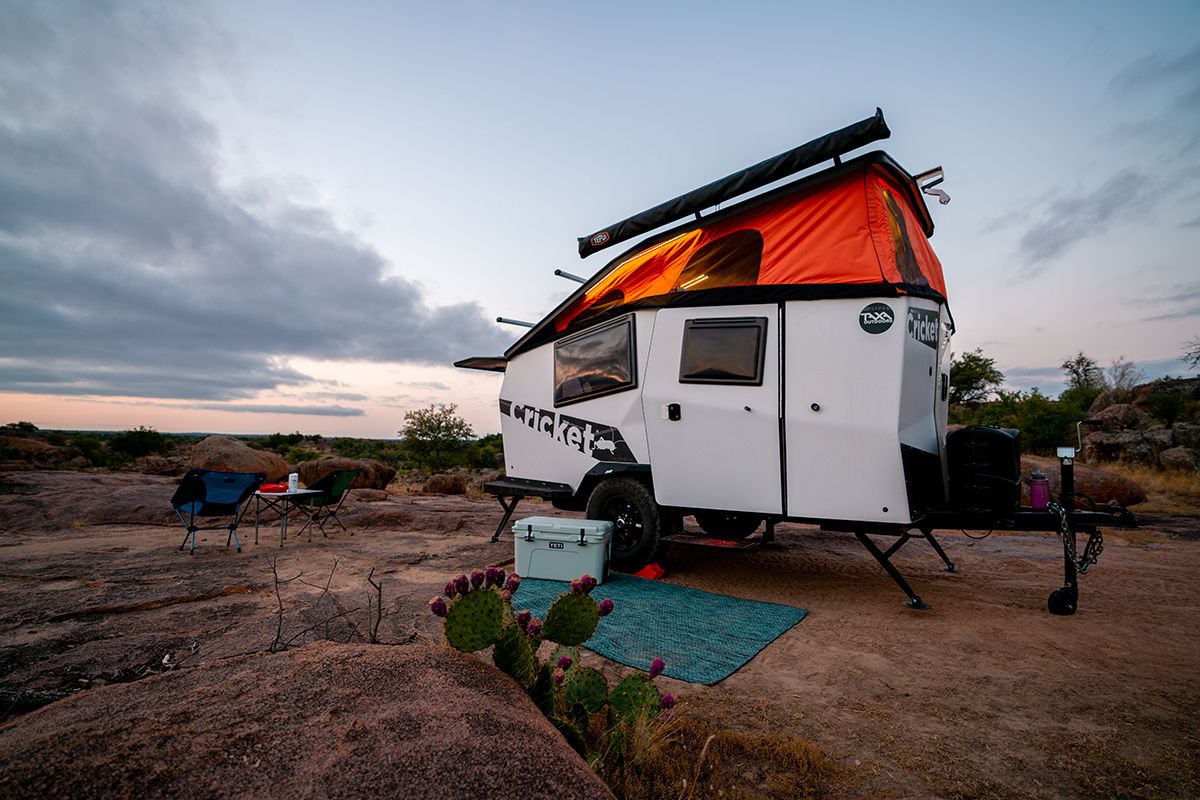
Downsizing, RV-Style
Mention an "RV," and images of massive, gas-guzzling homes on wheels that appeal mainly to those nearing retirement is what might first come to mind. But an industry trend driven by — who else? — millennials is seeing recreational-vehicle profiles getting "smaller, sleeker with more technology built in," Recreational Vehicle Industry Association spokesman Kevin Broom told The Spokesman-Review . Cheapism has rounded up a few of these tiny RVs that are turning heads, at a number of different prices, from more affordable trailers that cost less than $15,000 to luxury motorhomes that ring up at a staggering $500,000.
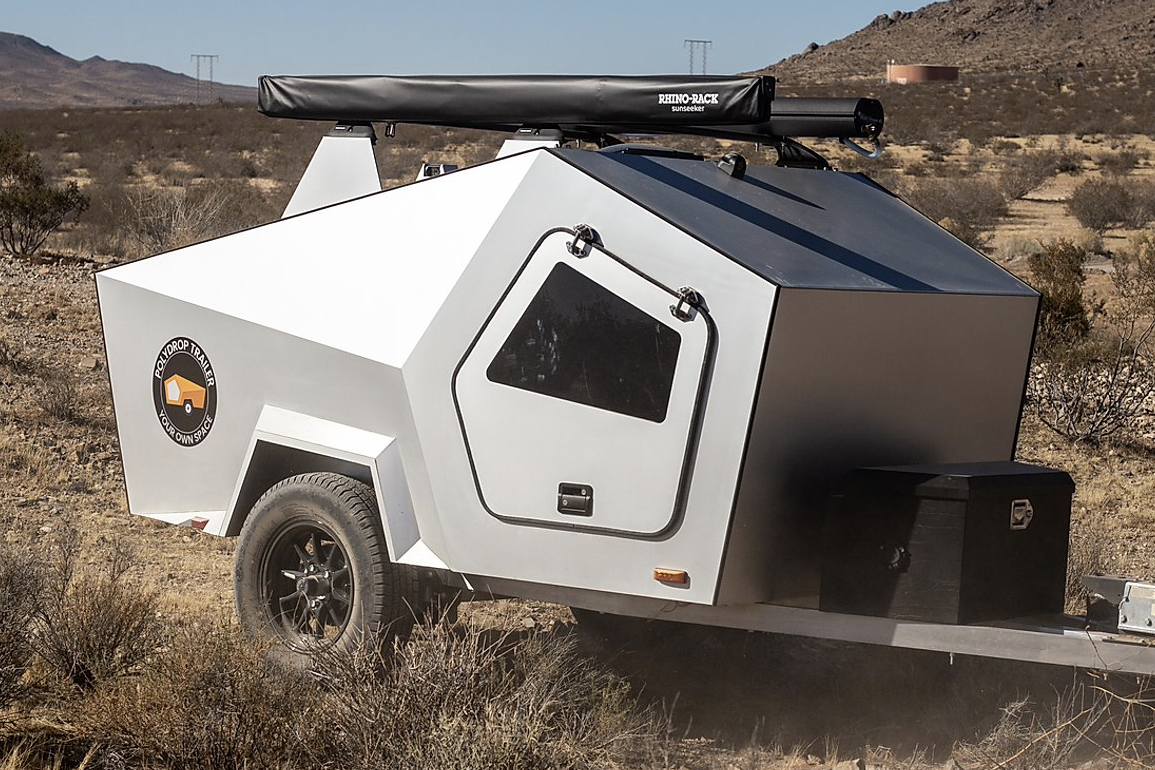
Polydrop Trailer
A more angular take on the ubiquitous teardrop trailer profile, the Polydrop looks like a tiny spaceship, especially with its gull-wing doors raised. At just over 12 feet long, with a double layer of insulated wood and aluminum skin, it's designed to be cozy, even in cold weather.
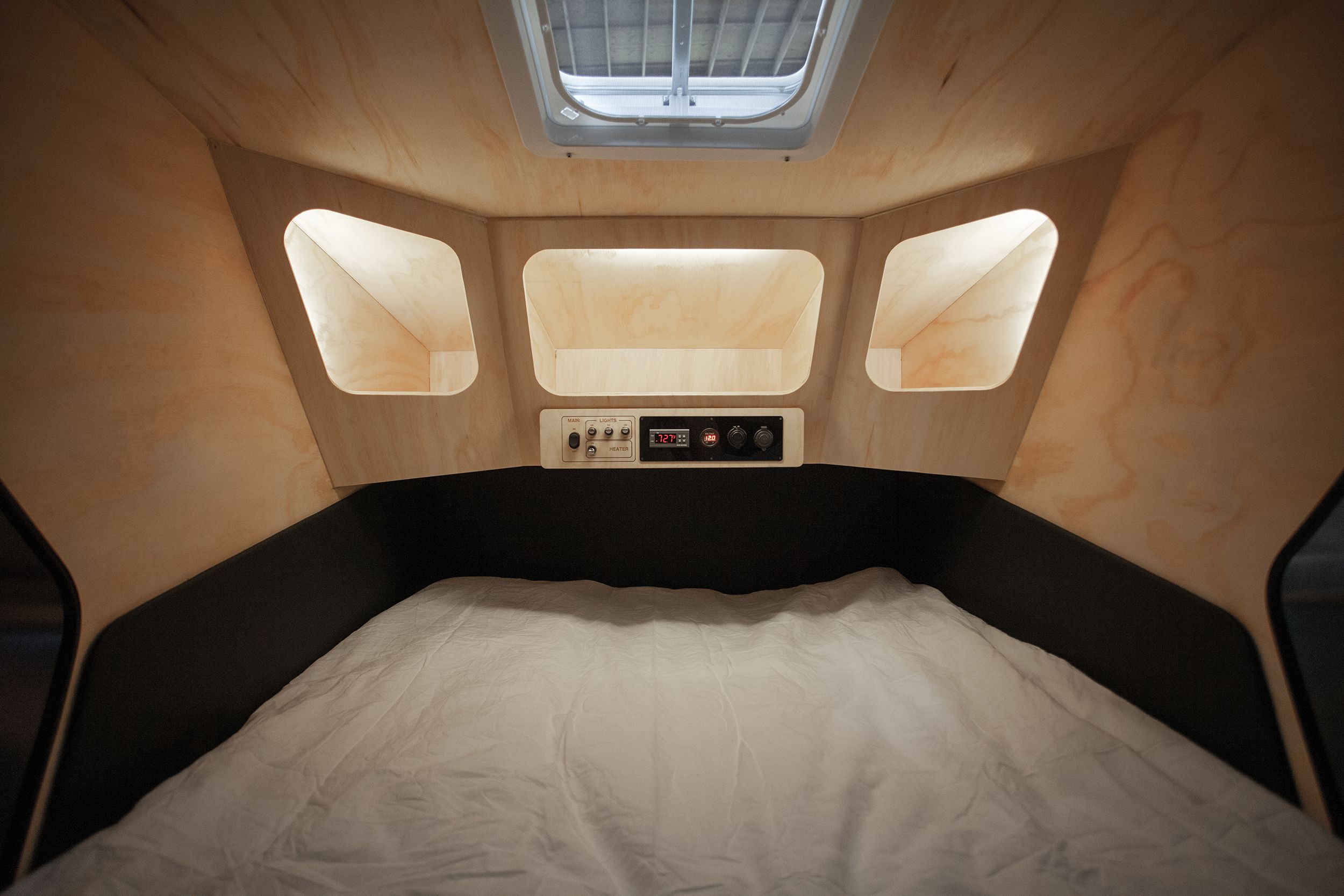
Polydrop Trailer: The View Inside
Like other trailers with similar profiles, the Polydrop includes a cabin with sleeping space and storage, and the camper's back opens up to a minimalist, mod-looking cooking space that includes a cabinet for electronic components and two storage drawers — no cooktop, sink, or refrigeration here. Polydrops start at $12,500.
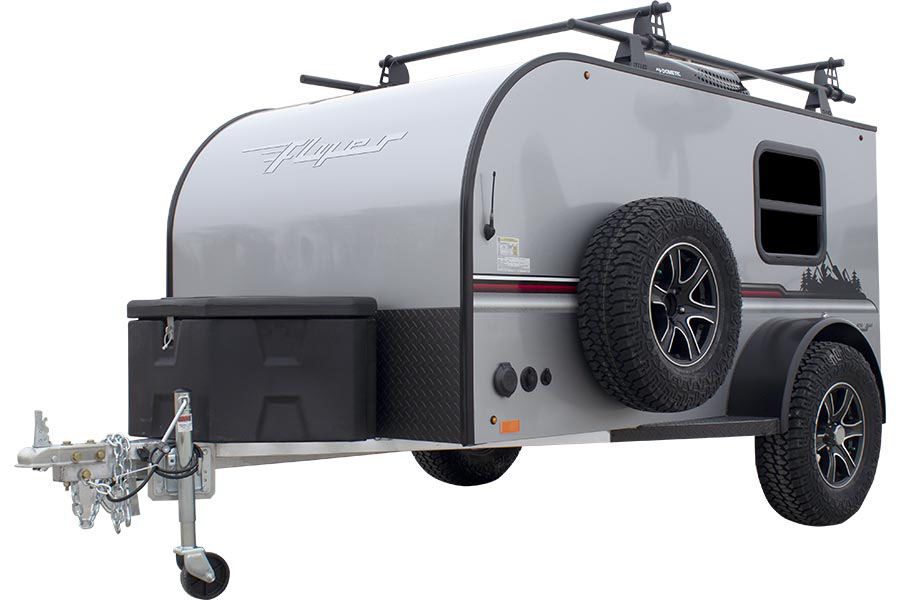
inTech RV Flyer Chase
This Indiana company offers a number of RV models considered tiny by today's standards. The Flyer Chase is one of the more versatile options with plenty of available add-ons and mods. At 7 feet, 5 inches long and 3 feet, 9 inches high, it sleeps two, but can accommodate up to three more people with an add-on tent feature.
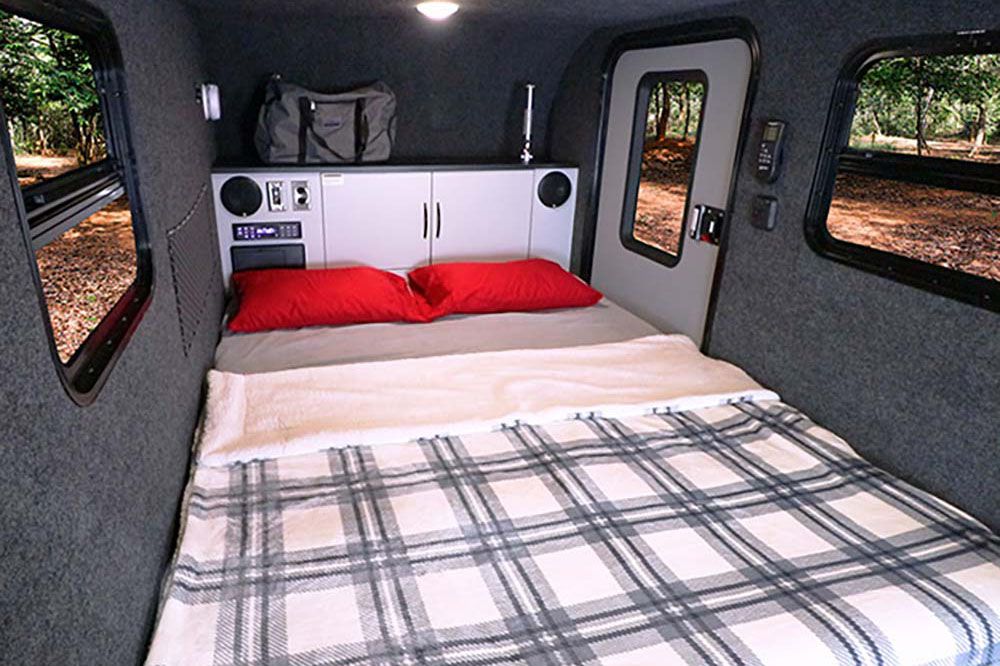
inTech RV Flyer Chase: The View Inside
RVers who really like to get off the beaten path can do so with the Chase's off-road tires, all-aluminum, fully welded cage frame, and lift kit. Larger versions of the Flyer — the Pursue and Explore — come with slide-out kitchens and tip-outs for extra sleeping space. New models of this trailer start at a little above $13,000.
For more great RV articles, lifestyle stories, and money-saving tips, please sign up for Cheapism's free newsletters .
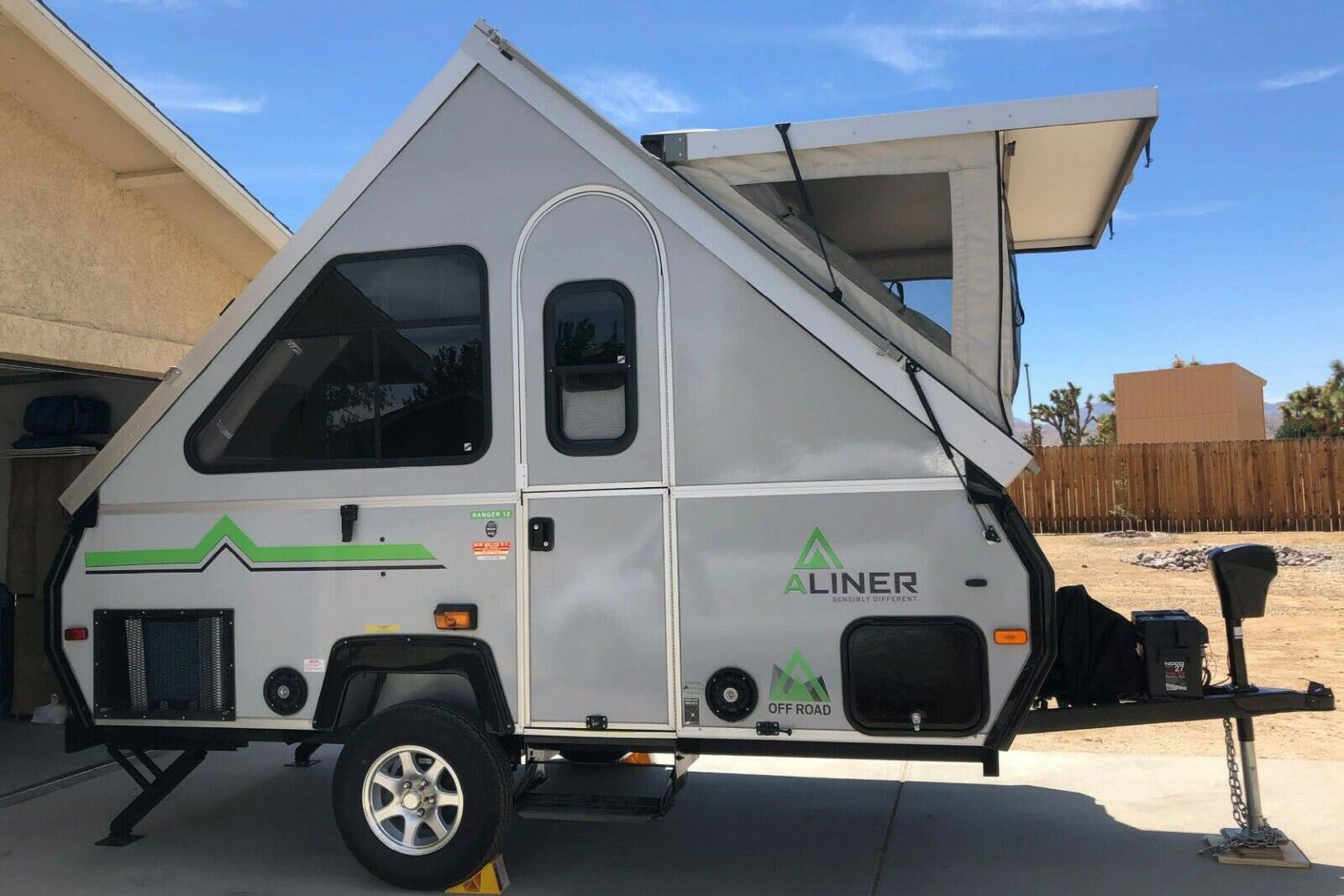
This pop-top, "original A-frame" camper was conceived of in the early 1970s. It now comes in 10 versions with differing features. These include exterior options such as an outdoor shower, baggage doors, LED running lights, exterior outlets, off-road axle, outside grill, and more. Interior options include a shower, toilet, and front and/or rear beds.
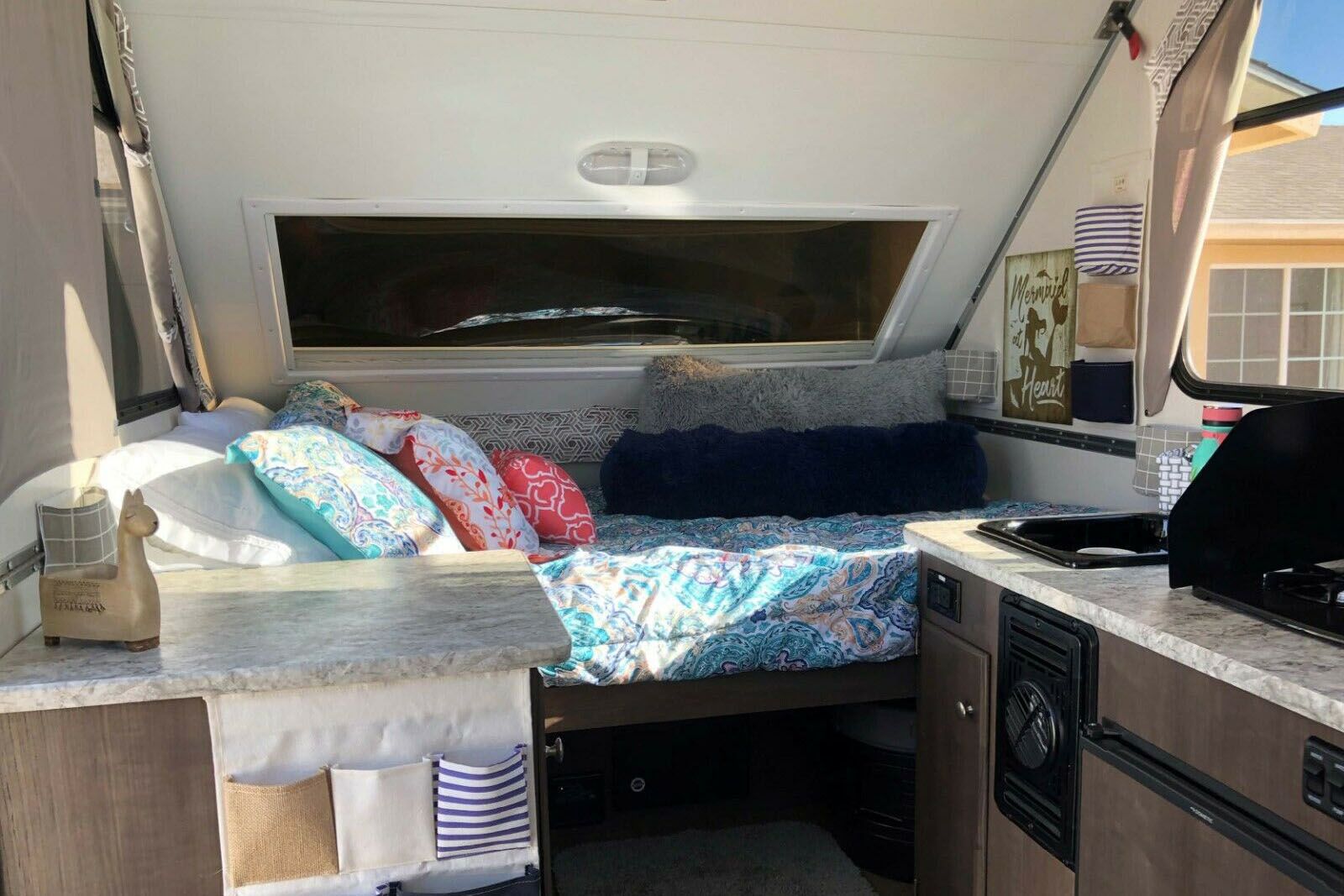
Aliner: The View Inside
Some models include a refrigerator, microwave, and stove-top. The company also makes a small-footprint, teardrop-like RV camper called the Ascape with solar panel and flat-screen TV options. Plan to drop at least $29,000 for the latest Ascape models, depending on size and features.
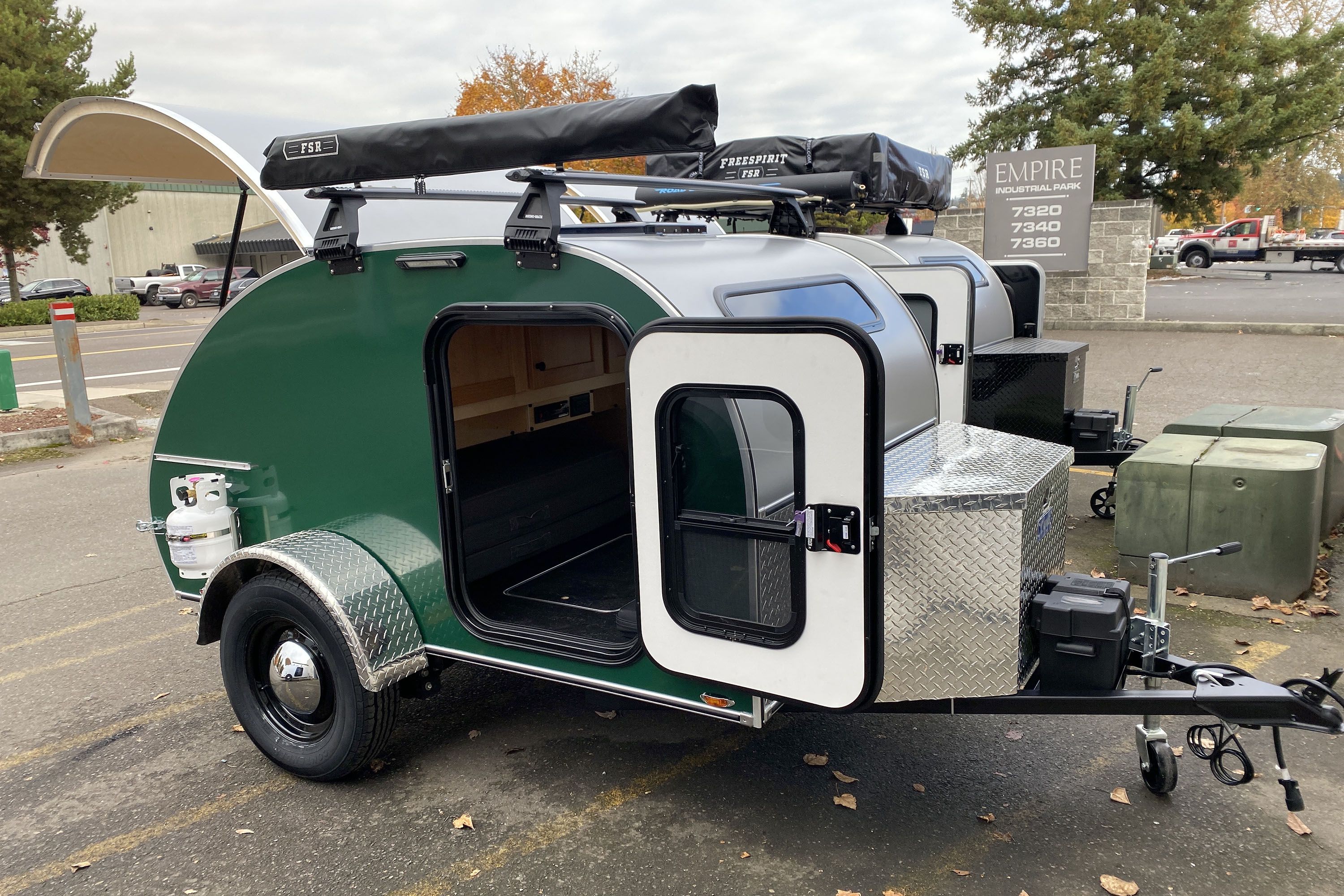
Aero Teardrop Steel
Portland, Oregon-based Aero offers a number of customizable tiny RV models, but the 5-by-10-foot Steel is its most compact they currently offer. Like many teardrop-style trailers, the Steel features a sleeping cabin and galley that can be configured several ways. It also comes with a Bluetooth stereo system, hardwood cabinetry, LED lighting, and underfloor storage.
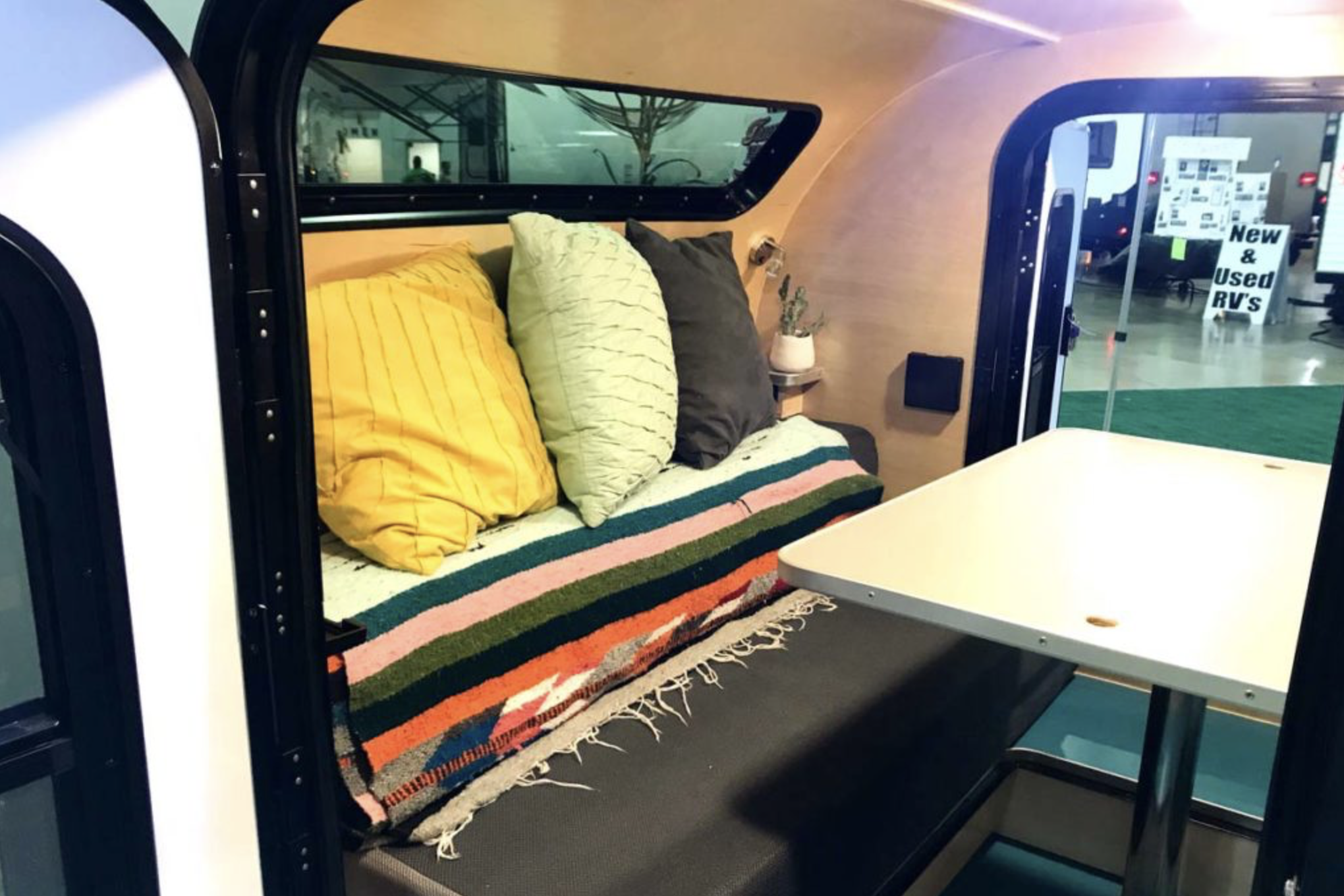
Aero Teardrop Steel: The View Inside
Custom options such as exterior finish, wheel type, tongue storage, and awning, as well as interior add-ons such as TV/DVD player and stainless steel countertops increase the price. Aero has a super-intuitive trailer-building feature on its website that lets customers know exactly how much each feature costs. Models start at $18,850.
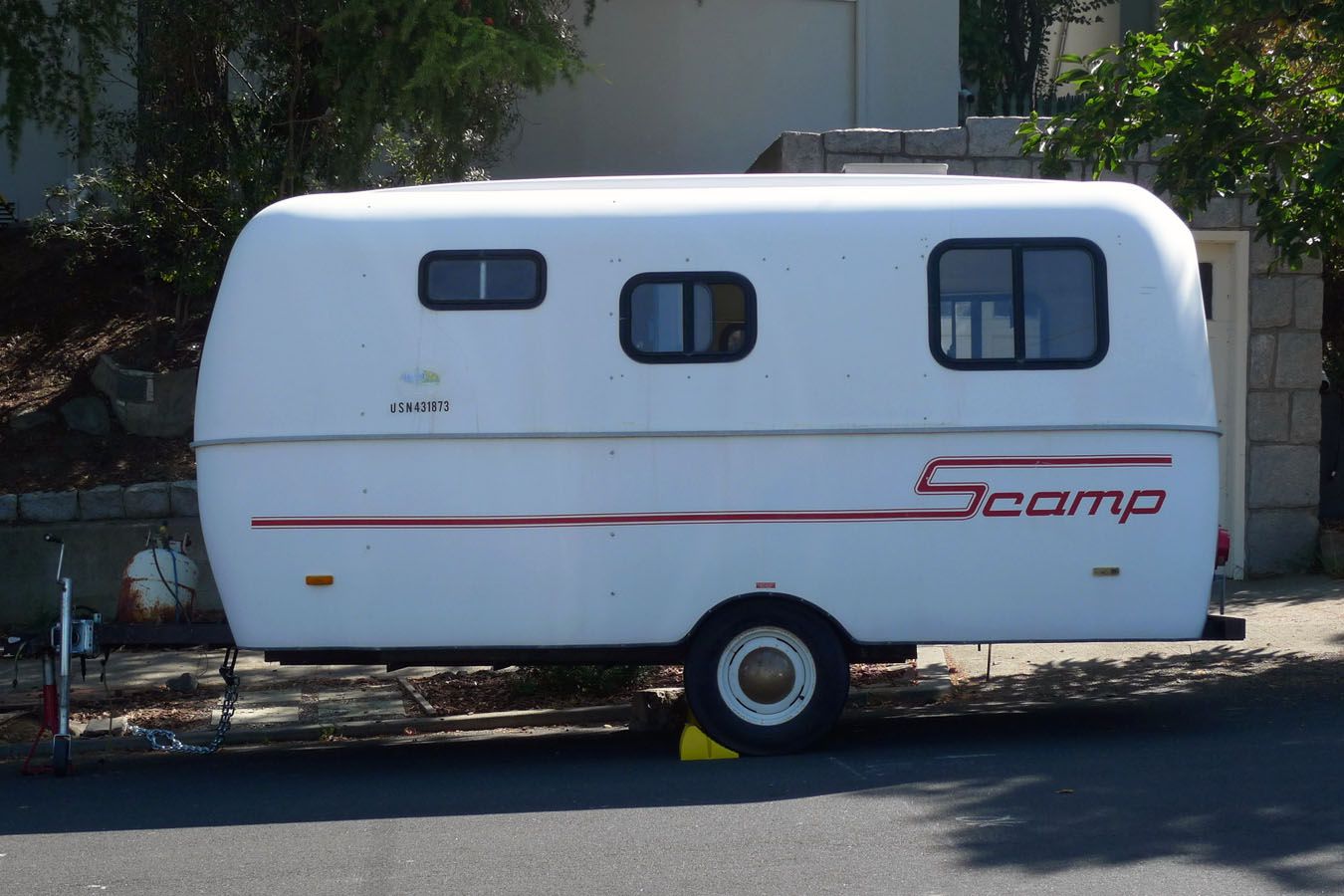
Scamp Trailer
Scamp has been making trailers since the 1970s, and is still going strong . The camper's original aerodynamic profile remains on the modern standard and deluxe models, available in 13- and 16-foot trailer versions, as well as a 19-foot fifth-wheel version. This latter option comes with oak or birch hardwoods, a larger bath area, more storage, and space to accommodate a larger refrigerator.
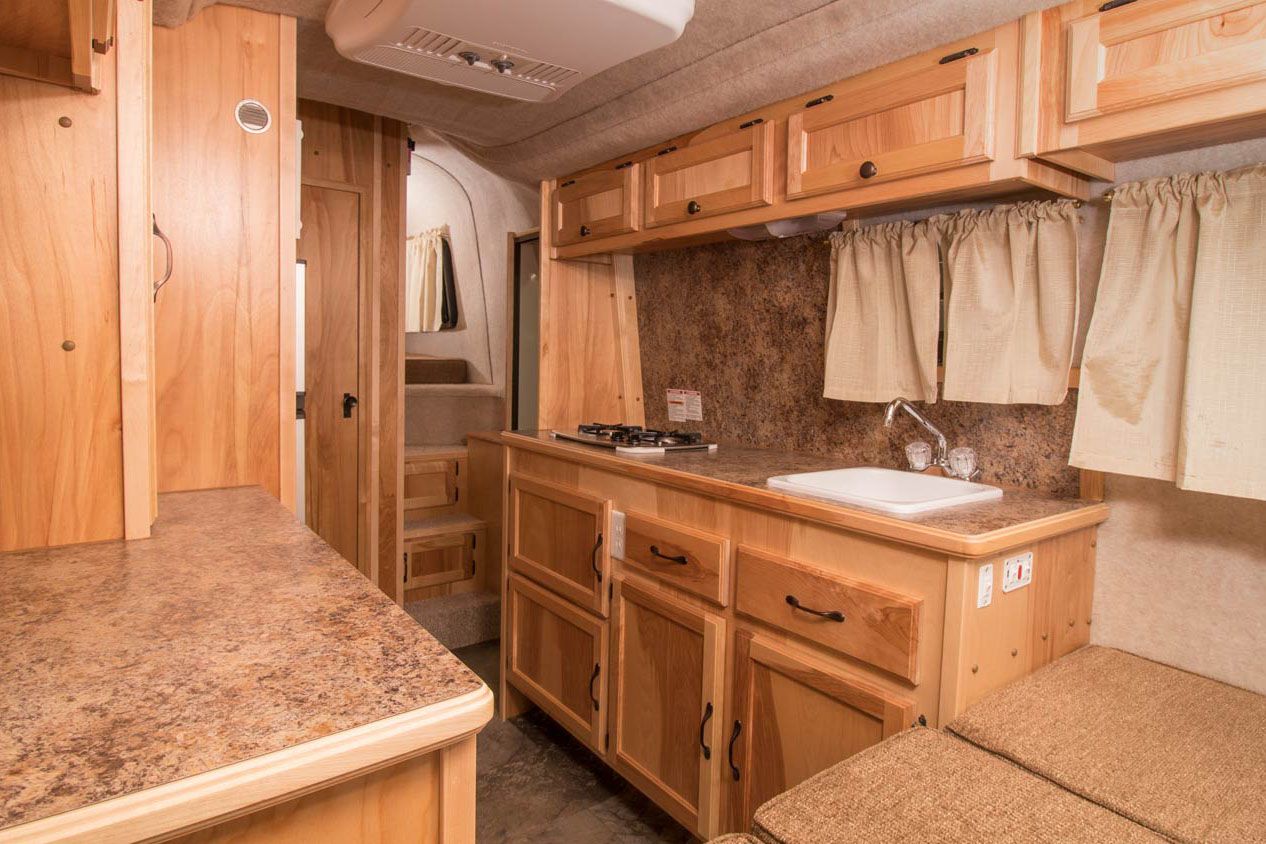
Scamp Trailer: The View Inside
With a convertible dinette and queen-bed loft area, the super-sized Scamp can sleep five to six. Expect to spend around $19,900 for the smallest version and between $24,000 and $36,000 for larger models.
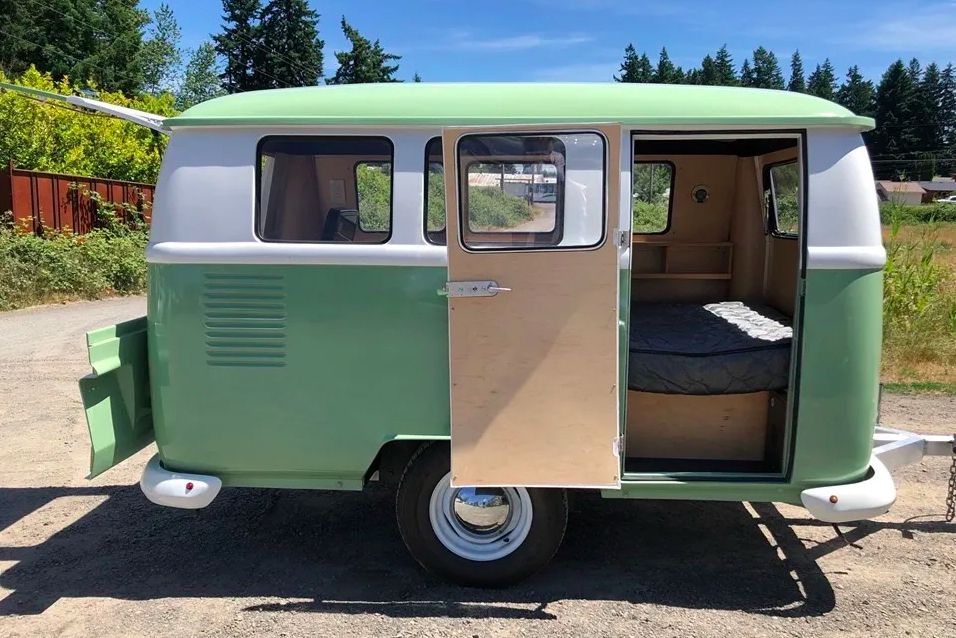
T2RV Dinky Dub Sleeper
If you're a fan of the VW Bus, you'll love the Dinky Sleeper's design, which looks a lot like the classic vehicle, only in towable form. This tiny RV comes with or without an outdoor kitchenette, and both models include a custom queen mattress and options such as privacy window shutters, roof rack, AC/heat, portable cooler, indoor curtain track, and pop-up top with weather curtains.
The Coolest VW Vans Through the Decades
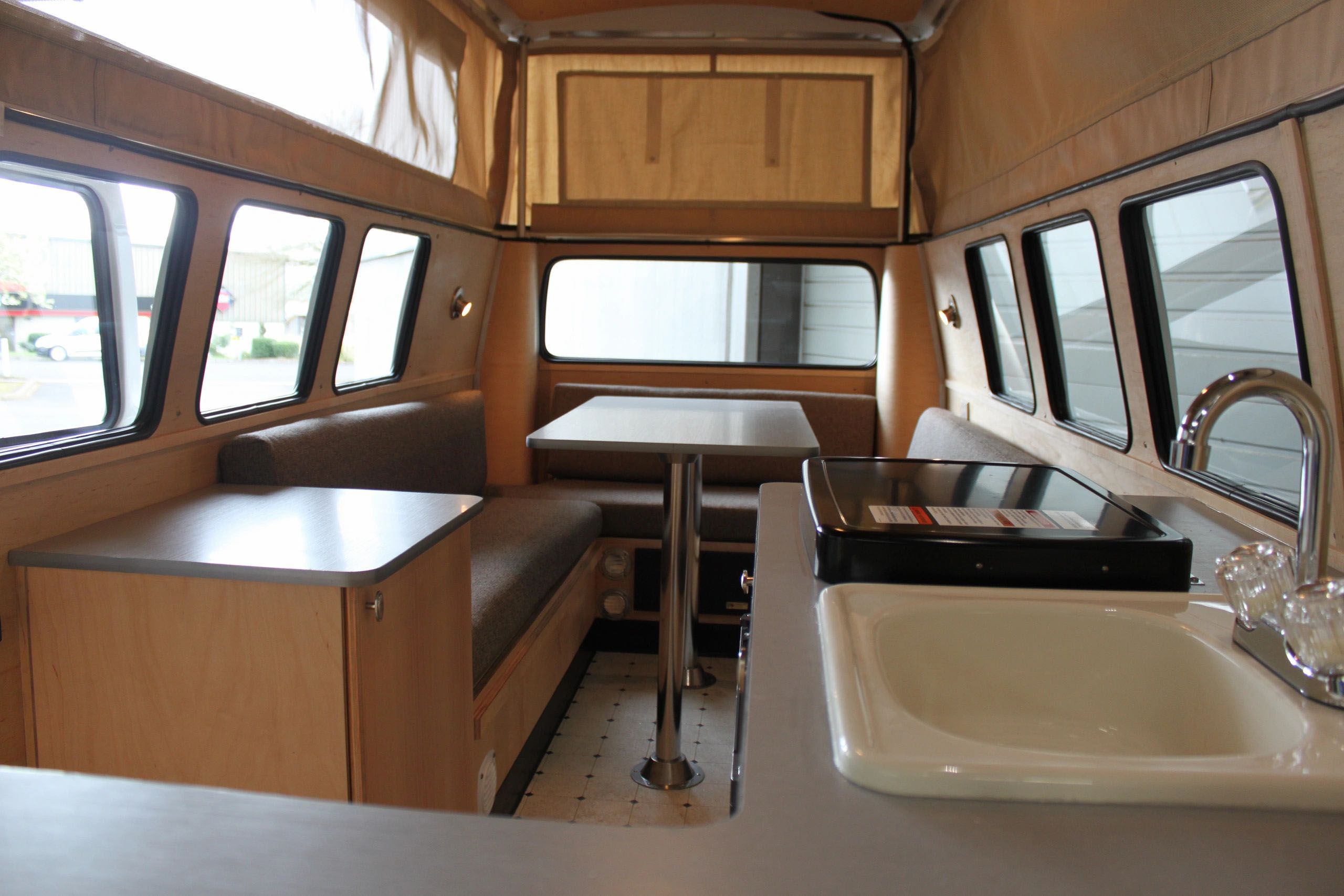
T2RV Dinky Dub Sleeper: The View Inside
Dinkys can be ordered in a choice of colors, and are easily towable at about 1,000 pounds. The kitchenette version starts at $31,000 and one without at $28,400.
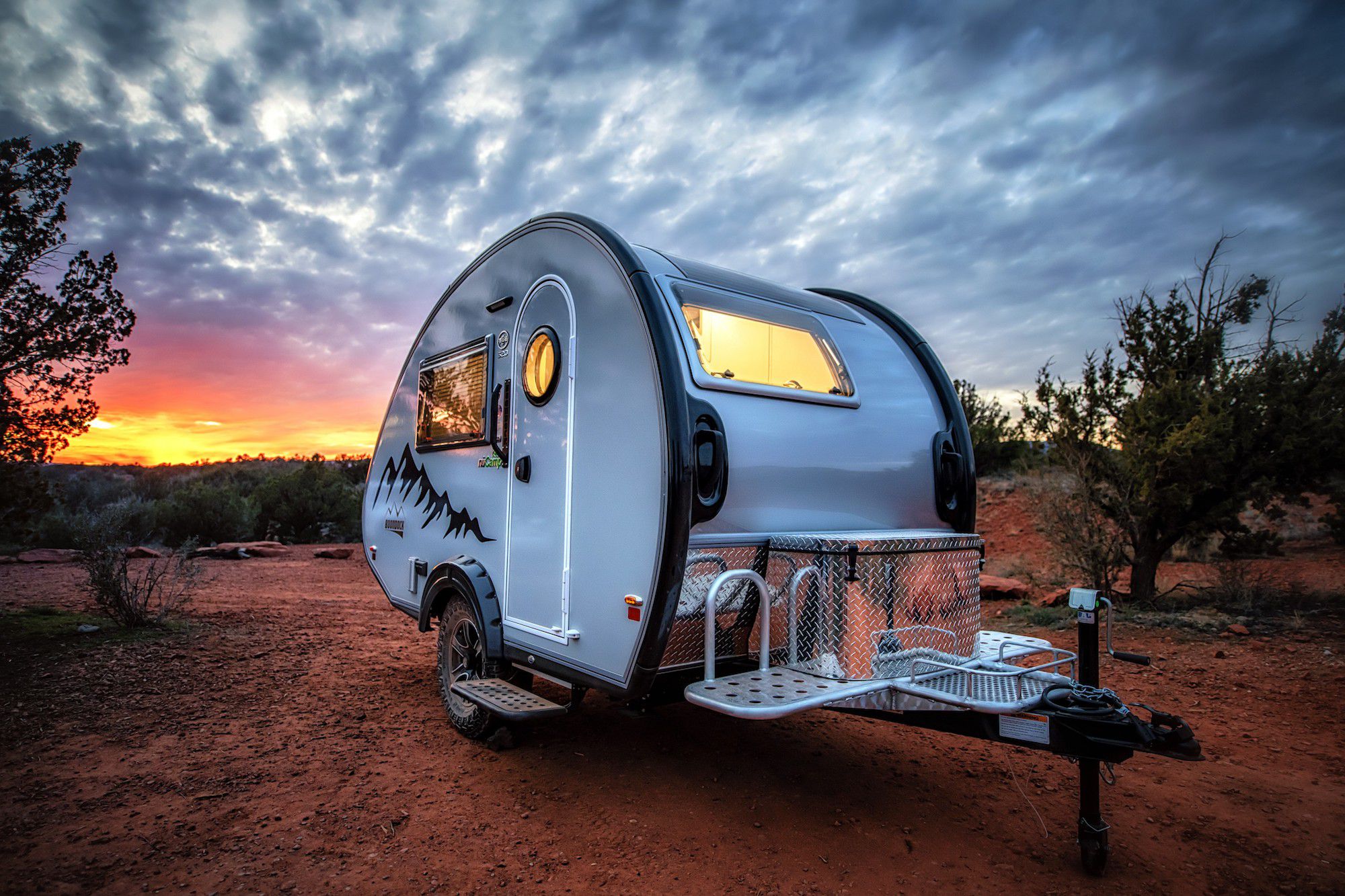
nüCamp TAB Teardrop
For the RV owner who likes a nod to vintage styling combined with Amish craftsmanship, there's this line of tiny towables. Unlike most other teardrops that have a kitchen accessible from outside, nüCamp's TAB models includes it inside, and there are even floor plans that include a wet bath.
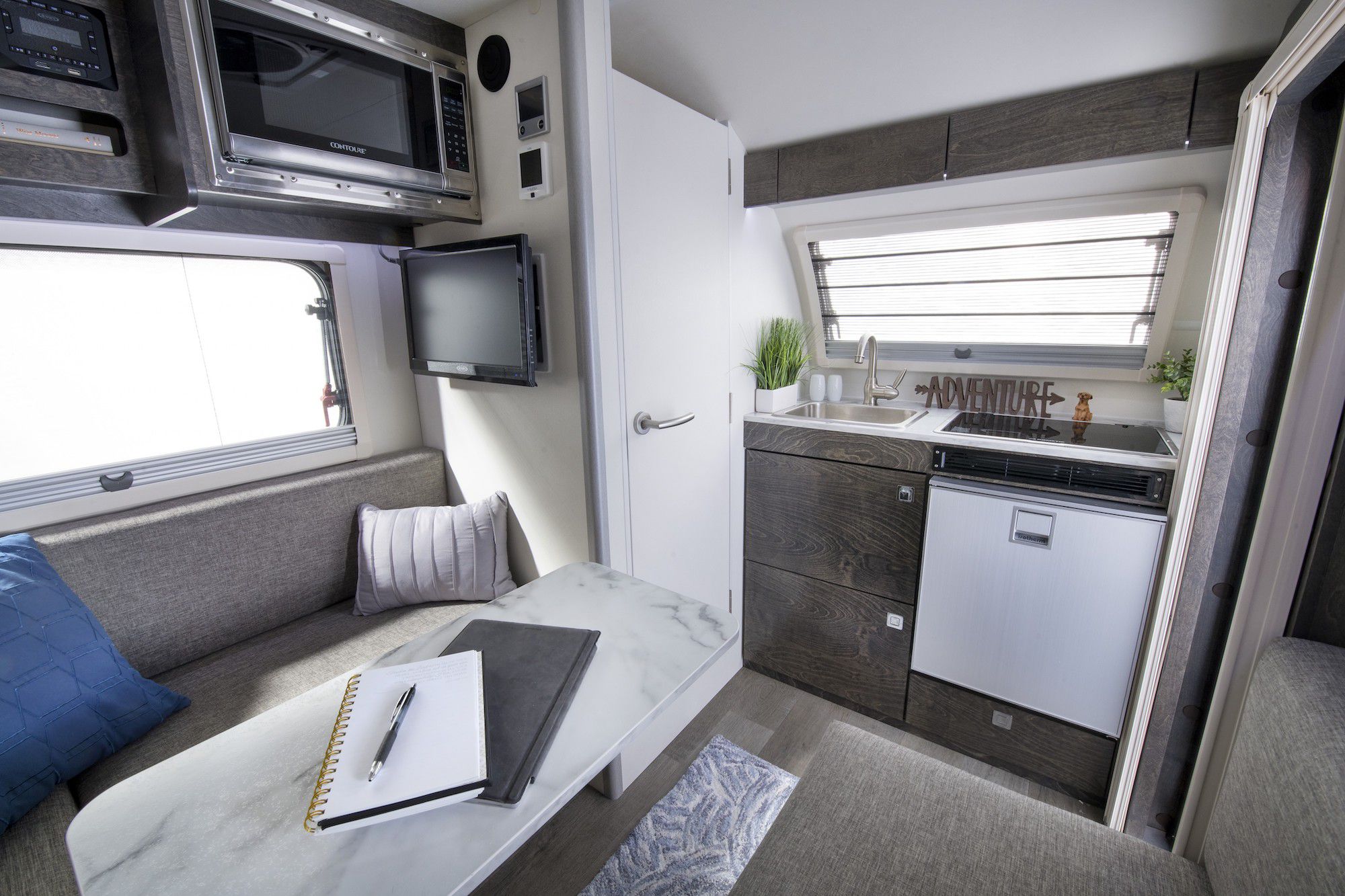
nüCamp TAB Teardrop: The View Inside
The camper's base package includes central AC and heat, a 19-inch TV/DVD/radio combo with Bluetooth technology, and an external shower for hosing down gear, pets, or yourself. Optional features include LED lights, solar panels, a Yakima roof rack, off-road tires, and more. Prices for these trailers start in the low $24K range and can exceed $35,000, depending on model and features.
Taxa Outdoors Cricket
With a dry weight of just over 1,700 pounds and a design inspired by NASA, the easily towable Cricket has a ton of features that make this tiny RV versatile. Once parked, campers can open a pop-up roof for added ventilation and space. It also comes with a built-in, birch plywood kitchen, under-bed storage, and a bed that can be converted into seating.
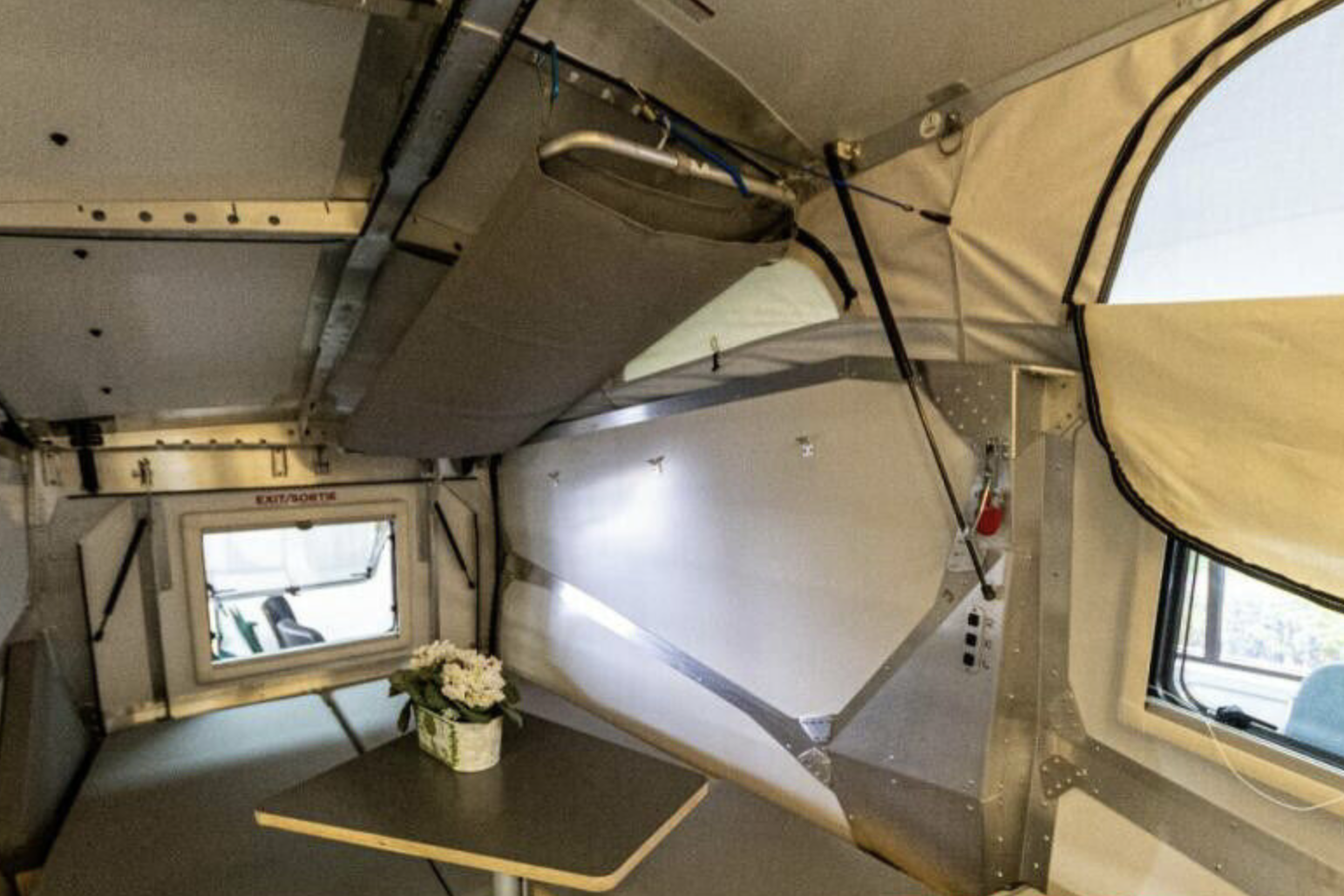
Taxa Outdoors Cricket: The View Inside
Available options include a portable toilet, kids' berths, window AC unit, and more. The Cricket also has thoughtful exterior details — bottle opener, carabiner clips, hot/cold exterior shower — that any adventure-thirsty gearhead will love. The base model goes for around $43,500.
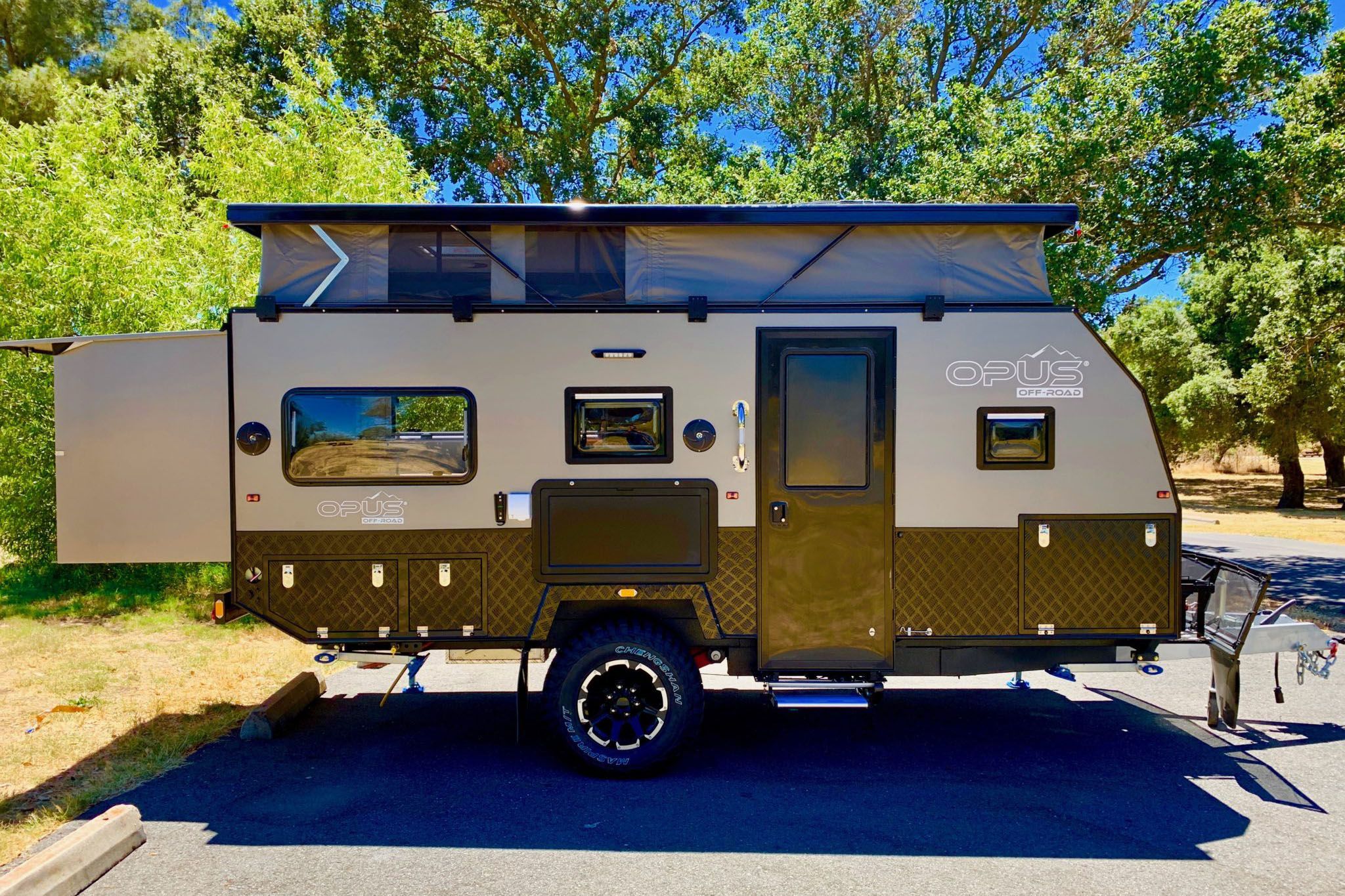
Opus OP 15' Hybrid Caravan
Built with "tough luxury in mind," this tiny RV includes a bamboo interior, a pullout stainless steel kitchen that includes a chopping board, prep deck and pantry access, as well as an electric Dometic cooler that has both refrigeration and freezing compartments, and a pop-up roof that provides extra headroom.
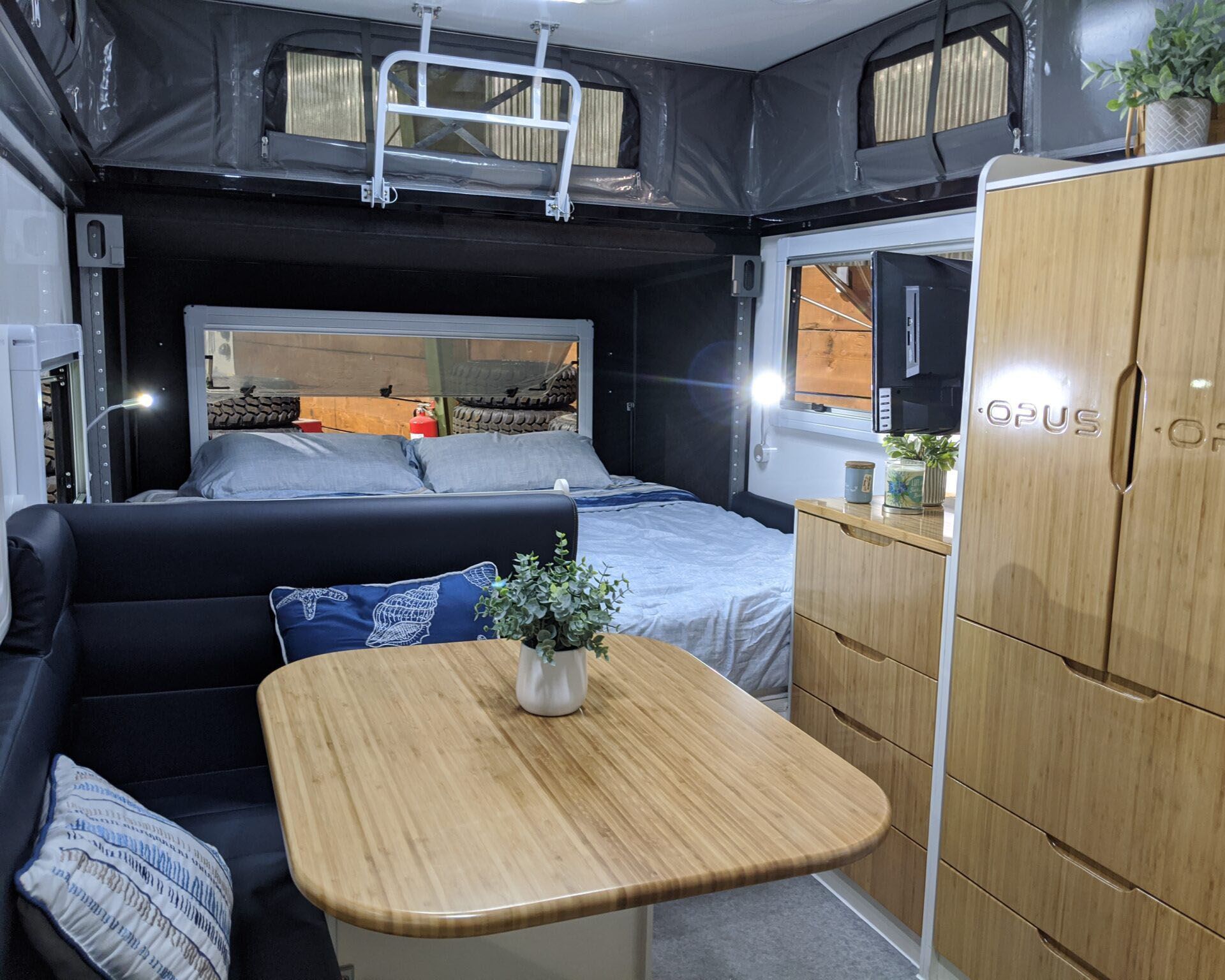
Opus OP 15' Hybrid Caravan: The View Inside
The OP's interior includes a leatherette dining area, shower/toilet combo with hot water availability, a king size bed and twin bunks, and plenty of available storage via a wardrobe and other storage areas. At nearly 5,000 pounds, it'll require a more robust vehicle to tow it but, as GearJunkie once noted , with this many features, it "may be nicer than your home." Models start at $54,000.
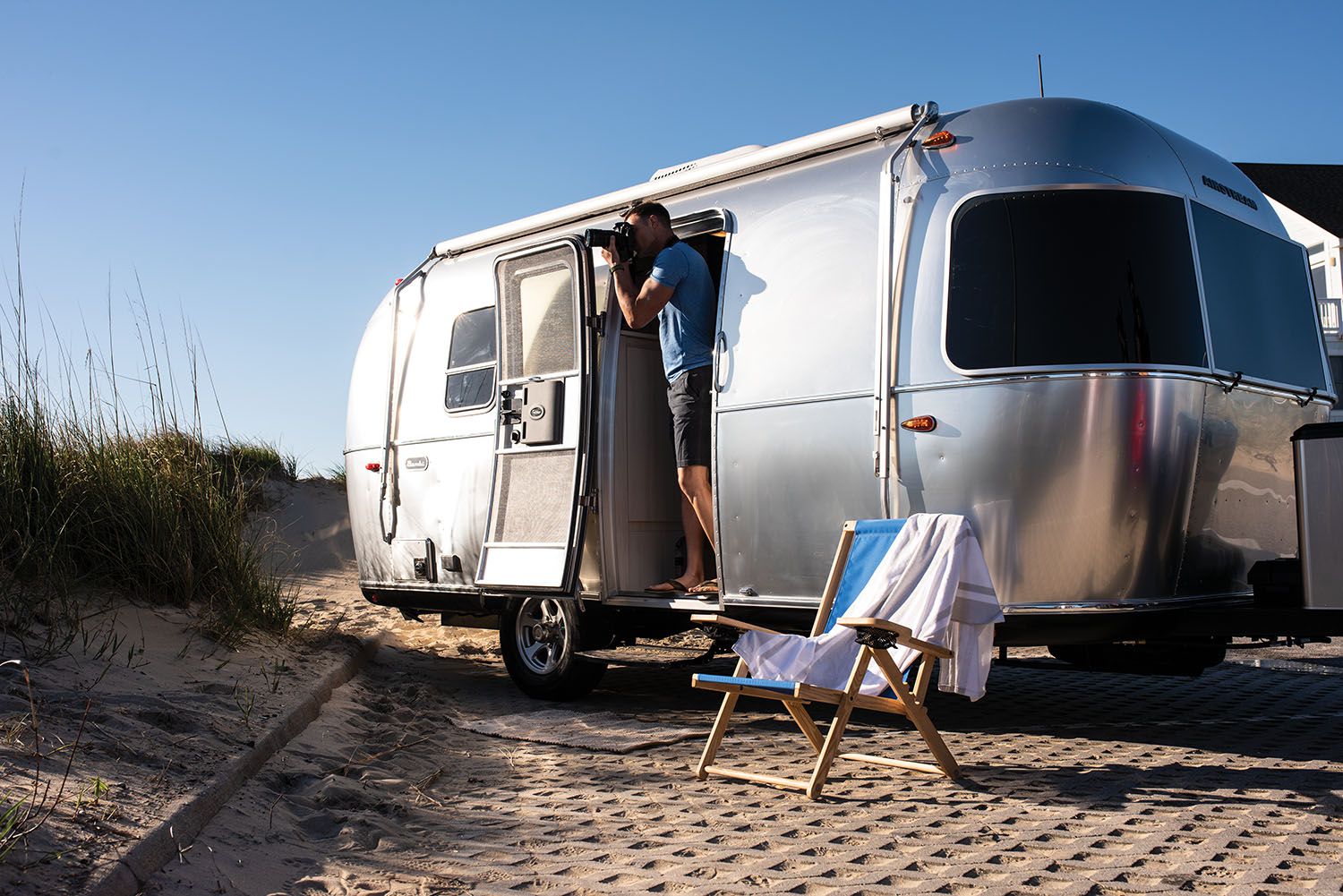
Airstream Basecamp, Caravelle, and Bambi
The classic silver bullet company offers these three models that range in starting price from $59,300 to $74,000. All three are 16-footers, although the Bambi can sleep four at that size, and also comes in 19-, 20- and 22-foot versions.
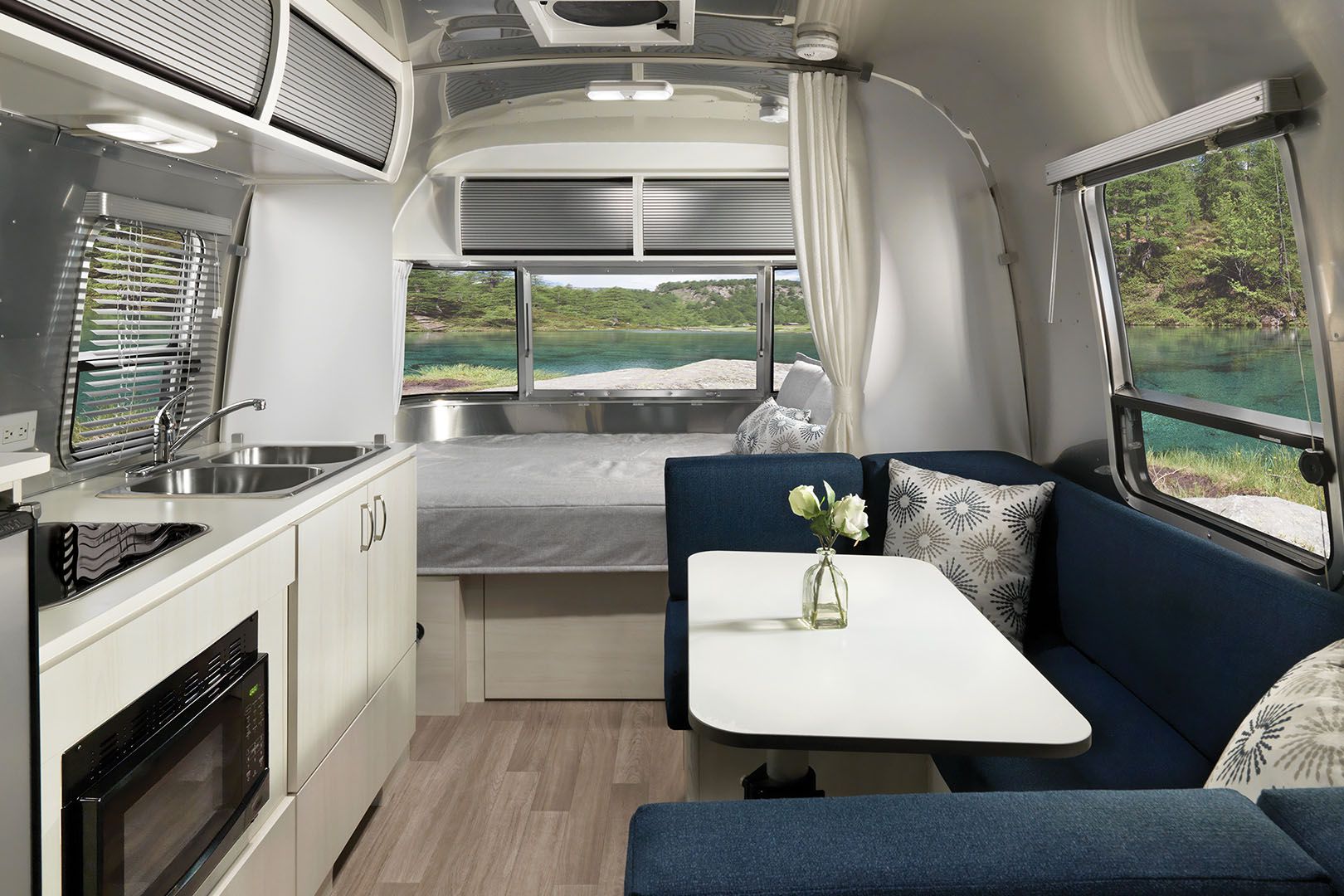
Airstream Basecamp, Caravel, and Bambi: The View Inside
All three come with a functioning kitchen and waterproof interior bathroom (as well as exterior shower with hot and cold water). The Bambi and Basecamp have a base weight of 3,500 pounds making them easy to tow — although the Bambi might require a regular rather than midsize SUV. The base weight of the Caravel is 4,300.
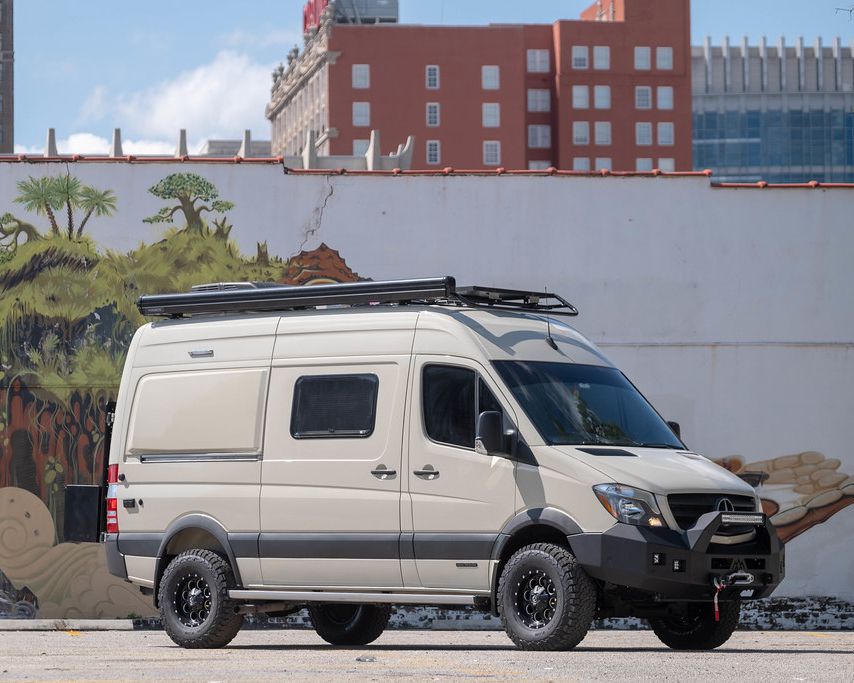
Winnebago Revel
The Class B — commonly called van campers — is another category that lends itself well to smaller footprint RVs, and Winnebago's Revel is a popular, award-winning choice in this genre. It's the first off-road ready camper to be mass-produced and sold in the U.S. in decades, and Outside magazine called it a "breakthrough camper van." It includes a power-lift bed with under-bed storage, an all-in-one gear closet and wet bath, and swivel cab seats, as well as a kitchen with single-burner induction cooktop, stowable countertop extension, and 2.5 cubic foot fridge.
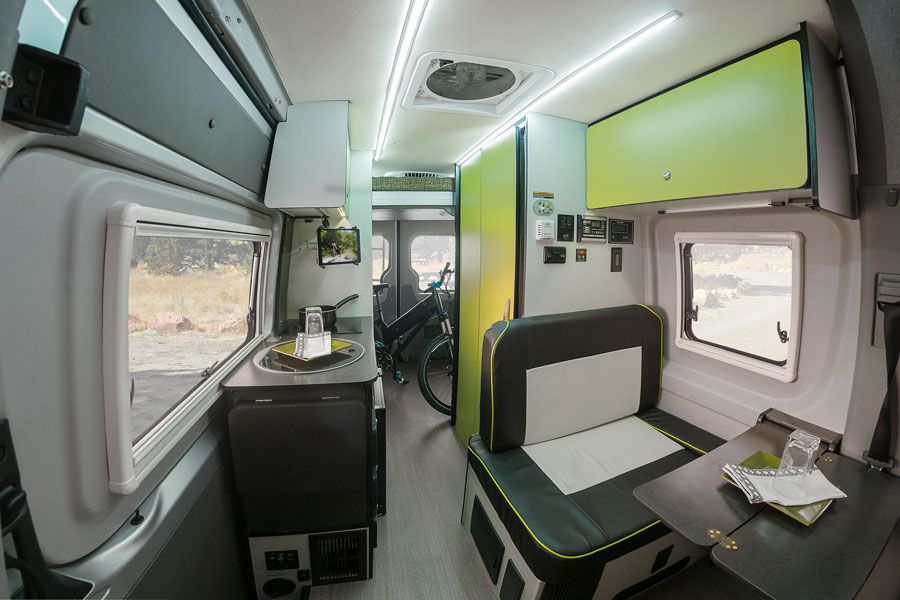
Winnebago Revel: The View Inside
Other desirable features include AC/heat, dual-pane acrylic awning windows with shades for ventilation, and snap-in screens on sliding and rear doors to "let the breeze in while keeping the bugs out." All that versatility comes with a bit of sticker shock, however — new models start at $210,292.

Winnebago Boldt
Following the success of the Revel is Winnebago's newest camper van, the Boldt . Built on a 24-foot Mercedes-Benz chassis with a V6 diesel engine that's also available in a 4x4 option, this modern motorhome includes safety features such as airbags, blind-spot monitors, and assist systems for auto-high beam, active lane keeping, and active braking. The two floorplans combine sleeping areas, galley kitchens, and dining areas.
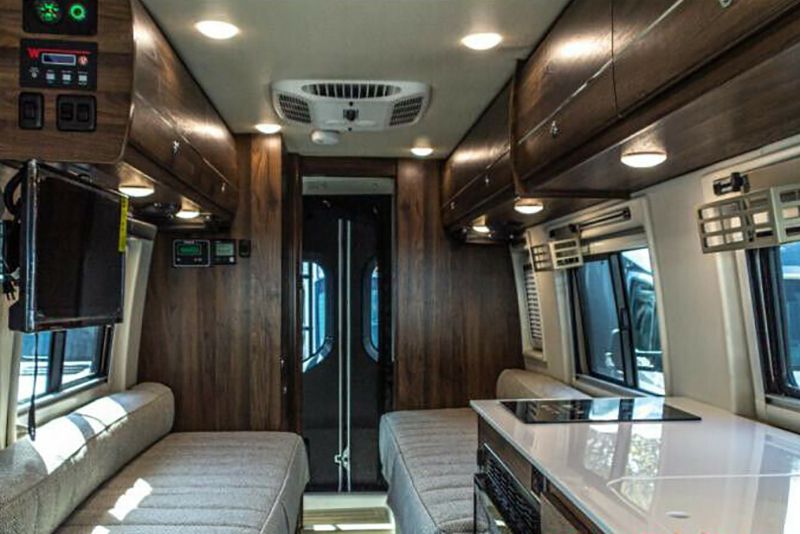
Winnebago Boldt: The View Inside
Winnebago claims it's the "most comfortable B-van ever created" and, with a starting price of $245,587, it should be. For that amount of money, travelers also get Corian countertops, an AI voice interface system, integrated Wi-Fi, a 24-inch LED TV and sound system, and enough extra insulation to make it four-season road-worthy.
Discover more fun RV and camping stories right here .
This article was originally published on Cheapism
More From Cheapism
- 13 Cheap Pets That Are Easy to Take Care Of
- 40 Meals Under 100 Calories Per Serving
- Costco Business Center: Locations, FAQs, and Why You Should Shop Here
- Is Spirit Airlines Safe, and Why Is It So Cheap?
- These Are the 7 Cheapest Fast-Food Joints To Try Right Now
Like Cheapism's content? Be sure to follow us .
More for You
Flight attendant shares her punishment for passengers who refuse to swap seats with parents

Beijing half marathon probes 'embarrassing' win by Chinese runner
Ryan Gosling, 'SNL' Cast Barely Keep It Together In 'Beavis And Butt-Head' Sketch
Therapists Say These 6 Common Habits Are Fueling Your Anxiety
4 Things You Should Never Cook in Cast Iron
New doc uncovers racism and inappropriate behavior at popular retailer
Woman with rare syndrome left allergic to ‘everything’ except just four foods
Popular media company files for bankruptcy, plans to liquidate
7 CDs You Probably Owned, Threw Out and Now Are Worth Bank
Tax Day deals 2024: Score discounts, freebies at Krispy Kreme, Hooters, Potbelly, more
16 Compliments You Didn’t Realize Are Actually Pretty Insulting
Country announces major plans to ban of gas-powered vehicles in sweeping new law: 'The evidence ... is clear'
Common over-the-counter medicine linked to increased dementia risk
Tiger Woods Finishes Last At 2024 Masters Following Highest Total Score Of Pro Career
5 Most Intelligent Dog Breeds You Can Own
I became a millionaire at age 27—here are 4 'unpopular' rules rich people follow that most don't
Certain old $2 bills are worth thousands of dollars
New 'Beetlejuice Beetlejuice' Footage Introduces Jenna Ortega's New Character
This type of supplement may increase heart disease risk, new study finds
13 Polite Habits Flight Attendants Actually Dislike—and What to Do Instead
Lighter in weight and secured with a hitch to the frame of your tow vehicle.
Full-sized campers, requiring the “5th wheel” U-shaped hitch to tow.
Can be a travel trailer or fifth wheel. Designed with a rear garage and opening for your “toys.”
- Heartland Difference & Innovations
- Factory Tours
- RV Lifestyle
The promise of adventure drives every RV journey. Nobody knows this better than us.
- Owner's Manual
- MyHeartlandRV App
- Owners Club & Forum
- FAQ's and RV Glossary
- How to Videos
- Towing Guide
- Apparel Store
Heartland Owners Club & Forum
The Heartland Owners Club is made up of RVers from all walks of life, all on different paths on their RV journey. The club holds regular rallies and events across North America and allows you to tap into a vast amount of information curated by experienced RVers.
- FIND A DEALER
Corterra Travel Trailer
Drawing from the Latin 'cor' meaning heart, and 'terra' signifying earth, Corterra Travel Trailer encapsulates the essence of both humanity and the natural world. It serves as your sanctuary on wheels, enveloping your loved ones in comfort and warmth. With Corterra, every spot of earth becomes a destination, inviting you to pursue the callings of your heart to any corner of nature.
Starting At
- Length 26' 11"
- Weight 5,246 lbs
“We looked for a few months, at multiples brands, just trying to balance our price range and functionality. Heartland matched our needs with both the price point and the separate bunk room we were looking for for our family. ”
CALEB & JOY ANDRIST
New Travel Trailer Models for 2024
Come explore the open air.
Introducing the pinnacle of modern luxury in recreational living: Our brand travel trailer boasting a spacious and open-concept interior, featuring top-of-the-line materials and sleek, contemporary design elements.
LISTEN TO LAUNCHING LIFE'S JOURNEYS
Most popular corterra travel trailer floor plans, help me find my rv.
Floor Plans are adapted by region. Learn which region your state falls in. Find My Region
Corterra Travel Trailer Floor Plans
Take a virtual tour..
Please select a floor plan to tour.
Explore the Corterra Travel Trailer Gallery
Connect with a product specialist.
Thinking about buying a new RV and have questions? We are here to help!
Whether you have general questions about RVing or specific questions about our products, we have the answers, or we'll do our best to find them for you.
How may we help you?
By submitting this form you are authorizing staff from Heartland RVs to contact you by e-mail and/or phone and to receive future communications from Heartland RVs.
Please make sure all fields are filled out and that you have clicked the authorization checkbox above.
Select Your Region
Mallard, North Trail and Sundance travel trailers are produced in multiple Heartland RV manufacturing facilities in Elkhart, Indiana and Nampa, Idaho. These brands can offer a slightly different model depending on where you live. Select your state’s region to see products sold in your area. Select “All Regions” to view the entire Heartland collection.

IMAGES
VIDEO
COMMENTS
A motorhome is a trailer and a car all built into one thing. The motorhome comes in a giant bus size which is class A, a class B is which is a van, class C is the smallest of the bunch being no more than a truck. A travel trailer is an RV that hitches to the bed of your truck and follows behind you.
The price range for a new Class A motorhome is between $90,000 to $250,000 or more with the average price being $150,000. Travel trailers start at $10,000 with the average price being $35,000. But this is a very broad question because you get your average mid-range motorhome, and you get your average mid-range travel trailer.
A class a motorhome costs more. Servicing requires a particular mechanic. Pros and Cons of Travel Trailers. Pros. It's easier to travel outside of your site. Travel trailers offer safer transportation. Travel trailers are less expensive. Travel trailers require less maintenance. Cons.
Class C: the in-between RV size. A parked RV across from Google headquarters on May 22, 2019 in Mountain View, California. Justin Sullivan/Getty Images. As counterintuitive as it is, the Class C ...
Class B Motorhome vs. Trailer. Class B motorhomes, also known as sleeper vans, offer a more similar camping experience to your traditional travel trailer. Although you won't have to unhook anything to get set up at camp, you'll probably be dealing with convertible furniture or wet/dry bathroom facilities, much as you might in small RV ...
This is especially true when you compare the price of a Class A RV with a travel trailer of equal length. For example, you can find a 30 ft long travel trailer for $30k or less. A 30 ft long Class A motorhome is likely to cost you over $100k, if not closer to $300k depending on amenities and many other factors. Unless you are planning on living ...
With a motorhome, you need to remember it is a motorized vehicle. This means it requires the same type of service and maintenance as your daily driver. In addition, you will have the maintenance that comes with an RV. With a travel trailer, you don't have to worry about servicing an engine or other maintenance that comes with a vehicle.
Prices for Class A RVs can be a little high. They range anywhere from $100,000 to more than $200,000. But there is some good news here! Camping World offers RV services for maintenance and collision repair, so you can rest assured your camper receives the best care possible.
Not understanding the different types of RVs can make shopping for a rig much more difficult. For this reason, we think it's important to learn about the various RV classes before jumping into any RV purchase or rental. These include: Class A motorhomes. Class C motorhomes. Class B motorhomes. Travel trailers.
Bumper-Pull Travel Trailers: What Are They? If a fifth wheel is like a Class A motorhome, then a bumper-pull travel trailer is analogous to both campervans and Class C motorhomes. Bumper-pull trailers are both lighter and cheaper than fifth wheels but also can range in size from very cozy to moderately roomy.
Both the travel trailer and class c rv incur almost similar overnight parking costs which could be around $10-$50 per night. Indoor or outdoor storage costs are also similar for both. An indoor storage costs around $50-$500 where as outdoor storage cost of renting could be anything between $40-$100 on an average. 16.
Motorhomes and travel trailers also have a steep price difference. A large travel trailer may cost around $30,000, while a smaller motorhome starts at $50,000. If you make a few camping trips per year, it may make more sense to go with the travel trailer. Motorhomes will also depreciate faster than travel trailers, according to NADAGuides.
In comparison, you can go from extremely large and long travel trailers, all the way down to the small sizes that you can tow with a minivan. These price ranges go from $5,000 to $10,000 for tiny travel trailers, and all the way up to $30,000 or $65,000 massive 40-foot trailers with double slides. Go for a Conversion Van or Class B RV for ...
Class C RVs: A Mid-Size Option. Class C RVs were one of the first camper types to be widely available for rentals. Photo: Shutterstock. Size: 20 to 30 feet. Weight: 10,000 to 13,000 pounds ...
While many Class C motorhomes are still quite luxurious, they might not have the same level of high-end finishes and amenities as a Class A. If you're looking for the ultimate in RV luxury, Class A is typically where you'll find it. Limited slideouts. Compared to Class A motorhomes, Class C RVs generally have fewer slideouts.
Motorized RV Classes Explained. As noted above, the difference between a Class A, B, and C motorhome generally comes down to the type of chassis that they ride on. For instance, a Class A model is usually built on a bus or large commercial truck frame. Popular options include the Prevost, Freightliner, and Ford F-53 platforms.
Landing somewhere between the high-end luxury of a Class A RV and the adventurous spirit of a small Class B van, a Class C RV ranges between 21 and 41 feet long and offers a little bit of both RV styles. These RVs are easier to maneuver than a Class A but offer a few more amenities and space than a Class B.
However, in general, Class A Motorhomes are one of the most expensive categories in the entire RV space. They are the largest of the Motorhome style RVs, and they include much more space and technology than a travel trailer or a fifth wheel. On average a Class A Motorhome will cost around $100,000 to $200,000+.
The top reason many RVers give up on the lifestyle is towing. Towing consists of using your car to pull a trailer behind you. 5th wheel RVs, travel trailers and campers are some examples of recreational vehicles you can tow.With the growing popularity of teardrop trailers, everyone thinks they can pull whether they know how to or not.It takes some time to learn how to tow and for some drivers ...
Exterior Height: 12′ 5″. Many RVers stand by the Jayco RV brand name, and the Jayco Alante is no exception. This particular Class A is the smallest on our list, and it therefore has the smallest price tag. Starting at just over $170k, this Class A RV is a perfect match for smaller budgets.
And, like the motorhome, the breakdown is the reverse. In our opinion, setting up and breaking down a travel trailer takes much longer than a Class C RV. We could set up our Class C and have a drink in hand literally in 15 minutes. We have seen many travel trailers take well over 30 minutes to get unhitched and all set up.
Which RV Type is Good For You. Choosing the right RV can make or break your journey, but it can be overwhelming. There are two main categories to choose from, motorhomes and travel trailers ...
This motorhome is a virtual "home away from home" on wheels that is fully loaded and equipped for short trips, lengthy vacations or even full-timing. The Class A is entirely constructed on a bare, specially designed motor vehicle chassis. Top Makes. (2481) Thor Motor Coach. (2038) Tiffin Motorhomes. (1806) Newmar.
Con #2: More Expensive. When compared to small travel trailers, new Class B motorhomes start a bit over $100,000 but can be closer to $200k and up. In most cases, it even costs more than buying a small travel trailer and tow vehicle. Plus, you can use a tow vehicle as your everyday vehicle when you're not traveling.
It produces various recreational vehicles, including motorhomes (Class A and C), travel trailers, fifth wheels, toy haulers, camping trailers, and destination trailers. Top Forest River Features.
2024 Newmar Mountain Aire. The 2024 Newmar Mountain Aire is a testament to what luxury travel should embody, offering a step up into a realm where the fusion of comfort, style, and technology sets a new standard for living on the road. Available exclusively on a Spartan K3 Tag Axle chassis, it delivers formidable power across five meticulously designed floor plans that range from 38 to 45 feet.
A Travel Trailer is an RV that is towed behind a vehicle that is used for recreational purposes. They are often known as "campers" and have become increasingly popular choices for RVers because they come in at a lower price point than Class A, B, or C models. Travel Trailers come in a variety of floor plans, sizes, and designs so there's sure ...
Grand Design RV ®, headquartered in Middlebury, Indiana, manufactures the market-leading Reflection ® Fifth Wheel and Travel Trailer, flagship Solitude ® Extended Stay Fifth Wheel, luxury ...
The Class B — commonly called van campers — is another category that lends itself well to smaller footprint RVs, and Winnebago's Revel is a popular, award-winning choice in this genre.
RV Type Travel Trailer. Add To Compare New. Travel Trailer - East Coast Only 28.1BH . MSRP. $56,702.00. Sleeps 9+ Length 32'-10" Dry Weight 6,558 lbs. ... Mallard, North Trail and Sundance travel trailers are produced in multiple Heartland RV manufacturing facilities in Elkhart, Indiana and Nampa, Idaho. These brands can offer a slightly ...